Inkel JF43E1900CFN03 CDMA Fiber-Fed Repeater System User Manual
INKEL Corporation CDMA Fiber-Fed Repeater System Users Manual
Inkel >
Contents
- 1. Users Manual
- 2. User Manual
Users Manual
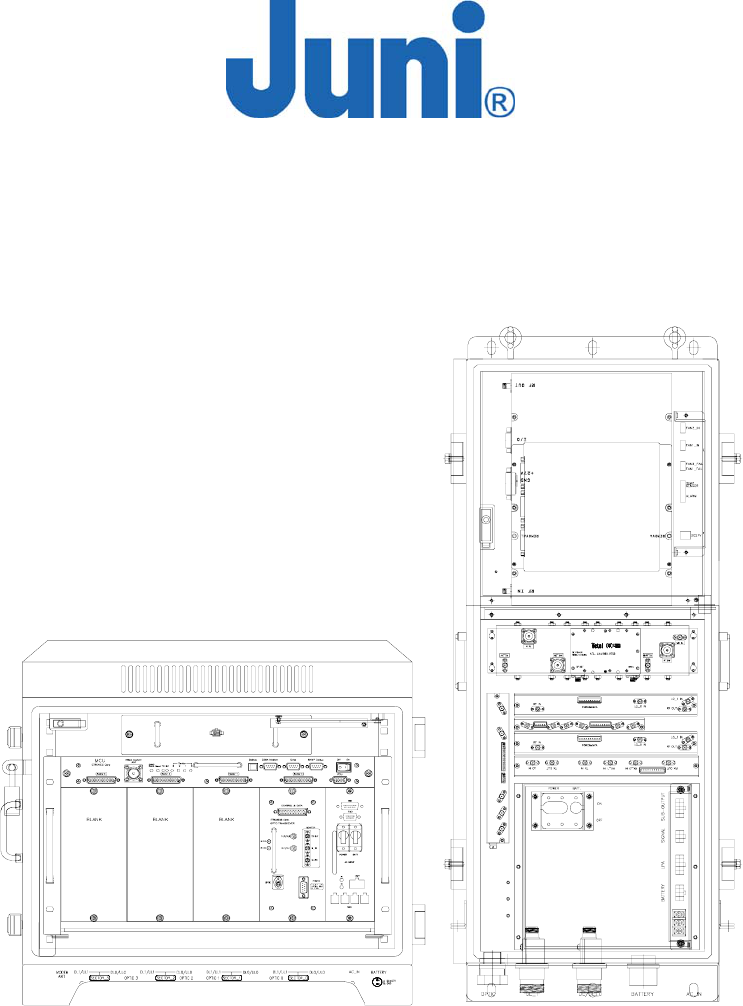
JF43
Fiber Fed Repeater
RX IN 26 0 IN
NMS520 OUT NMS
22 0 OUT TX OUT
OPERATIONS MANUAL
Version 1.17
September 2005
© Juni America Inc.

JUNI JF43-E1900/CFN03
CDMA FIBER FED REPEATER OPERATIONS MANUAL
Version 1.17 ⓒ J
uni America Inc. Page 2 of 88
CONTENTS
LIST OF ACRONYMS AND ABBREVIATIONS ......................................................... 5
1. INTRODUCTION ................................................................................................. 7
1.1 FIBER FED REPEATER ............................................................................................7
1.2 FFR COMPONENTS ................................................................................................8
1.3 ADVANTAGES.........................................................................................................9
1.4 KEY FEATURES ....................................................................................................10
1.5 GENERAL SAFETY PRECAUTIONS .........................................................................11
2. SYSTEM DESCRIPTION................................................................................... 13
2.1 FFR SYSTEM .......................................................................................................13
2.2 DONOR UNIT ........................................................................................................13
2.2.1 Donor Hub Unit Enclosure and Shelf.......................................................14
2.3 REMOTE UNIT ......................................................................................................17
2.3.1 Remote Unit.............................................................................................17
2.3.2 Remote Unit Connectors .........................................................................19
2.3.3 Remote Dip Switch Settings ....................................................................20
3. INSTALLATION ................................................................................................. 21
3.1 TRANSPORTATION TO THE SITE.............................................................................21
3.2 HANDLING OF THE REPEATER...............................................................................21
3.3 INSTALLATION CONDITIONS ..................................................................................21
3.4 INSPECTION BEFORE INSTALLING THE REPEATER ..................................................22
3.5 JF43 FFR INSTALLATION PROCEDURE .................................................................22
3.5.1 Tools and Materials..................................................................................22
3.5.2 Cautions during Installation .....................................................................23
3.5.3 Optical Fiber Jumper Cable Assembly.....................................................23
3.5.4 Weatherproofing Connectors...................................................................24
3.5.5 Donor Unit Eye Bolts ...............................................................................25
3.5.6 Donor Unit Standard Wall Mount Guide...................................................26

JUNI JF43-E1900/CFN03
CDMA FIBER FED REPEATER OPERATIONS MANUAL
Version 1.17 ⓒ J
uni America Inc. Page 3 of 88
3.5.7 Donor Hub Unit Commissioning and Provisioning...................................27
3.5.8 Remote Unit Eye Bolts.............................................................................29
3.5.9 Remote Unit Standard Wall Mount Guide................................................29
3.5.10 LVAC Cables and Connectors Installation Guide ....................................31
3.5.11 Remote Unit External Powering Configuration (Optional) .......................31
3.5.12 Remote Unit Commissioning and Provisioning........................................33
3.5.13 Operations Tests......................................................................................35
3.5.13.1 Optic Cable Loss Test............................................................................................ 35
3.5.14 Setup Procedure for DL/UL Path Gain ....................................................36
3.5.14.1 Setup for UL Gain .................................................................................................. 36
3.5.14.2 Setup for DL Gain .................................................................................................. 37
3.5.14.3 Caution Items......................................................................................................... 38
3.6 REPLACEMENT OF FAULTY UNITS .........................................................................39
3.6.1 Remote/Donor Unit Replacement............................................................39
3.6.2 Optical Module Replacement...................................................................39
3.7 STORAGE OF THE REPEATER ................................................................................40
3.8 SAFETY PRECAUTIONS.........................................................................................40
4. OPERATION...................................................................................................... 41
4.1 INTRODUCTION.....................................................................................................41
4.2 LMT OPERATION (LOCAL MAINTENANCE TERMINAL) ............................................41
4.2.1 Introduction..............................................................................................41
4.2.2 Screen Description ..................................................................................41
4.2.3 Communication Settings..........................................................................44
4.2.4 Repeater Setup........................................................................................44
4.2.5 Offset Calibration.....................................................................................45
4.2.6 Repeater Status Monitoring and Control..................................................46
4.2.6.1 Donor Unit Window.................................................................................................... 47
4.2.6.2 Remote Window ........................................................................................................ 50
4.2.6.3 Repeater Settings Setup ........................................................................................... 53

JUNI JF43-E1900/CFN03
CDMA FIBER FED REPEATER OPERATIONS MANUAL
Version 1.17 ⓒ J
uni America Inc. Page 4 of 88
4.2.7 Repeater Download.................................................................................54
4.3 SNMP OPERATION ..............................................................................................57
4.3.1 Introduction..............................................................................................57
4.3.2 Connection Setup for PC to Donor Unit MCU (Master Control Unit) .......57
4.3.3 View and Change SNMP Destination IP..................................................62
4.3.4 Downloading SNMP History Log..............................................................64
4.3.5 Reading and Understanding the SNMP History Log................................66
5. SYSTEM MAINTENANCE................................................................................. 68
5.1 PERIODIC MAINTENANCE......................................................................................68
5.1.1 Donor Unit Fan Maintenance...................................................................68
5.1.2 Remote Unit Fan Maintenance................................................................69
5.2 FAULT DETECTION AND ALARM REPORTING ..........................................................69
5.3 TROUBLE SHOOTING FOR THE DONOR UNIT..........................................................76
5.4 TROUBLE SHOOTING FOR THE REMOTE UNIT ........................................................77
7. SYSTEM MAINTENANCE................................................................................. 79
APPENDIX A. JF-43 MECHANICS.......................................................................... 80
1. DONOR UNIT ........................................................................................................80
2. REMOTE UNIT ......................................................................................................83
APPENDIX B. BLOCK DIAGRAM........................................................................... 85
APPENDIX C. LVAC CABLES AND CONNECTORS INSTALLATION GUIDE
(CORNING GILBERT) ............................................................................................. 88

JUNI JF43-E1900/CFN03
CDMA FIBER FED REPEATER OPERATIONS MANUAL
Version 1.17 ⓒ J
uni America Inc. Page 5 of 88
List of Acronyms and Abbreviations
The acronyms and abbreviations used in this manual are shown in the following list.
AC Alternating Current
AMP Amplifier
ATT Attenuator/Attenuation
BPF Band Pass Filter
BTS Base Transceiver System
C Centigrade
CATV Cable TV
CDMA Code Division Multiple Access
COM Common
Config Configuration
DC Direct Current
DHU Donor Hub Unit
DL Downlink
DOC Donor Optic Cavity
EMS Element Management System
EVDO Evolution Data Only
FFR Fiber Fed Repeater
FRPS Ferro Resonant Power Supply
FSK Frequency Shift Keying
FTP File Transfer Protocol
FWD Forward
HPA High Power Amplifier
IP Internet Protocol
JF43 Juni Fiber Repeater 43dBm
LD Laser Diode
LED Light Emitting Diode

JUNI JF43-E1900/CFN03
CDMA FIBER FED REPEATER OPERATIONS MANUAL
Version 1.17 ⓒ J
uni America Inc. Page 6 of 88
LMT Local Management Terminal
LNA Low Noise Amplifier
LPA Linear Power Amplifier
LVAC Low Voltage Alternating Current
MCU Master Control Unit
MHz Megahertz
PA Power Amplifier
PC Personal Computer
PCS Personal Communications System
PD Photo Diode
PSU Power Supply Unit
REV Reverse
RF Radio Frequency
RSM Remote unit Saw Module
RU Remote Unit
Rx Receive
SAW Surface Acoustic Wave
SNMP Simple Network Management Protocol
TDR Time Domain Reflectometer
Tx Transmit
UL Uplink
USB Universal Serial Bus
VAC Voltage Alternating Current
VDC Voltage Direct Current
VSWR Voltage Standing Wave Ratio
WDM Wavelength Division Multiplexer
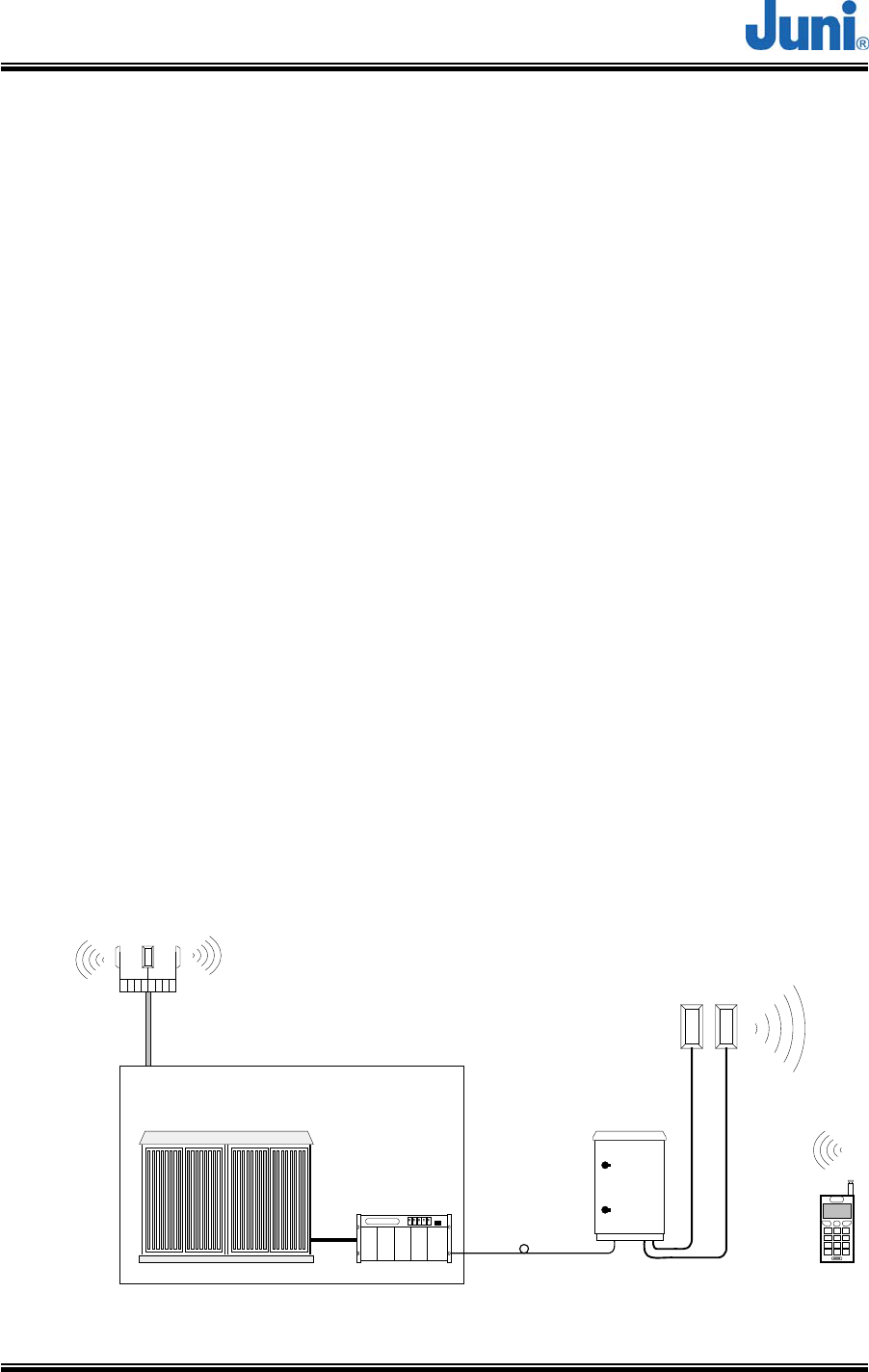
JUNI JF43-E1900/CFN03
CDMA FIBER FED REPEATER OPERATIONS MANUAL
Version 1.17 ⓒ J
uni America Inc. Page 7 of 88
1. Introduction
1.1 Fiber Fed Repeater
The JF43 FFR provides a cost effective solution for cell extension coverage and
increased call quality in shadow areas. It is a RF signal transport system that
provides long range RF coverage where it is impractical to install a BTS.
The JF43 FFR is designed to be strategically placed to overcome difficult zoning
issues by allowing the base stations to remain at a central location while placing
antennas at remote locations. RF signals can be transported to remote locations to
expand coverage into areas not receiving service or to extend coverage into difficult
to reach areas such as canyons, tunnels and underground parking lots and roadways.
The JF43 FFR provides a high-tech, highly-efficient service system which enables
high quality communication at low cost, due to the system’s utilization of one optical
fiber core between the DHU and RU supporting full duplex transmission of signals for
both the DL and UL.
Base Station
BTS
Donor
Remote
DL/UL_0
Ant.
UL_1
Ant.
Optic Link
[Figure 1.1] System Configuration
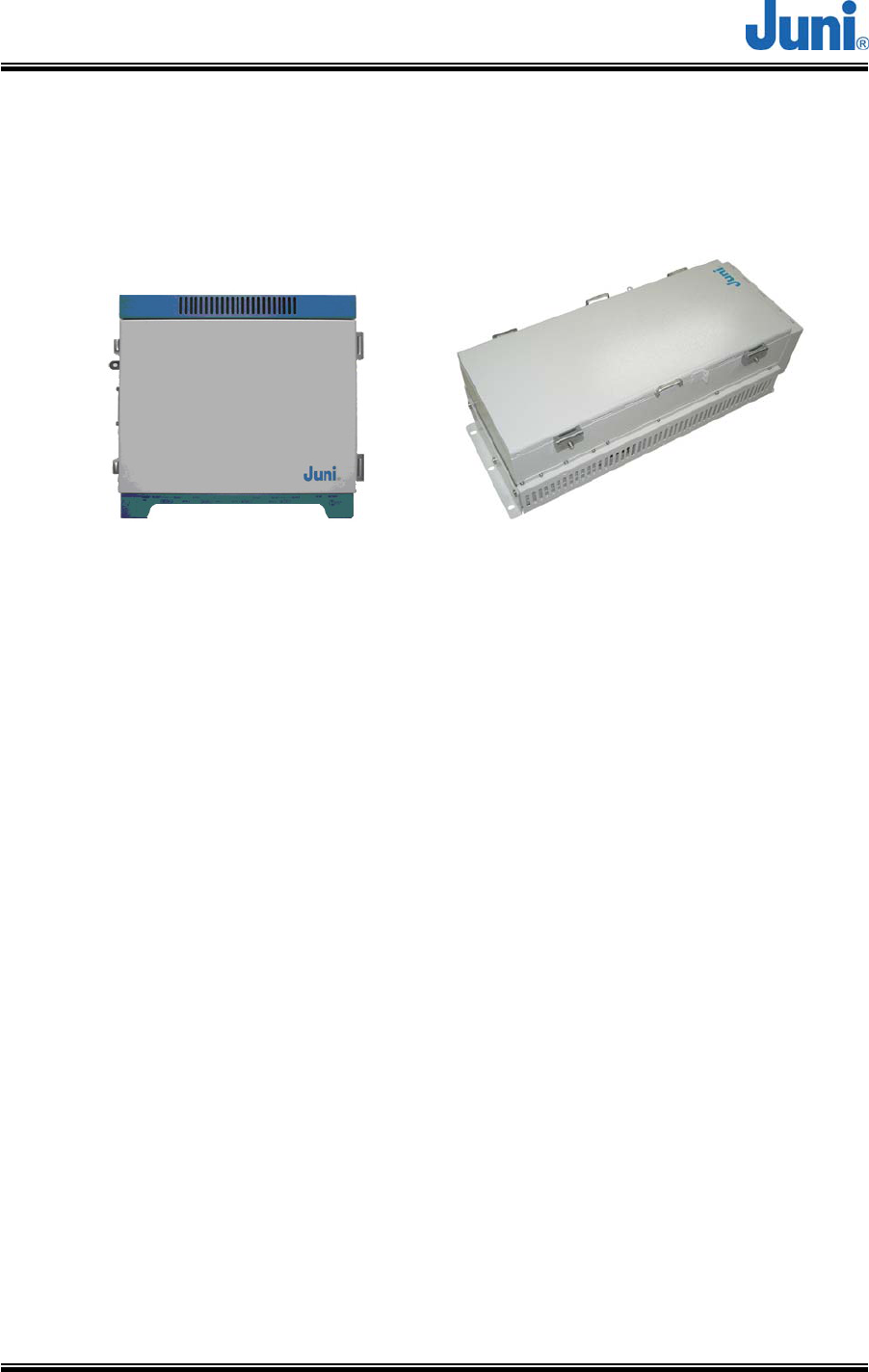
JUNI JF43-E1900/CFN03
CDMA FIBER FED REPEATER OPERATIONS MANUAL
Version 1.17 ⓒ J
uni America Inc. Page 8 of 88
1.2 FFR Components
The JF43 FFR system comprises of two main elements, a DHU and RU.
[Figure 1.2] Donor Hub Unit Enclosure [Figure 1.3] Remote Unit
The DHU Enclosure includes the following:
• Donor Optic Module
• Donor Rx Module
• Donor Tx (SAW, FSK Modem included) Module
• Local Module
• Control Module
• Wireless Modem
• Power Supply.
The RU includes the following:
• Remote Optic Module
• Remote T/Rx Module
• Remote Rx SAW Module
• Control Module
• LPA
• LNA
• Cavity BPF
• Power Supply

JUNI JF43-E1900/CFN03
CDMA FIBER FED REPEATER OPERATIONS MANUAL
Version 1.17 ⓒ J
uni America Inc. Page 9 of 88
1.3 Advantages
There are many advantages to deploying a FFR.
• Supports adjacent block interference protection which allows just one model of the
FFR to cover the entire PCS frequency range. The FFR is settable to allow a
combination of 85 different frequencies to be serviced. This advanced filtering
personality prevents interference from adjacent frequency blocks.
• Allows for versatile deployment architectures. Extra optical transceiver modules
can be added to the DHU to increase service coverage. A flexible RF splitter unit
can also be implemented to combine multiple RF ports supported by newer BTS.
• The slim and sleek appearance of the RU allows it to be installed and deployed in
difficult zoning areas.
• Its water and moisture resistant NEMA 4X structure make it reliable and durable.
• The FFR system is monitored and controlled from a central remote location by
making use of a CDMA wireless modem via the SNMP protocol.
• Operation and maintenance and repair is simple. The system provides alarms and
information on the repeater gain settings, output level control, HPA on/off, internal
temperature monitoring and problems concerning the optic module. The system is
designed to operate with a comprehensive network management system.
• The system uses only one optical fiber core for transmission and reception of
signals. To achieve this, WDM is implemented which enables multiple wave-
lengths (FWD: 1550nm, REV: 1510nm) to be simultaneously transmitted and
received through the one optical fiber core.

JUNI JF43-E1900/CFN03
CDMA FIBER FED REPEATER OPERATIONS MANUAL
Version 1.17 ⓒ J
uni America Inc. Page 10 of 88
1.4 Key Features
• Uses only 1 optical fiber core for Tx, Rx0 and Rx1
• 1xEVDO is supported
• 20 watts composite RF output
• Receive diversity is standard and provides up to 6dB reverse link benefit
• Provides lower life cycle costs by:
Reducing fiber lease costs per core
Reducing the number of optic cables required for new installations
• Most responsive and highly innovative product features
Remote unit’s standard powering is LVAC, 55 to 88 VAC
Low voltage AC powering over coax from DHU to RU
Multiple mounting options including; strand, wall, pole, floor/pedestal and
encapsulated light pole.
• High performance
• Supports simulcasting of up to 4 RU per sector
Reduced pilot pollution, better call quality, reduced soft handoff
Better network efficiency and equipment utilization
Existing base station equipment could be deployed elsewhere.
Donor RF Combiner is compatible with newer base station having multiple Tx
output RF ports. Provides Future-Proof BTS interface
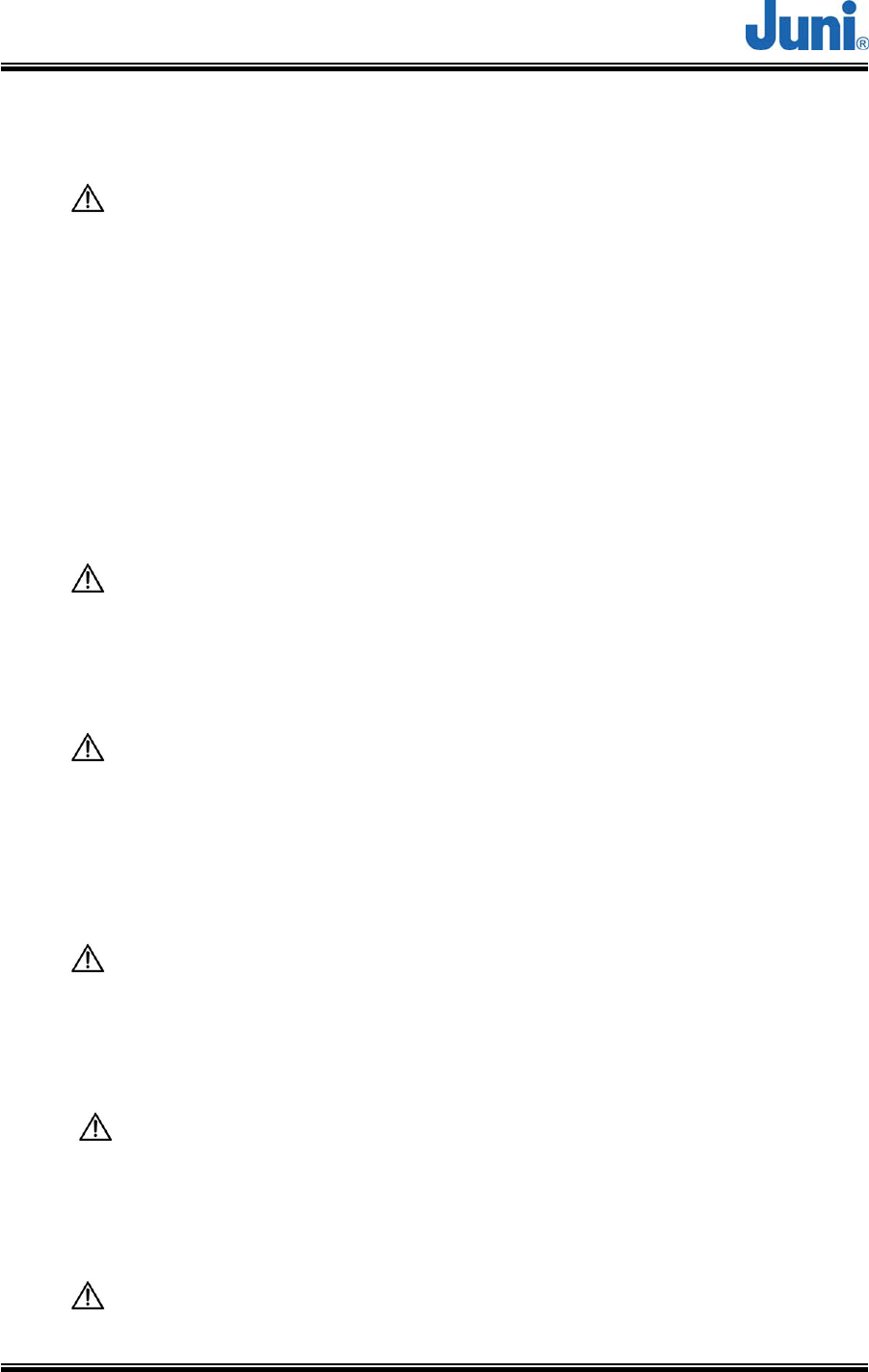
JUNI JF43-E1900/CFN03
CDMA FIBER FED REPEATER OPERATIONS MANUAL
Version 1.17 ⓒ J
uni America Inc. Page 11 of 88
1.5 General Safety Precautions
This equipment contains components that emit laser radiation which can
seriously damage the retina of the eye. Do not look into the ends of any
optical fiber. Do not look directly into the optical transceiver of any digital unit
or exposure to laser radiation may result. An optical power meter or
reflectometer should be used to verify active fibers. Place a protective cap or
lid immediately over any radiating transceiver or optical fiber connector to
avoid potential damage caused by radiation exposure. This practice also
prevents dirt particles entering the openings.
The optical fiber emits radiation. Do not look directly into the ends of an
optical fiber. This may result in exposure to radiation. Do not assume laser
power is turned off or the fiber is disconnected at the other end.
Wet locations and conditions will increase the risk of electrical shock when
installing or using electrical powered equipment. To prevent electrical shock,
never install or use electrical equipment in wet locations or during lightning
storms.
The DHU is powered by 50-88VAC. To prevent electrical shock when
installing or maintaining the DHU, disconnect the wiring at the power source
before working with un-insulated wires or terminals.
The RU is powered by 115VAC. To prevent electrical shock when installing
or maintaining the RU, disconnect the wiring at the power source before
working with un-insulated wires or terminals.
Always consider and allow sufficient fiber length to permit routing or patch

JUNI JF43-E1900/CFN03
CDMA FIBER FED REPEATER OPERATIONS MANUAL
Version 1.17 ⓒ J
uni America Inc. Page 12 of 88
cords and pigtails without severe bends. Fiber optic patch cords or pigtails
may be permanently damaged if bent or curved to a radius of less than 2
inches (50mm).
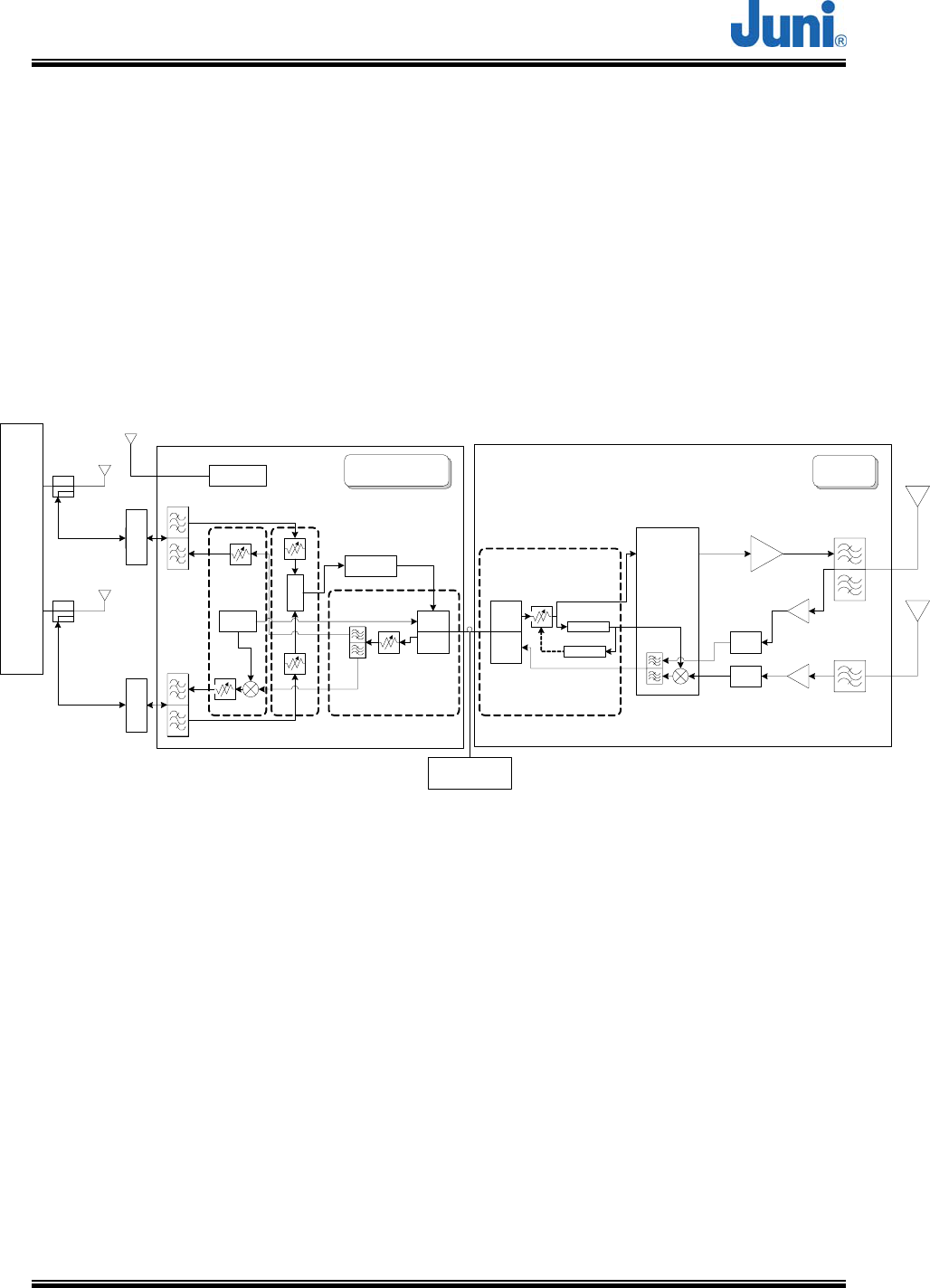
JUNI JF43-E1900/CFN03
CDMA FIBER FED REPEATER OPERATIONS MANUAL
Version 1.17 ⓒ J
uni America Inc. Page 13 of 88
2. System Description
2.1 FFR System
The JF43 FFR is made up of a main unit (DHU) and a RU. The DHU and RU are
divided into modules to allow easy operation and maintenance. It can operate even in
the harshest environmental conditions due to its durable NEMA 4X casing.
TX0/RX0
TX1/RX1
BTS
BTS Ant.
-30 or -20dB
BTS Ant.
D/C
D/C
Cable Loss
-2~-5dB
TX1
Duplexer
Optic
O/E
(LD)
E/O
(PD)
Remote
PA
LNA
LNA BPF
BPF
Optic AGC
-30 or -20dB
Duplexer
RX1
TX1
O/E
(LD)
E/O
(PD)
AGC(LD,PD)
SAW
Donor Optic Cavity
Optic cable
15 miles_max
SAW
SAW
Modem
Modem Ant.
Local
p-Det
T/RX Drive
RX
Att.
Att.
Local
Com.
TX
RX1
Optic
Combiner
(-10dB)
Combiner
(-10dB)
[Figure 2.1] System Block diagram
2.2 Donor Unit
This section describes the main components of the DHU, the functions performed by
the components and the user interface.
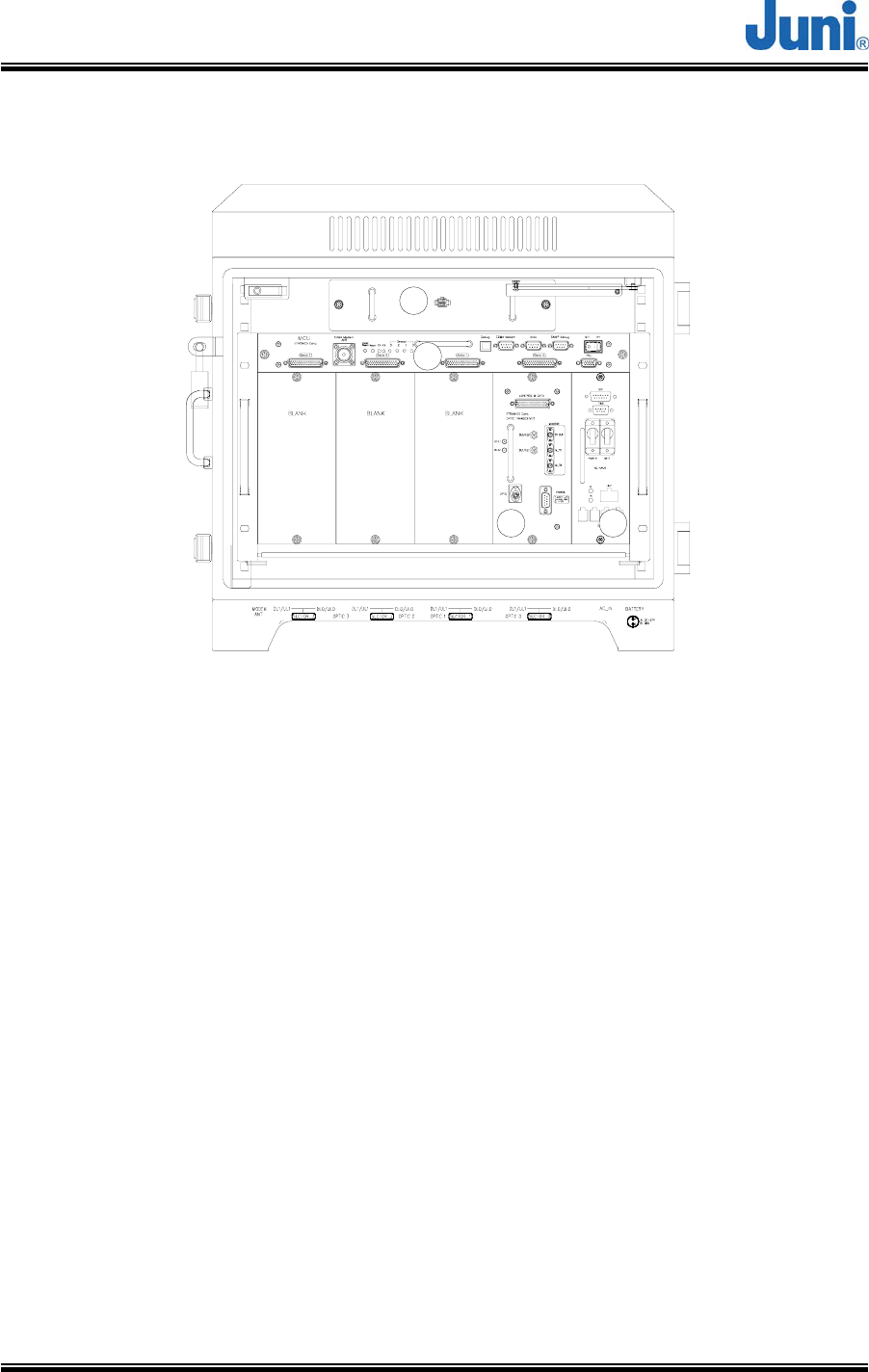
JUNI JF43-E1900/CFN03
CDMA FIBER FED REPEATER OPERATIONS MANUAL
Version 1.17 ⓒ J
uni America Inc. Page 14 of 88
2.2.1 Donor Hub Unit Enclosure and Shelf
1
2
3 4
[Figure 2.2] Main Components of the Donor Hub Unit
① FAN: Provides ventilation and disperses heat evenly.
② MCU (Master Control Unit): Monitors and controls each internal module. Also
monitors and controls the RU by data communication. Monitoring the control
and status of all repeaters can only be managed at an administrative level via
the internal SNMP agent.
③ DOC (Donor Optic Cavity): Converts the RF signal (from the BTS) into an
optical signal and transmits the signal to the RU. Conversely, the RU converts
the optic signal and transmits it to the BTS.
④ PSU (Power Supply Unit): Converts the input power AC power (115 or 230VAC)
into DC+27V, DC+15V, DC +7V and supplies the power to the modules.
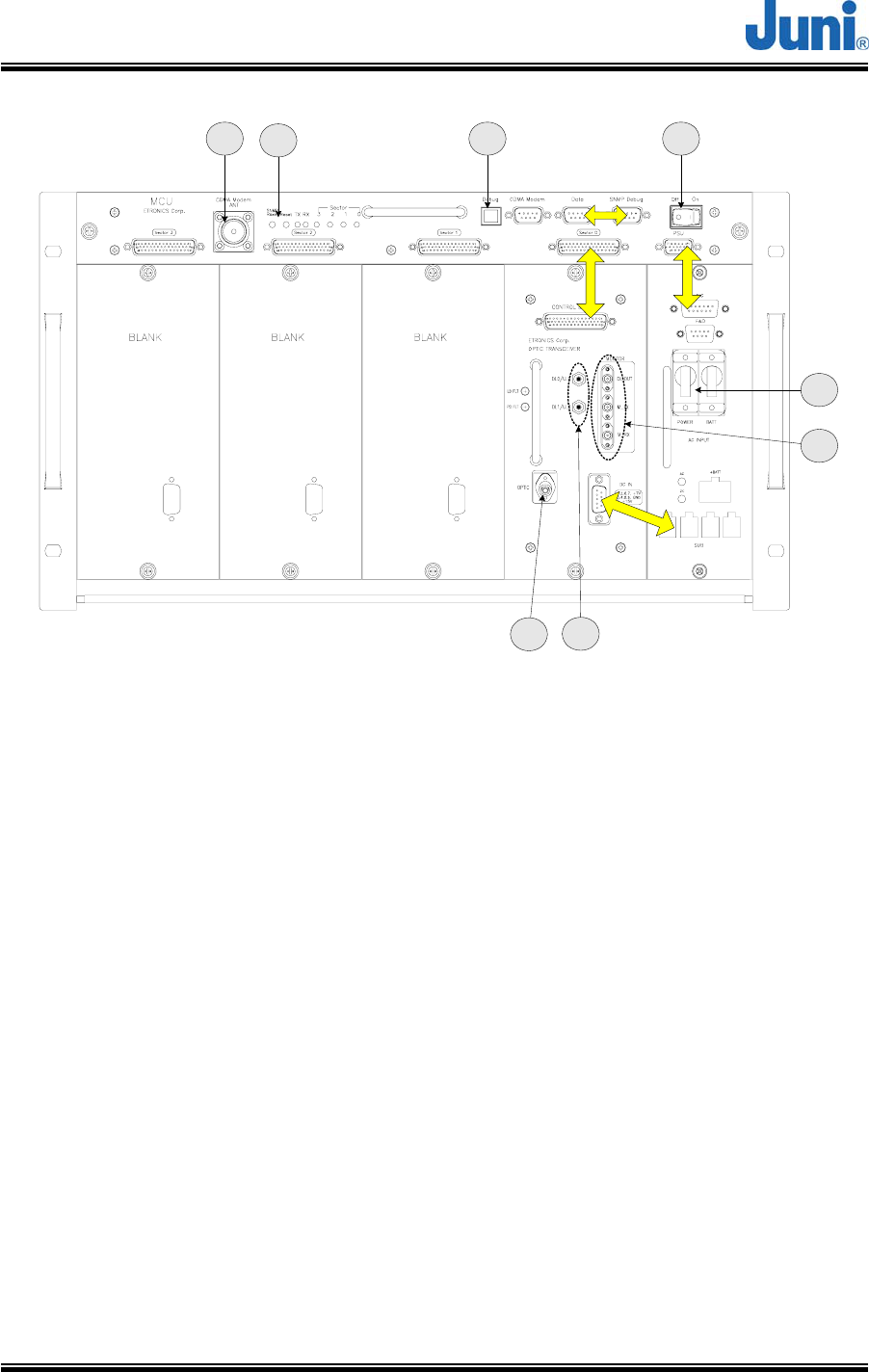
JUNI JF43-E1900/CFN03
CDMA FIBER FED REPEATER OPERATIONS MANUAL
Version 1.17 ⓒ J
uni America Inc. Page 15 of 88
5
6
31 4
7
2
8
[Figure 2.3] Donor Hub Unit Shelf Interface
① CDMA Modem RF Port (Female N-Type): An RF cable connects the CDMA
wireless modem port on the MCU to the modem RF port situated on the outside
of the enclosure.
② MCU and SNMP reset Key: Hard reset button to restart the MCU and SNMP
agent.
③ Debug port: USB port to allow connection to any PC for debugging via the GUI
and LMT.
④ MCU Power switch: Turns the power on/off for the MCU only.
⑤ Main and battery power switch: Main power switch located on the power supply
which provides power to the entire DHU.
⑥ Monitoring port (Female SMA): Ports used to monitor signals existing within the
DHU with a spectrum analyzer or test equipment.
⑦ RF in/out port: RF ports on a single optic transceiver supports only one sector.
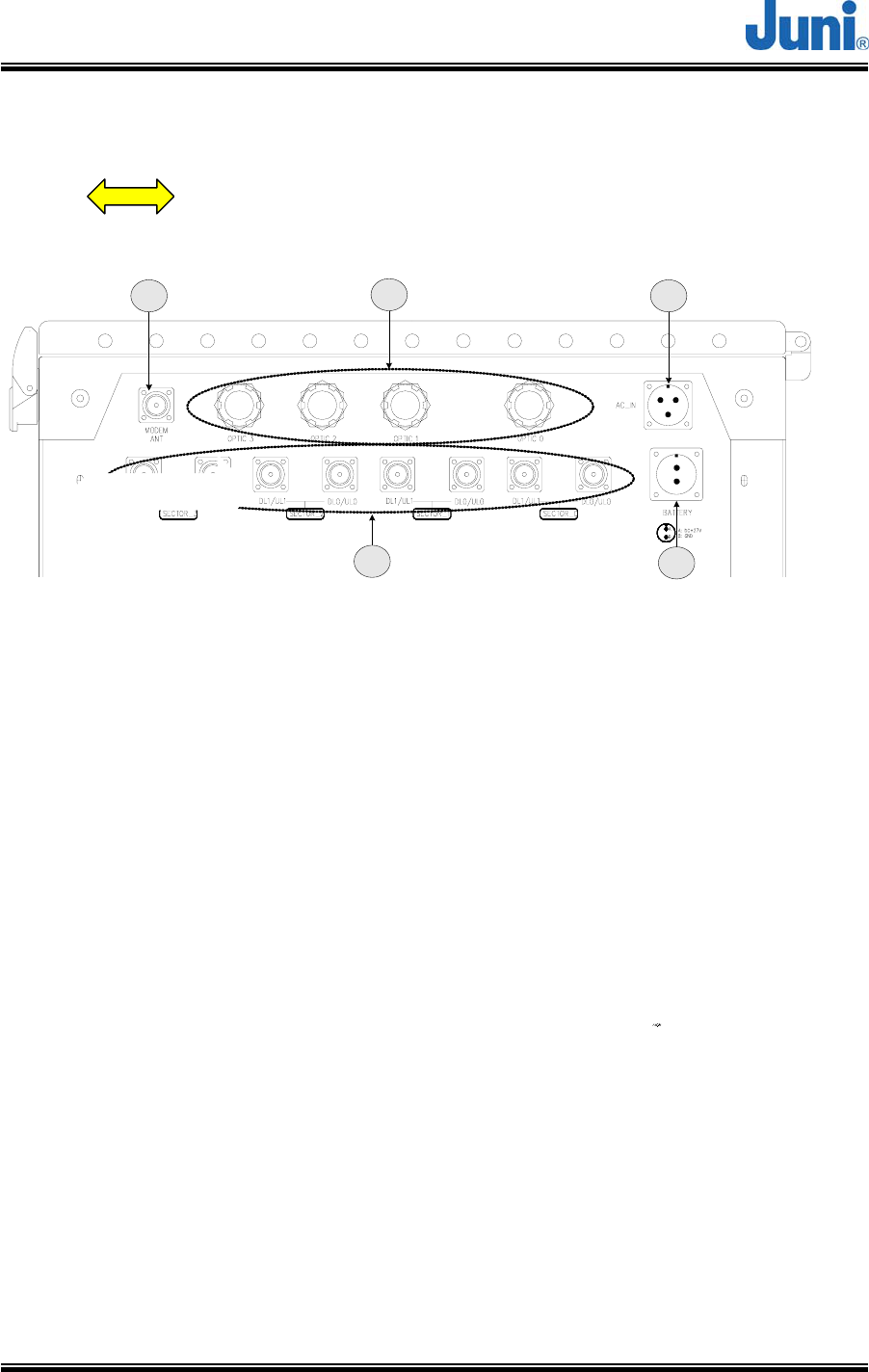
JUNI JF43-E1900/CFN03
CDMA FIBER FED REPEATER OPERATIONS MANUAL
Version 1.17 ⓒ J
uni America Inc. Page 16 of 88
This port is connected to the enclosure with RF cables.
⑧ Optic connector: Connector to where the fiber is connected to.
⑨
123
45
[Figure 2.4] Donor Hub Unit External Connectors (Bottom View)
① CDMA modem RF port (Female N-Type): External Antenna modem connected to
this port.
② Fiber Entrance: The fiber is passed through to connect to the optic transceiver.
③ AC power connector (Female weatherproof MS type): Connectors used for AC
powering. The AC power cable is supplied by the manufacturer.
④ RF in/out port (Female N type): Provides connection to the BTS.
⑤ Battery connector (Female weatherproof MS type): Connector for backup
batteries units.
: Data and power cable
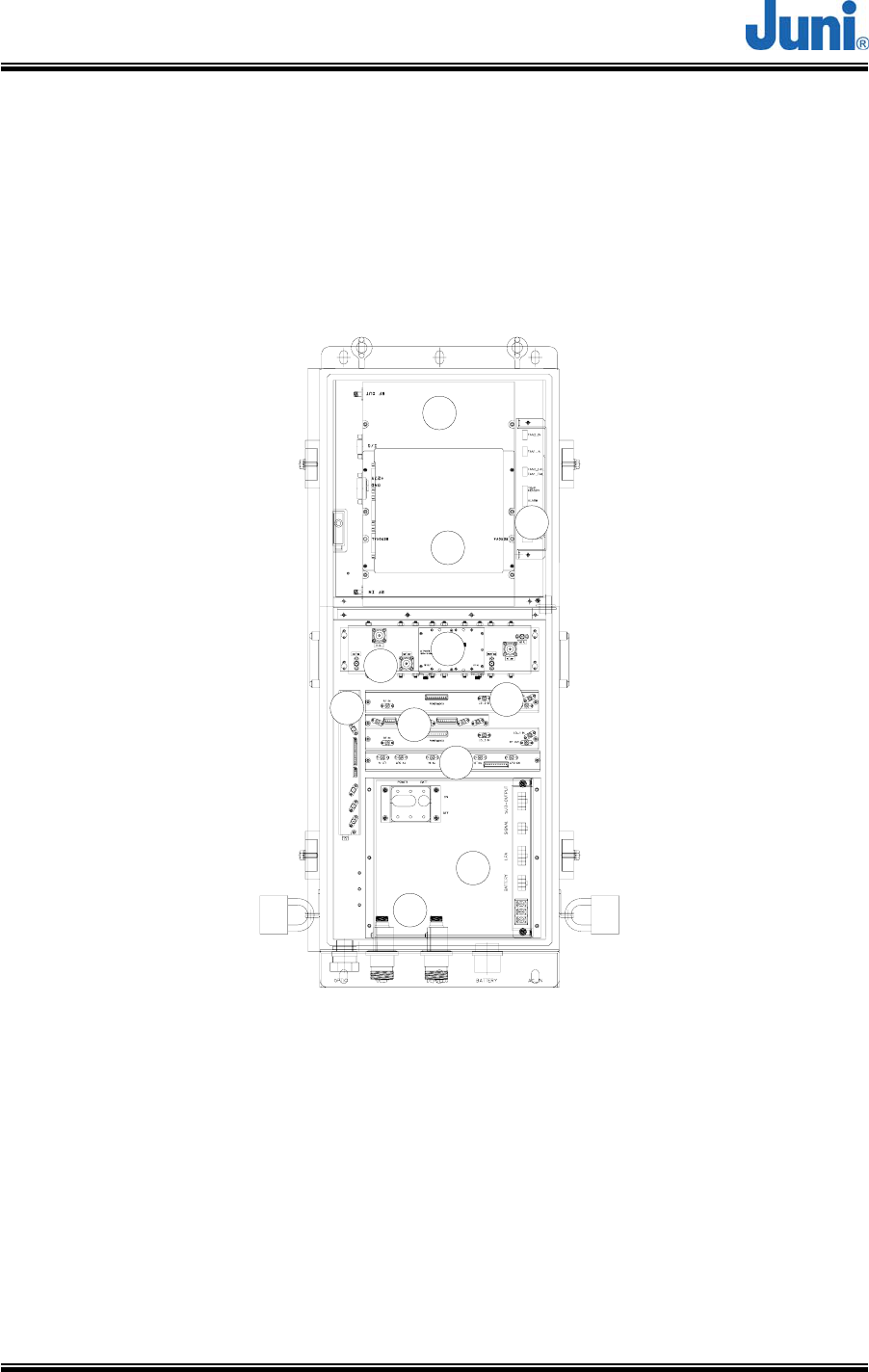
JUNI JF43-E1900/CFN03
CDMA FIBER FED REPEATER OPERATIONS MANUAL
Version 1.17 ⓒ J
uni America Inc. Page 17 of 88
2.3 Remote Unit
This section describes the main components of the RU, the functions performed by
the components and the user interface.
2.3.1 Remote Unit
RX IN 260 IN
NMS 520 OUT NMS
220 OUT TX OUT
1
2
3
45
67
8
9
11
10
[Figure 2.5] Main Components of the Remote unit
① LPA (Linear Power Amplifier): A 30Watt 6 carrier amplifier which amplifies the
signal into high output power for transmitting to the DL antenna. The amplifier is
operated by +27VDC and has a 43dB Gain.
② Control Module: Used to monitor and control the RU. Also manages the
communication with the DHU.

JUNI JF43-E1900/CFN03
CDMA FIBER FED REPEATER OPERATIONS MANUAL
Version 1.17 ⓒ J
uni America Inc. Page 18 of 88
③ FAN Controller: Turns the FAN On/Off by detecting the internal temperature of the
unit and alerting the Control module (②) the current status of the FAN .
④ Duplexer & BPF: Filters out the unwanted signals on the FWD and REV path.
⑤ Low Noise Amplifier (LNA): Performs low noise amplification on received signals.
⑥ Remote Optic Module: Converts the optic signal (from DHU) into RF signal.
Conversely, it converts the RF signal (from the RU) into an optic signal.
⑦ Remote RX SAW Module: Uses the SAW Filter to eliminate all unwanted signals
from the selected frequency and reduces the interference caused by out of band
signals.
⑧ Remote Local Module: Generates and provides the local signal required for RU
RX SAW Module (⑦).
⑨ Remote TX Drive Module: Amplifies the Forward signal and transmits to the LPA
(①), the signal is then amplified once again from the SAW Module(⑦) and
transmitted to the Optic Module(⑥). The reverse path performs down conversion of
the frequency to 1330 to 1390MHz for diversity functions.
⑩ Power Supply: Converts the input power (55 to 88VAC) into DC+27V, DC+15V, DC
+7V and supplies this power to the modules.
⑪ Arrestor: Protects the system against lightning surges. No external lightning
arrestors are required.
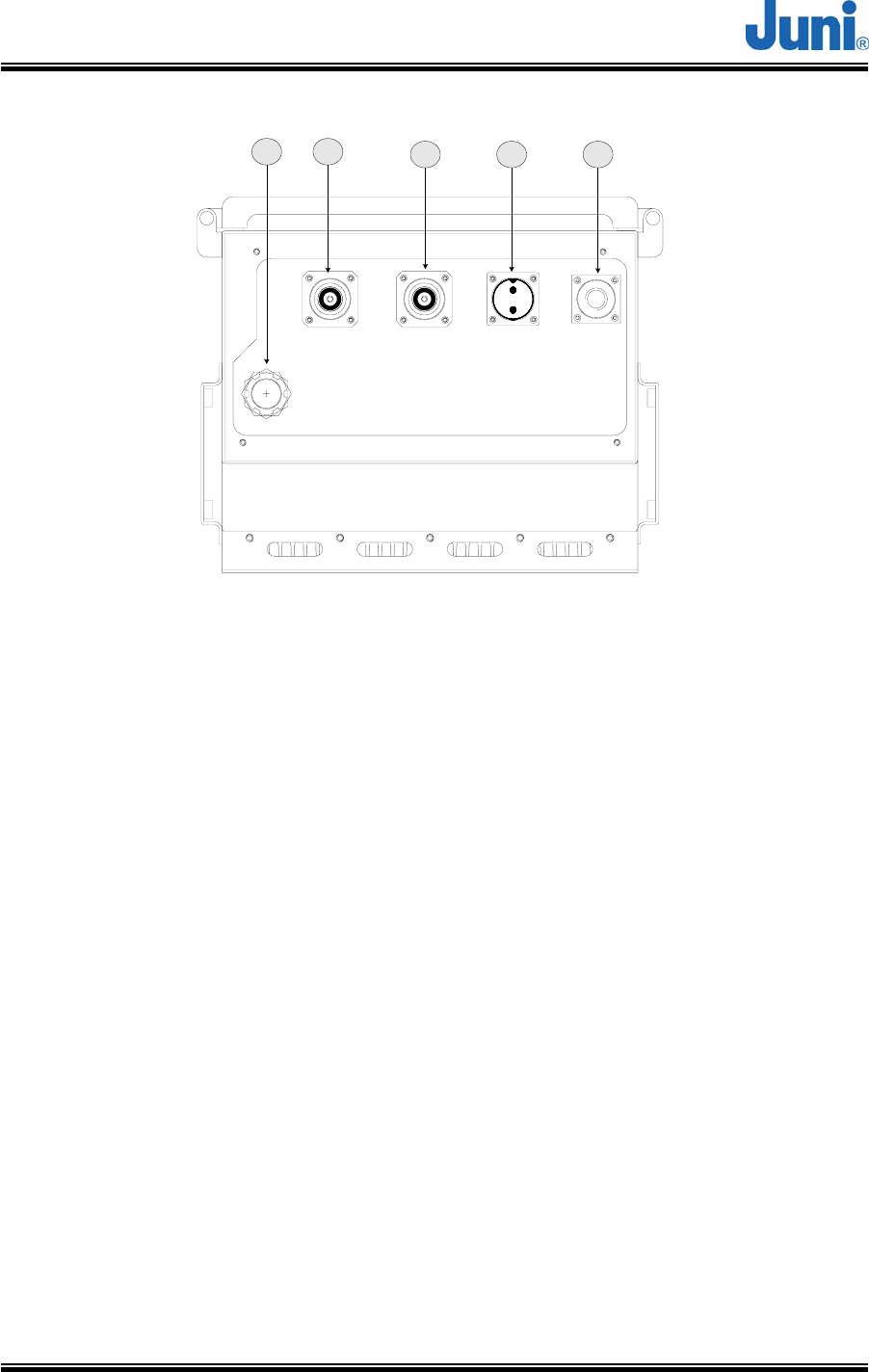
JUNI JF43-E1900/CFN03
CDMA FIBER FED REPEATER OPERATIONS MANUAL
Version 1.17 ⓒ J
uni America Inc. Page 19 of 88
2.3.2 Remote Unit Connectors
BATTERY
OPTIC
UL_1 DL/UL_0 AC_IN
1 2 345
[Figure 2.6] Connectors located on the bottom of the Remote Unit
① Fiber entrance port: A non metallic liquid tight strain relief is connected to the port
with a fiber core fed through the center into the RU.
② UL1 path input port: Female DIN type Diversity uplink/receive path port to connect
a second antenna
③ DL/UL0 path in/out port: Female DIN type DL/UL path port making use of a single
fiber core for full duplex operation. An antenna is connected to this port to transmit
and receive signals.
④ Battery connector: Weatherproof 2 pin MS connector used to connect an external
battery backup unit.
⑤ AC power connector: Female AC power connector to allow connection for a male
Gilbert AC power connector and CATV AC power feeder cable.
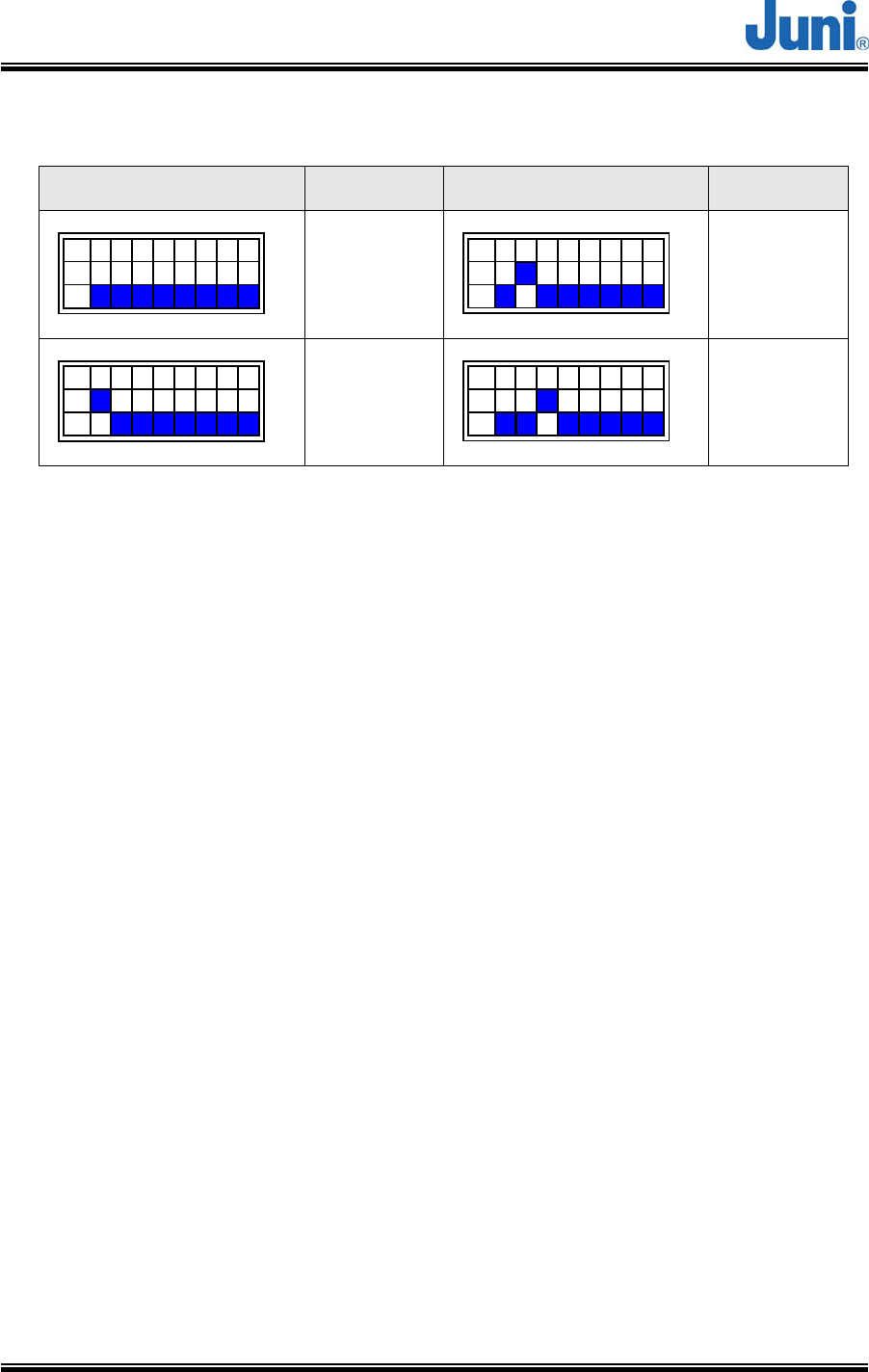
JUNI JF43-E1900/CFN03
CDMA FIBER FED REPEATER OPERATIONS MANUAL
Version 1.17 ⓒ J
uni America Inc. Page 20 of 88
2.3.3 Remote Dip Switch Settings
DIP SWITCH SECTOR DIP SWITCH SECTOR
ON
OFF
12345678
1 ON
OFF
12345678
3
ON
OFF
12345678
2 ON
OFF
12345678
4
[Table 2.1] Dip switch on the Control Unit of the Remote unit
The dip switch located on the control unit of the RU is set accordingly to the
required sector it must service. A DHU can support a maximum of four
remotes which allows the single DHU located at the BTS to service up to four
sectors.

JUNI JF43-E1900/CFN03
CDMA FIBER FED REPEATER OPERATIONS MANUAL
Version 1.17 ⓒ J
uni America Inc. Page 21 of 88
3. Installation
3.1 Transportation to the Site
During transportation of the repeater to the site, the following points need to be
considered.
• While transporting the repeater unit, it is advised to pack the repeater in its
original packaging supplied by Juni America.
• It is important to prevent any shock applied to the repeater units while
loading/unloading to/from the vehicle.
• During transportation, it is advised to prevent or minimize any movement of the
packed repeater units.
3.2 Handling of the Repeater
The user should prevent any defect caused by an accident, misuse, abuse, insect
infestations, “Acts of God”, improper installation or operation, lack of reasonable care,
unauthorized modification, and loss of parts, tampering or any repair by a person not
authorized by Juni America. As the JF43 repeater is heavy equipment, the installer
should be careful and seek assistance while attempting to lift/carry/move the units.
3.3 Installation Conditions
• Avoid direct sunlight and place the repeater in a well ventilated location.
• The environment temperature should be in a range of –20°C ∼ +55°C.
• Ground connections should be made to all metal cabinets for safety.
• Avoid any vibration.
• The VSWR of the cable which connects the repeater to the antenna should be less
than 1:1.5

JUNI JF43-E1900/CFN03
CDMA FIBER FED REPEATER OPERATIONS MANUAL
Version 1.17 ⓒ J
uni America Inc. Page 22 of 88
3.4 Inspection before Installing the Repeater
• Check if there is any physical damage on the repeater cabinet. If any damage is
found, it is advised to perform close inspection on the operating features and RF
signal test to verify repeater performance.
• Check for loose RF cables inside the repeater.
• Check whether any part of the cabinet is exposed to water or other liquid substances.
• Before installing the repeater, check the serial number of the units to be installed.
• Check all required accessories are available.
3.5 JF43 FFR Installation Procedure
3.5.1 Tools and Materials
The following tools and materials are required in order to complete the procedures in
the installation process. The installation processes include RF testing and mechanical
installation.
• Portable RF spectrum analyzer or RF power meter
• RF Signal generator
• AC/DC voltmeter
• RF adaptors
• External attenuators
• RF test cables
• PC with Local Maintenance Terminal (LMT) software installed
• USB-A to USB-B interface cable
• 99% pure alcohol
• Contraction tubes
• Optical TDR (Time Domain Reflectometer)
• Wireless terminal
• Pencil or pen
• Writing pad

JUNI JF43-E1900/CFN03
CDMA FIBER FED REPEATER OPERATIONS MANUAL
Version 1.17 ⓒ J
uni America Inc. Page 23 of 88
3.5.2 Cautions during Installation
1. Caution when connecting the optic cable:
● Clean the connection part of connector using an industrial tissue and 99.9% pure
alcohol.
● After connecting the optic jumper cable, the residual section should be set in a
large circular form to prevent it from folding.
2. Caution when setting the repeater :
● Do not power on the system while the output port of the system is not connected.
● Before connecting the DHU input from the BTS, measure and confirm the DHU
input level is within the DHU input dynamic range.
● Confirm the connections of the cables and connectors are tight.
● Confirm the ground connection complies with the safety specifications for
protection against thunderstorms.
3.5.3 Optical Fiber Jumper Cable Assembly
An Optical Fiber Jumper Cable assembly is available from Juni America, Inc. to
facilitate connection from a single-mode optical fiber transmission facility (dark fiber)
to the DHU or RU. The Optical Fiber Jumper Cable assembly is shown in the figure
below. It has an overall length of approximately 100 feet. It includes a weatherproof
“boot” assembly which serves to seal the circular opening (in the DHU or RU), where
the optical fiber jumper cable enters and connects to the FFR subsystem, via the
FC/APC connector provided.
Only one optical fiber core is required for the optical fiber connection between the
DHU and RU, and a second optical fiber core is provided within the jumper cable
assembly as a “spare”. Should one of the fiber cores fail, ensure the system is turned
off by following the “Replacement of faulty units” section. Unplug the problematic fiber
core from the DHU and RU and plug the spare jumper cable into the unit. This will
only work provided the spare fiber is functioning.
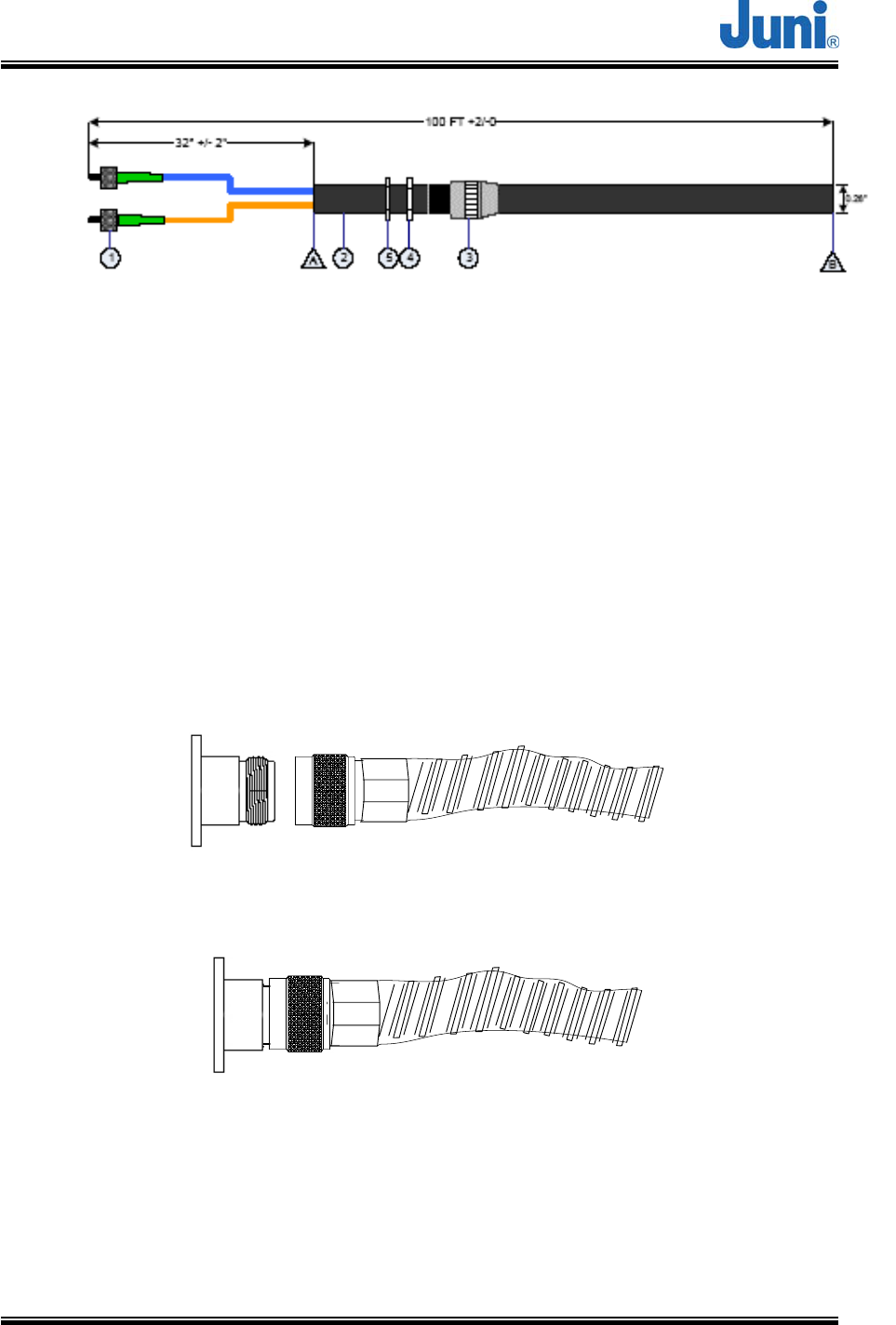
JUNI JF43-E1900/CFN03
CDMA FIBER FED REPEATER OPERATIONS MANUAL
Version 1.17 ⓒ J
uni America Inc. Page 24 of 88
[Figure 3.1] Optical Fiber Jumper Cable
3.5.4 Weatherproofing Connectors
Once all connectors and cables have been configured and assembled,
weatherproofing is vital to prevent corrosion due to water ingress which could lead to
eventual failure.
1. Making sure that the connector surfaces are clear of residue and dry, firmly
tighten the connectors.
[Figure 3.2] Connect cable to connector
[Figure 3.3] Fasten cable to connector
2. Seal the connector assembly by tightly wrapping Butyl tape over the connection.
Two or more layers should be used so that the tape seals the entire connection
and extends beyond the connector by about an inch.
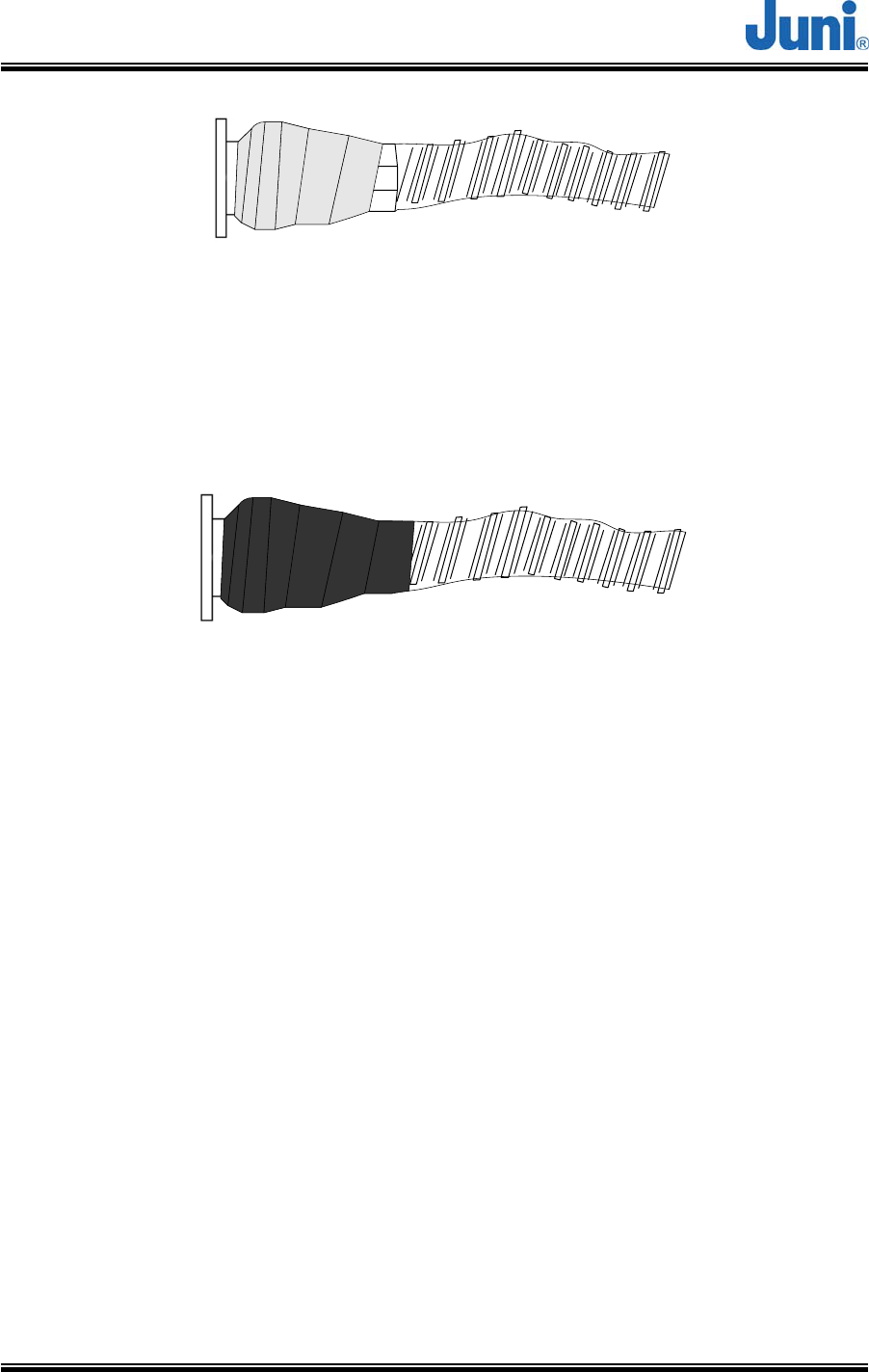
JUNI JF43-E1900/CFN03
CDMA FIBER FED REPEATER OPERATIONS MANUAL
Version 1.17 ⓒ J
uni America Inc. Page 25 of 88
[Figure 3.4] Wrap connection with Butyl tape
3. Tightly wrap electrical tape around the existing Butyl tape making sure to also
extend one inch beyond the Butyl tape to completely envelop the tape and
connector.
[Figure 3.5] Wrap over Butyl tape with electric tape
3.5.5 Donor Unit Eye Bolts
There are four captive eye bolt tapped holes located at the top of the DHU as shown
below. The length of the tapped hole is 0.97 inches or 25mm. The customer supplied
¼” 20UNC eye bolts may be used to assist in hoisting the DHU above the ground for
wall or pole mount solutions.
Ensure that the eyebolts are securely attached to the top of the DHU. Check that the
cables used to lift the DHU is securely fastened to the eyebolts before it is lifted.
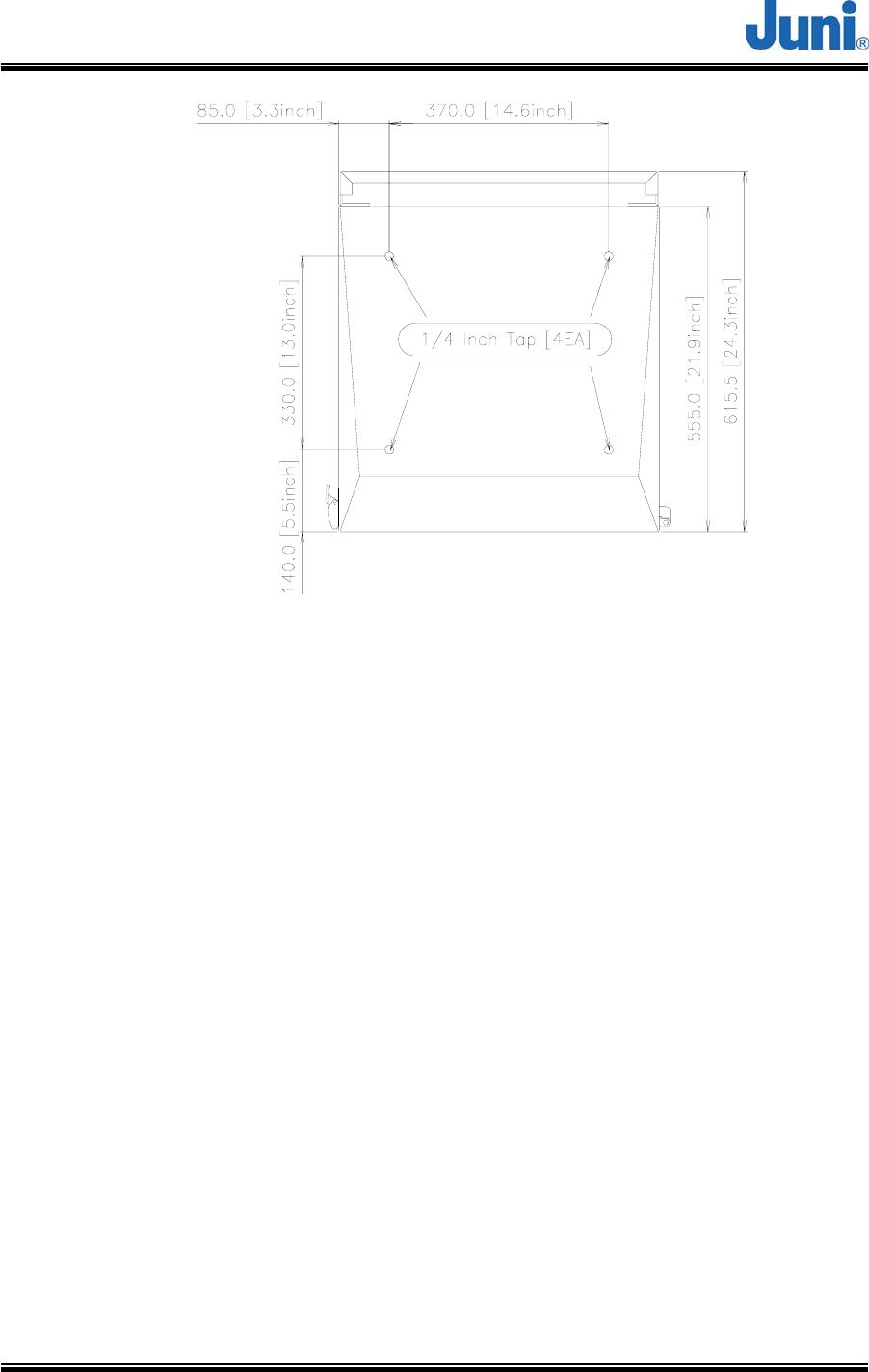
JUNI JF43-E1900/CFN03
CDMA FIBER FED REPEATER OPERATIONS MANUAL
Version 1.17 ⓒ J
uni America Inc. Page 26 of 88
[Figure 3.6] Donor Unit Eye Bolt Patterns
3.5.6 Donor Unit Standard Wall Mount Guide
The DHU is capable of being wall mounted. There are two horizontal panels
protruding slightly behind the DHU, with holes along the panel to allow bolts and nuts
to be fastened. The wall mount holes will accommodate bolt diameters up to a
maximum of 0.4 inches. Drill holes in the wall or area in which it is to be installed to
match the mounting holes on the panels.
Attach the DHU to the wall using the appropriate fastening method.
The figure below displays the positioning and size of the wall mount holes.
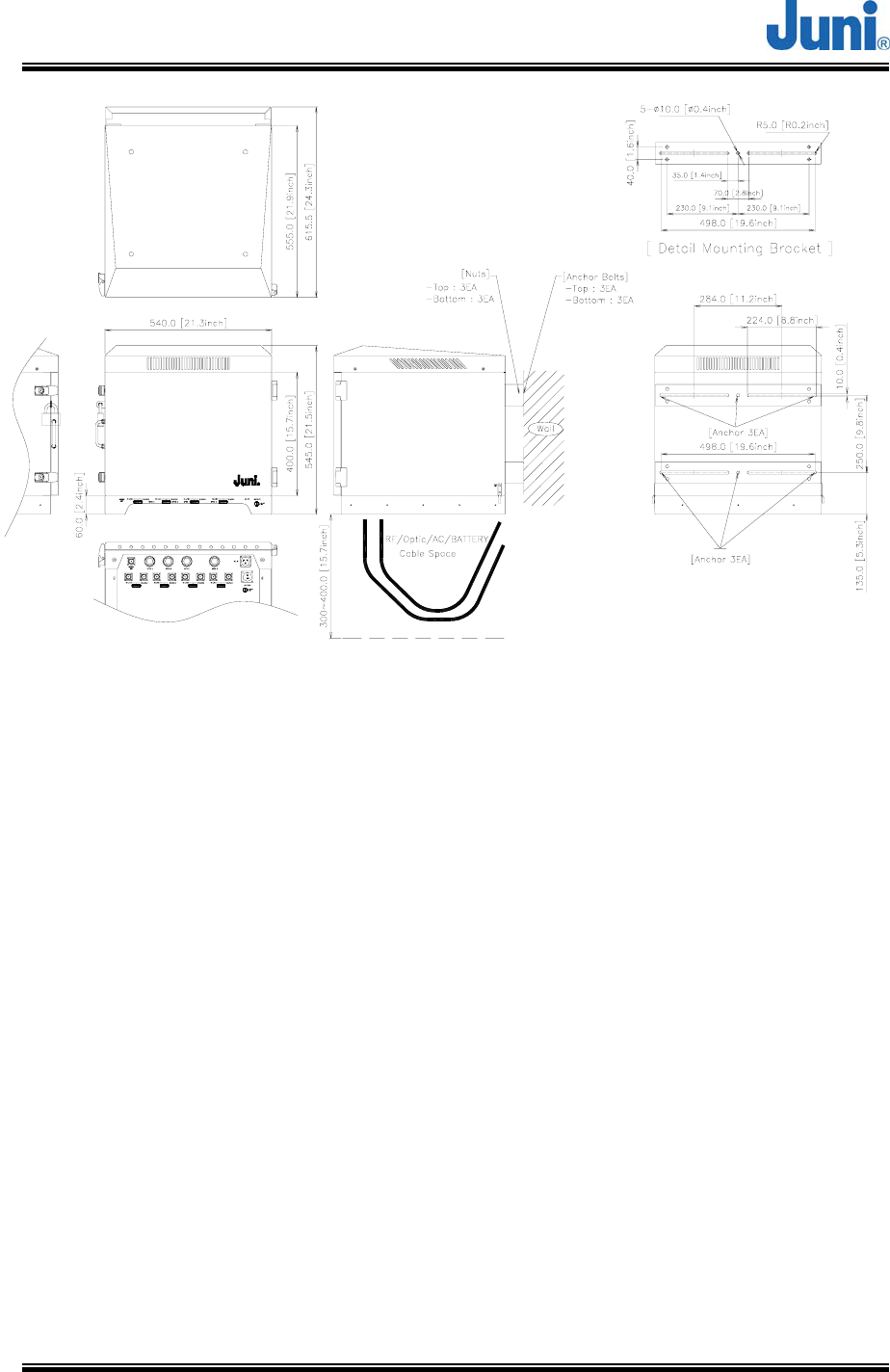
JUNI JF43-E1900/CFN03
CDMA FIBER FED REPEATER OPERATIONS MANUAL
Version 1.17 ⓒ J
uni America Inc. Page 27 of 88
[Figure 3.7] Donor Hub Unit Wall Mounting
3.5.7 Donor Hub Unit Commissioning and Provisioning
1. Verify that the power is switched OFF.
2. Before any other connections are made, ensure that the ground terminal on the DHU
cabinet has been connected to the common ground of the installation site, as
described in the previous section.
3. Using a DC voltmeter, verify that the DC voltage level at the power terminals is a
nominal ±24 VDC. The DC power provided to the Donor can be either polarity.
4. Connect a customer-supplied power cable to the DHU Enclosure.
5. Connect a customer-supplied AC power cable to the front of the DHU power supply
when the DHU enclosure is not used.
6. Connect a customer-supplied Optical Fiber cable to the Optic port of the DHU, inside
the Enclosure.
7. Connect a customer supplied modem antenna to the RF modem port on the bottom
of the DHU unit.
8. Turn the power on with the main switch located on the PSU and then power on the
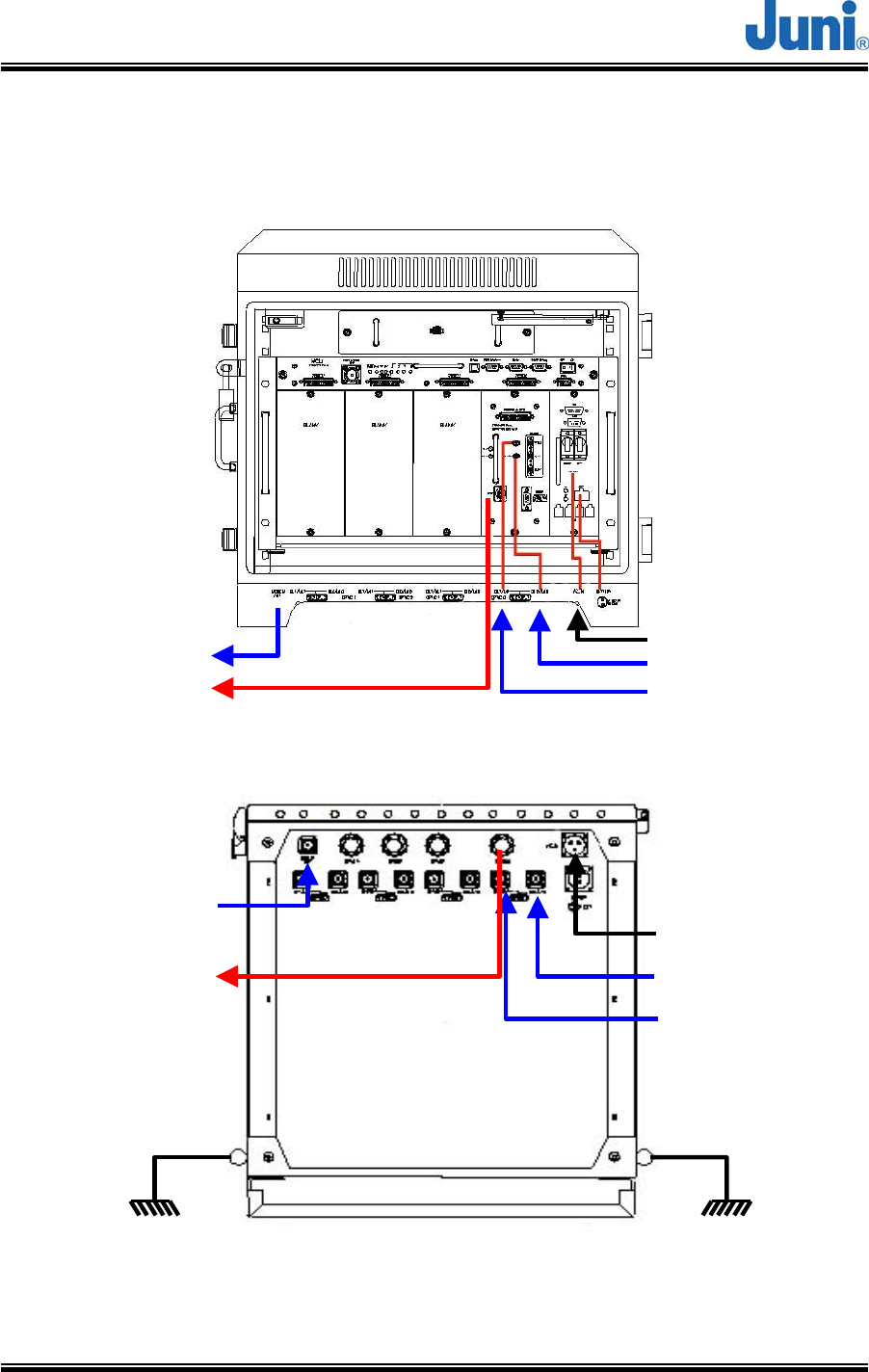
JUNI JF43-E1900/CFN03
CDMA FIBER FED REPEATER OPERATIONS MANUAL
Version 1.17 ⓒ J
uni America Inc. Page 28 of 88
MCU.
9. Connect a PC to the MCU’s debug port with a USB cable. Load the LMT (Local
Maintenance Terminal) software to check the status and settings of the DHU.
[Figure 3.8] Front View Cable connections on the Donor Hub Unit
[Figure 3.9] Cable connections on the Donor Hub Unit
Fiber Optic Output DL1/UL1 RF Input from BTS
DL0/UL0 RF input from BTS
AC Input (55-88VAC)
Modem Antenna
Connection
Fiber Optic Cable
Passed Through
DL1/UL1 RF Port from BTS
DL0/UL0 RF Port from BTS
AC Input (55-88VAC)
Modem Antenna
Connection
AC Input (55-88VAC) AC Input (55-88VAC)
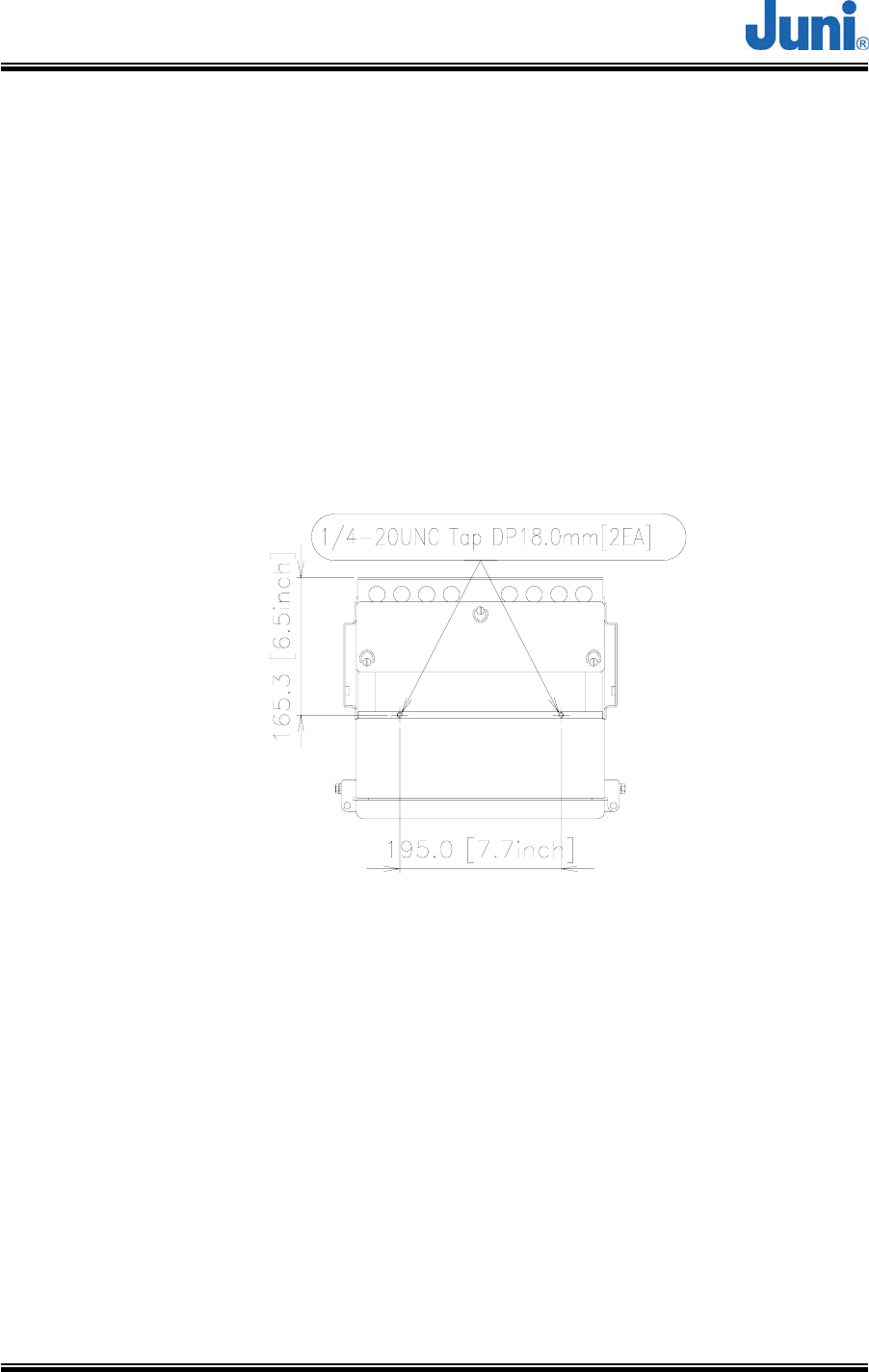
JUNI JF43-E1900/CFN03
CDMA FIBER FED REPEATER OPERATIONS MANUAL
Version 1.17 ⓒ J
uni America Inc. Page 29 of 88
3.5.8 Remote Unit Eye Bolts
There are two captive eye bolt tapped holes located at the top of the RU which is
located next to the fan compartment. The length of the tapped hole is 0.7 inches or
18mm. The customer supplied ¼” 20UNC eye bolts may be used to assist in hoisting
the RU above the ground for wall or pole mount solutions.
Prior to using the eyebolts, ensure that the three eyebolts are securely attached to the
top of the RU. Check that the cables used to lift the DHU is securely fastened to the
eyebolts before it is lifted.
[Figure 3.10] Remote Unit Eye Bolt Patterns
3.5.9 Remote Unit Standard Wall Mount Guide
The RU is capable of being wall mounted. There are two horizontal panels extending
from the body of the RU at the top and bottom with holes along the panel to allow
bolts and nuts to be fastened.
The wall mount holes will accommodate bolt diameters up to a maximum of 0.39
inches. Drill holes in the wall or area in which it is to be installed, to match the
mounting holes on the panels.
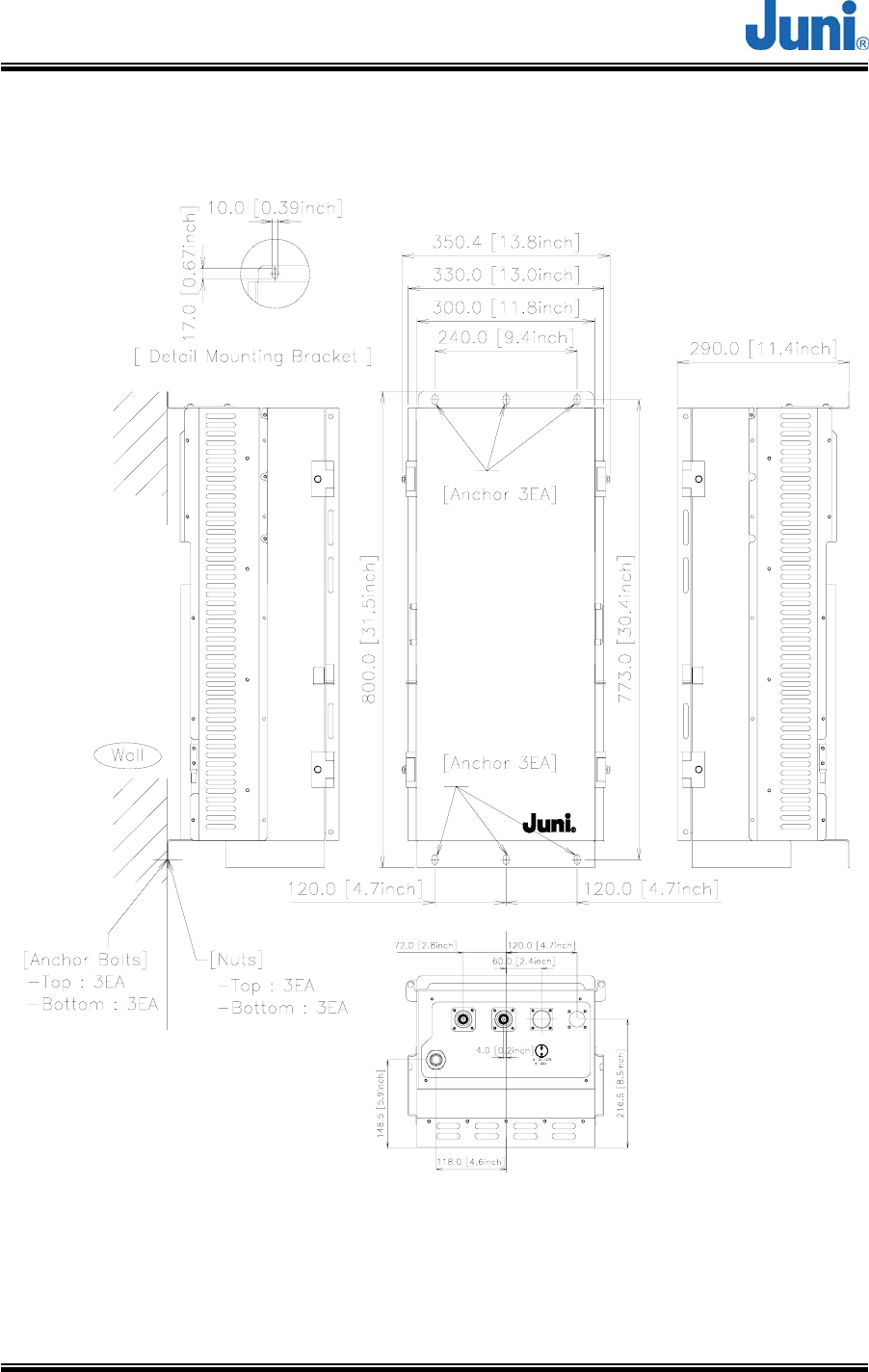
JUNI JF43-E1900/CFN03
CDMA FIBER FED REPEATER OPERATIONS MANUAL
Version 1.17 ⓒ J
uni America Inc. Page 30 of 88
Attach the RU to the wall using the appropriate fastening method.
The figure below displays the positioning and size of the wall mount holes.
DL/UL_0
OPTIC
UL_1 AC_IN
BATTERY
BATTERYOPTIC UL_1 DL/ UL_0 AC_OUTAC_IN
[Figure 3.11] Remote Unit Wall Mounting
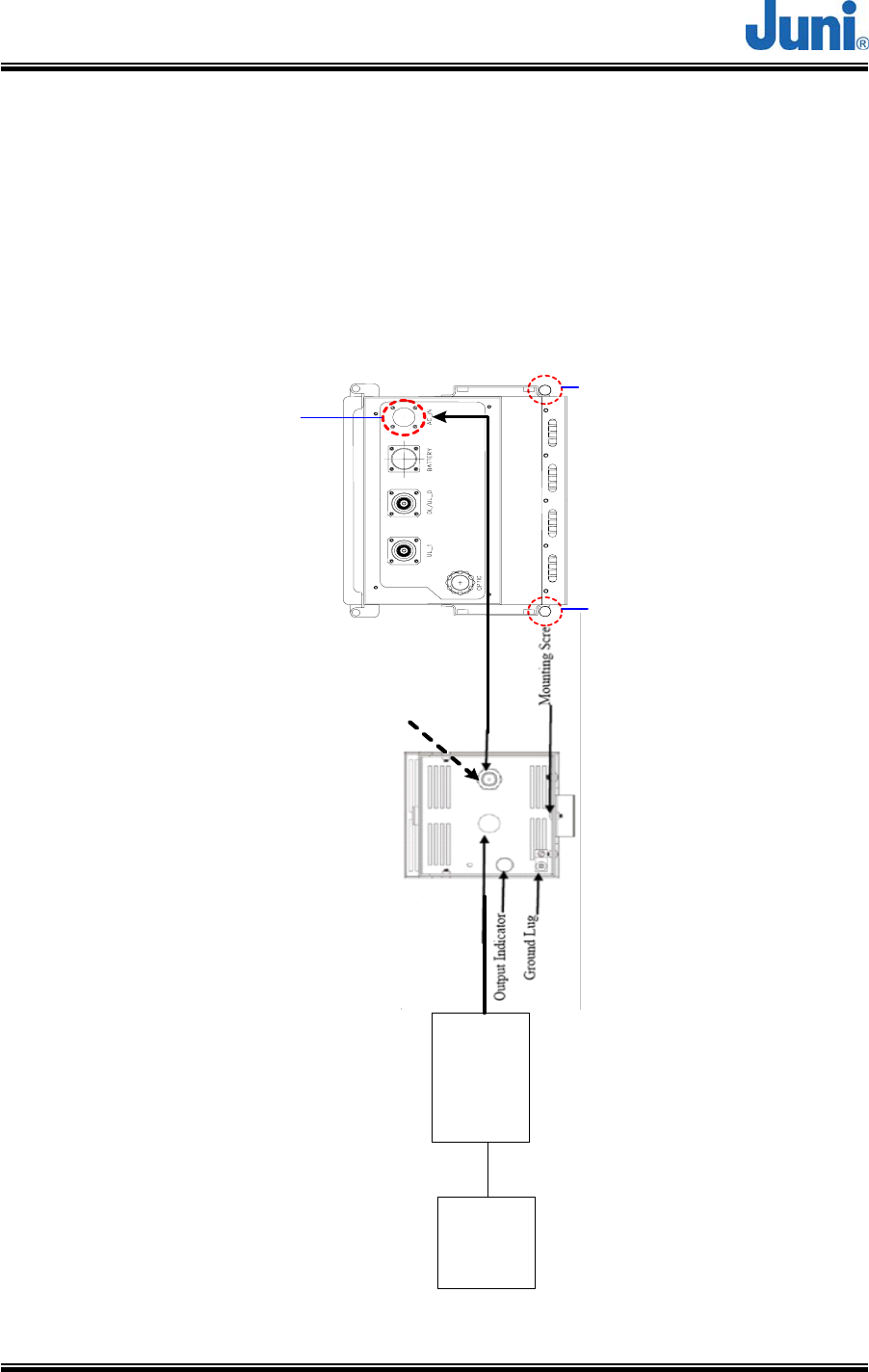
JUNI JF43-E1900/CFN03
CDMA FIBER FED REPEATER OPERATIONS MANUAL
Version 1.17 ⓒ J
uni America Inc. Page 31 of 88
3.5.10 LVAC Cables and Connectors Installation Guide
Please refer to Appendix C which contains the cable assembly installation guide from
Corning Gilbert on how to prepare and connect the cables and connectors required
for the JF-43.
3.5.11 Remote Unit External Powering Configuration (Optional)
APC FRP Power
Supply
(Bottom View)
60V output
20A High
magnetic circuit
breaker
Input AC
power
115VAC
nominal
115VAC wiring
Connect Ground
Cable Here
Connect Ground
Cable Here
Gilbert GRS-625-PF -CH-067-T
Male Connector
Commscope
PF625JCAT Power
Feeder Coax cable
Gilbert GRS-625-
PF-CH-122-T
Male Connector
Remote Unit
Bottom View
[Figure 3.12] Remote Unit External Powering Configuration
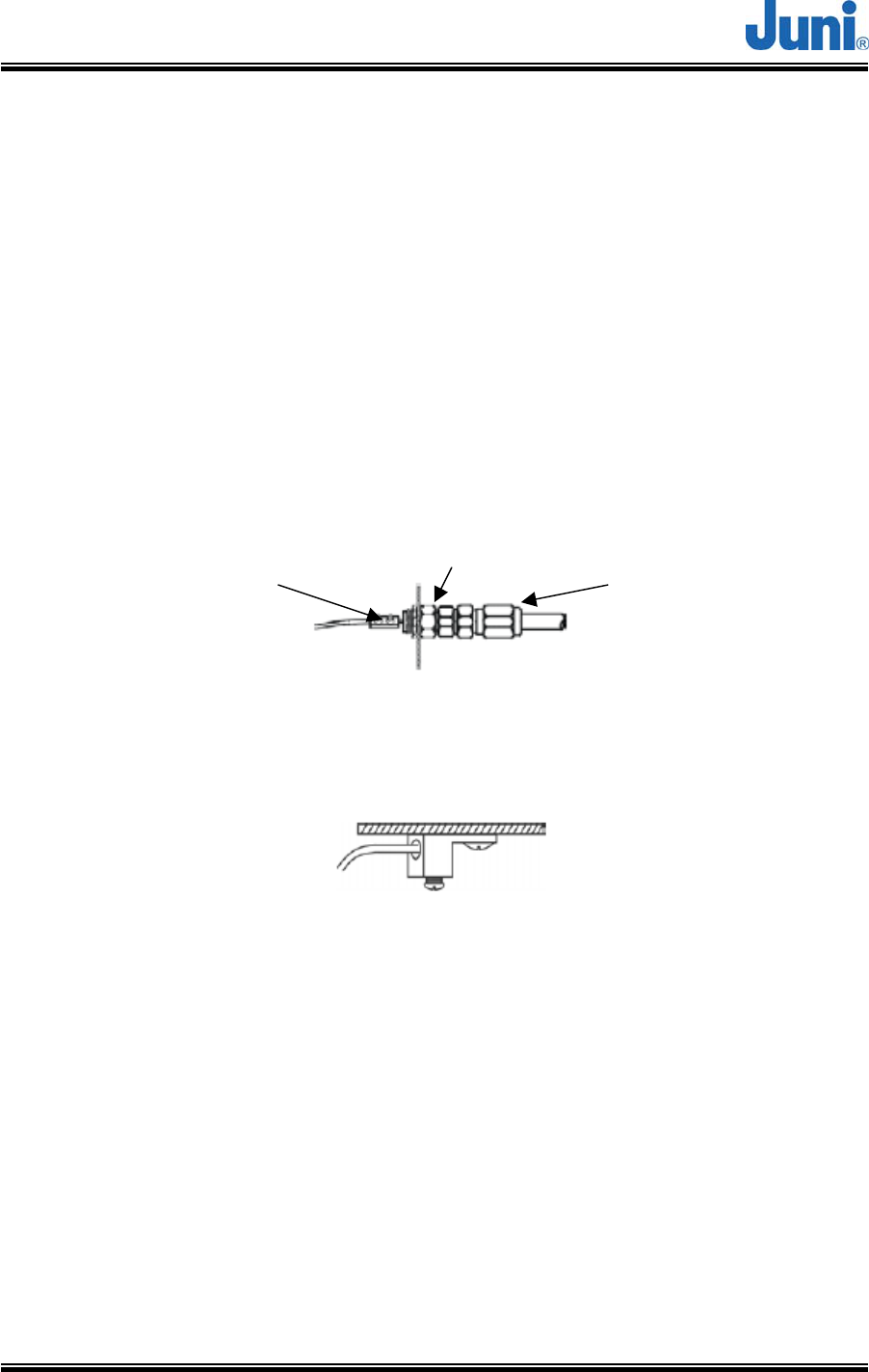
JUNI JF43-E1900/CFN03
CDMA FIBER FED REPEATER OPERATIONS MANUAL
Version 1.17 ⓒ J
uni America Inc. Page 32 of 88
The following procedure is only used when electric power at the site differs to the RU
power supply range and results in an external power supply being used. Please follow
the procedure below to safely install an external power supply to the RU.
1. Unlock the FRPS enclosure. Let the lid slide down and then pull out at the top. The lid
will remain attached to the Power Supply.
2. Check the line power switch of the power supply to ensure that it is OFF.
3. Install a Gilbert male type AC connector into the chassis connector located on the
bottom of the Power Supply.
4. Attach the yellow wire with the clamp to the stinger of the male connector. Tighten the
setscrew on the lug clamp as shown below.
[Figure 3.13] Steps 3 and 4
5. Place #6 copper ground wire into the ground lug located on the bottom of the cabinet.
[Figure 3.14] Step 5
6. Route and attach the ground wire according to local electrical codes.
7. Install an approved 20 amp high magnetic circuit breaker on the input power side of
the power supply.
8. Install a conduit into the opening on the bottom and attach line power in accordance
with local electrical codes. The barrier strip is wired with the hot leg at the top. The
bottom connector is chassis ground.
Male Gilbert
AC connector
Yellow wire with clamp
Chassis connector

JUNI JF43-E1900/CFN03
CDMA FIBER FED REPEATER OPERATIONS MANUAL
Version 1.17 ⓒ J
uni America Inc. Page 33 of 88
3.5.12 Remote Unit Commissioning and Provisioning
1. Verify that the power is switched OFF.
2. Before any other connections are made, ensure that the ground terminal on the RU
cabinet has been connected to the common ground of the installation site, as
described in the previous section.
3. Using an AC voltmeter, verify that the AC voltage level at the AC outlet is between
110 and 120VAC (for 120VAC powered systems) or between 220 and 240VAC (for
240VAC powered systems)
4. Check that the AC power cable is supplying the correct voltage (55 to 88VAC) and
polarity and then connect it to the AC input port of the RU.
5. At the AC breaker box, close the circuit breaker for the circuit that supplies AC power
to the RU.
6. Verify that all electrical and optical connections have been completed and that all
optical fibers, coaxial cables and wires are properly routed and secured.
7. The incoming electrical line of the RU should be made waterproof and moisture proof
by using contraction tubes.
8. Connect one of the customer-supplied antenna cables to the DL/UL0 port of the RU.
Connect a second customer-supplied Antenna cables to the UL1 port of the RU.
9. Connect the optic cable to the optic module inside the RU cabinet. (As the optic input
level from the DHU would be measured during gain setup, the installer may choose
not to connect the optical fiber cable at this point.)
10. Connect the customer-supplied 5/8 inch CATV AC power cable to the RU AC power
port. (AC power must be turned OFF for safety.)
11. Switch the power on and check the status of power supply LED.
12. Connect a PC to the debug port of the RU with a USB cable and load the LMT (Local
Maintenance Terminal) software to check the status and settings of the RU.
13. Ensure that communication between the RU and DHU is functioning correctly after
setting the address with the dip switches on the RSM (Remote Saw Module).
14. Check the downlink signal power waveform and level.
15. Close the door of the RU and weatherproof the connectors and boot.
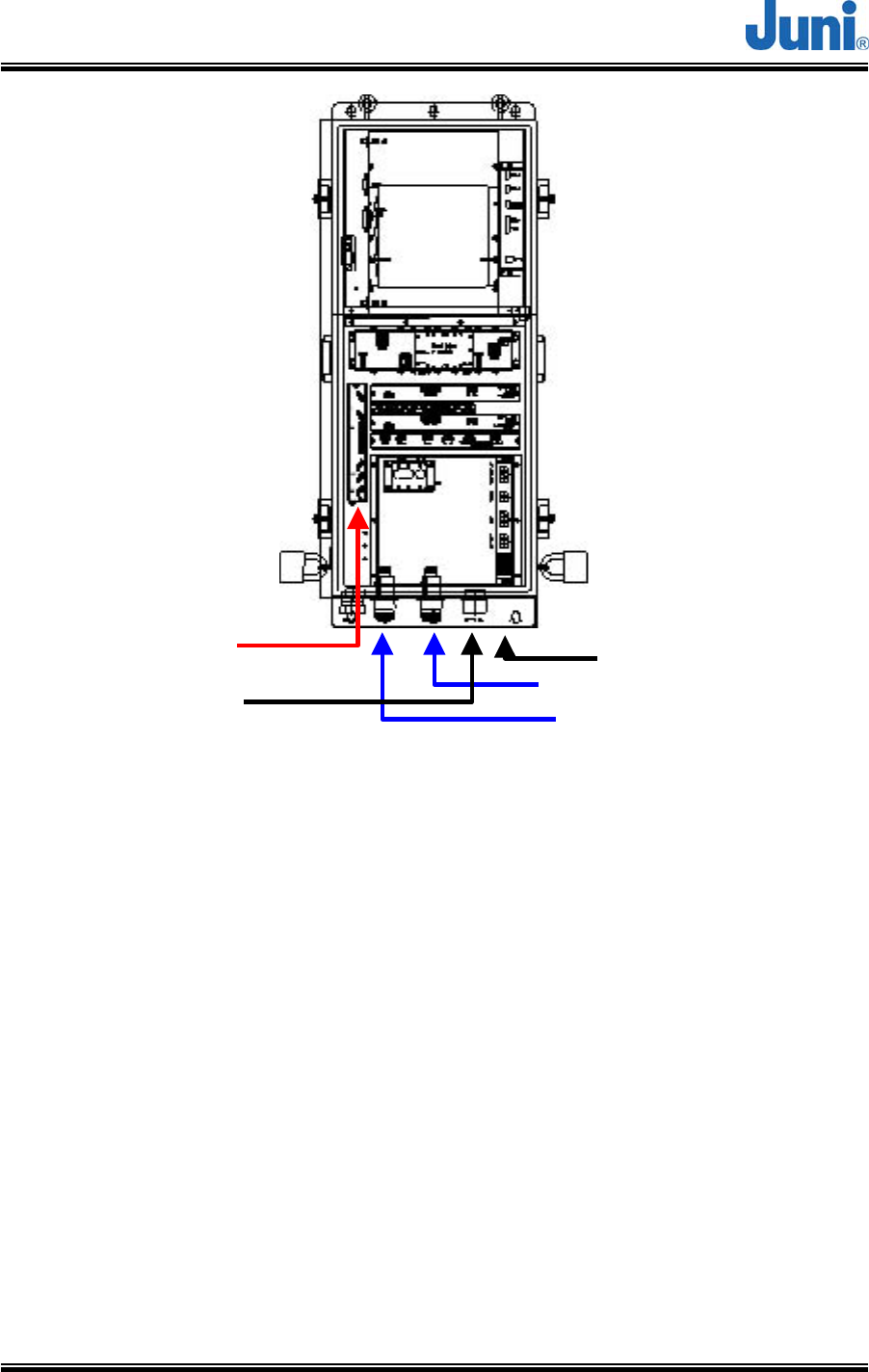
JUNI JF43-E1900/CFN03
CDMA FIBER FED REPEATER OPERATIONS MANUAL
Version 1.17 ⓒ J
uni America Inc. Page 34 of 88
[Figure 3.15] Cable connections for the remote unit (Top View)
Fiber Optic Cable
Passed Through
UL_1 RF Port
DL/UL_0 RF Port
AC Input (50 - 88VAC)
Battery Cable
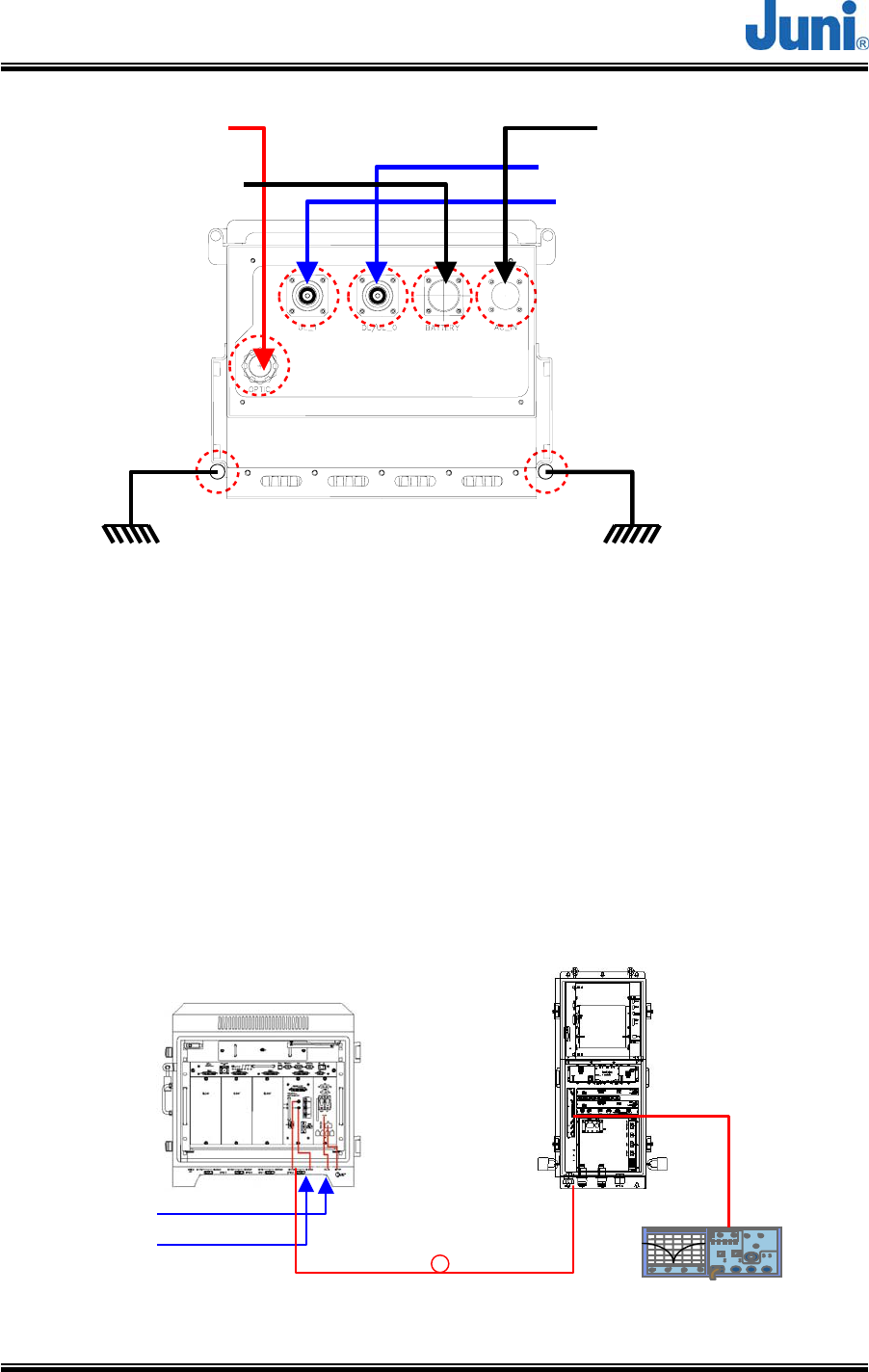
JUNI JF43-E1900/CFN03
CDMA FIBER FED REPEATER OPERATIONS MANUAL
Version 1.17 ⓒ J
uni America Inc. Page 35 of 88
[Figure 3.16] Cable connections for the remote unit (Bottom View)
3.5.13 Operations Tests
This section provides test procedures for the uplink and downlink required to be
undertaken in order to set up the JF-43 for optimal service.
3.5.13.1 Optic Cable Loss Test
Connect the system as shown below:
Fiber Optic
(
1550nm
)
DL1/UL1F Input
from BTS
DL0/UL0 input
from BTS
Optic Power
Mete
r
Fiber Optic Cable
Passed Through
UL_1 RF Port
DL/UL_0 RF Port
AC Input (55 - 88VAC)
Battery Cable
AC Input (55 - 88VAC)
AC Input (55 - 88VAC)

JUNI JF43-E1900/CFN03
CDMA FIBER FED REPEATER OPERATIONS MANUAL
Version 1.17 ⓒ J
uni America Inc. Page 36 of 88
[Figure 3.17] Connection to perform optic cable loss test
Check optic cable loss by using an optic power meter or reflectometer
1. With the DHU on, connect the power meter to the optic module of the RU and
measure the Forward (1550nm) output level. If the optic input level exceeds +6dBm,
check the DHU optic module.
2. If the optic loss is larger than –6dBo (on the basis of 1510nm, optic loss = donor
output optic power – remote input optic power) through calculating with measured
optic power and if the optic cable length between the DHU and RU is less than 15
miles, check if there is a fault in the PD (Photo Diode) or check the optic cable.
3. If a PD fault has occurred inspect the optic input level and check the optic line. Clean
the optic connector and if a fault is still existent, send the repeater back to Juni for
repair.
* Reference
a. Optic cable loss is 0.25dB/km at 1510nm, and connection loss is 0.4dB/connector.
The total optic deviation of connector is about 1to2dB. (0.4dB ×2 (connector) =
about 1dB)
b. At the time of delivery, the Gain is set to be about 38dB (Tx), 20dB (Rx) as a default
on the basis of optic cable length being 15 miles.
3.5.14 Setup Procedure for DL/UL Path Gain
This section provides test procedures for the uplink and downlink required to be
undertaken in order to set up the JF-43 for optimal service.
3.5.14.1 Setup for UL Gain
1. Connect the RF signal generator to the ‘DL/UL_0’ port of the RU.
2. Transmit an input signal of -55dBm to the ‘DL/UL_0’ port using the signal generator.
3. Connect spectrum analyzer to ‘DL/UL_0’ port of the DHU. (Span: 5MHz, amplitude
offset = cable loss).
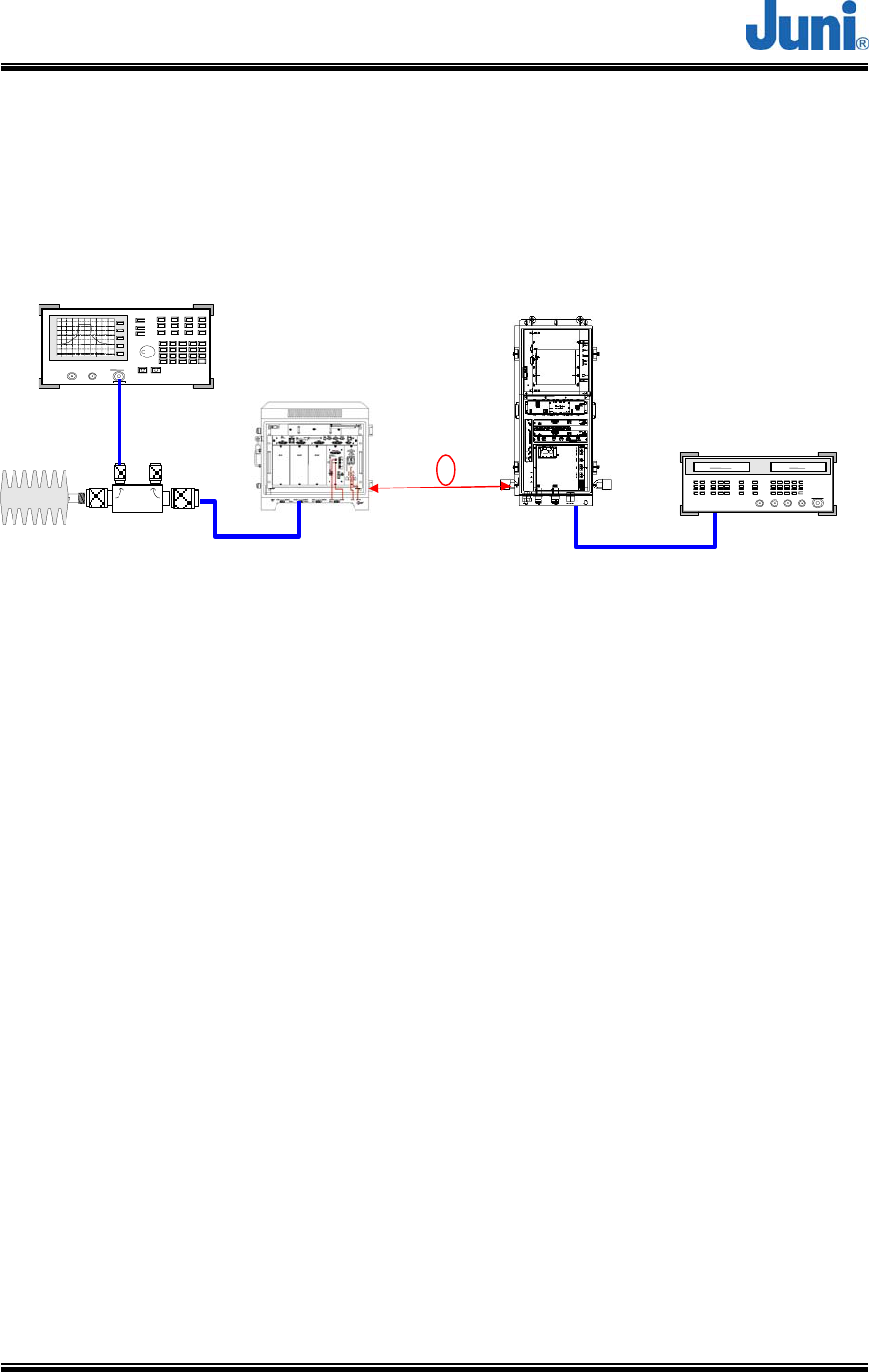
JUNI JF43-E1900/CFN03
CDMA FIBER FED REPEATER OPERATIONS MANUAL
Version 1.17 ⓒ J
uni America Inc. Page 37 of 88
4. Adjust the UL0 Main ATT from the LMT (RF power level with measuring spectrum
analyzer) to adjust the reverse output to be -35dBm. (This is to set the reverse gain of
the system to 0dB considering the 20dB coupler used to connect to the BTS input.)
[Figure 3.18] Connection to set up UL gain
3.5.14.2 Setup for DL Gain
1. Check whether the DL input to the DHU is within -3dBm to +7dBm/Total.
2. Set the RU FWD ATT to 25dB.
3. Turn ON the forward LPA.
4. While monitoring the forward output power measurement function of the LMT (Local
Maintenance Terminal), adjust the RU forward attenuation to obtain the desired RU
forward output level.
Note: The technician responsible for the repeater provisioning should have data for off peak
and peak hour traffic for the BTS. It is recommended to set the RU output around 7 to 8dB
less than the max output (43dBm) at off peak hours (No traffic) to prevent any over power
shutdown.
DL/UL_0
DL0/UL0
Donor
6dBo
Loss
Signal Generator
Spectrum Analyzer Remote
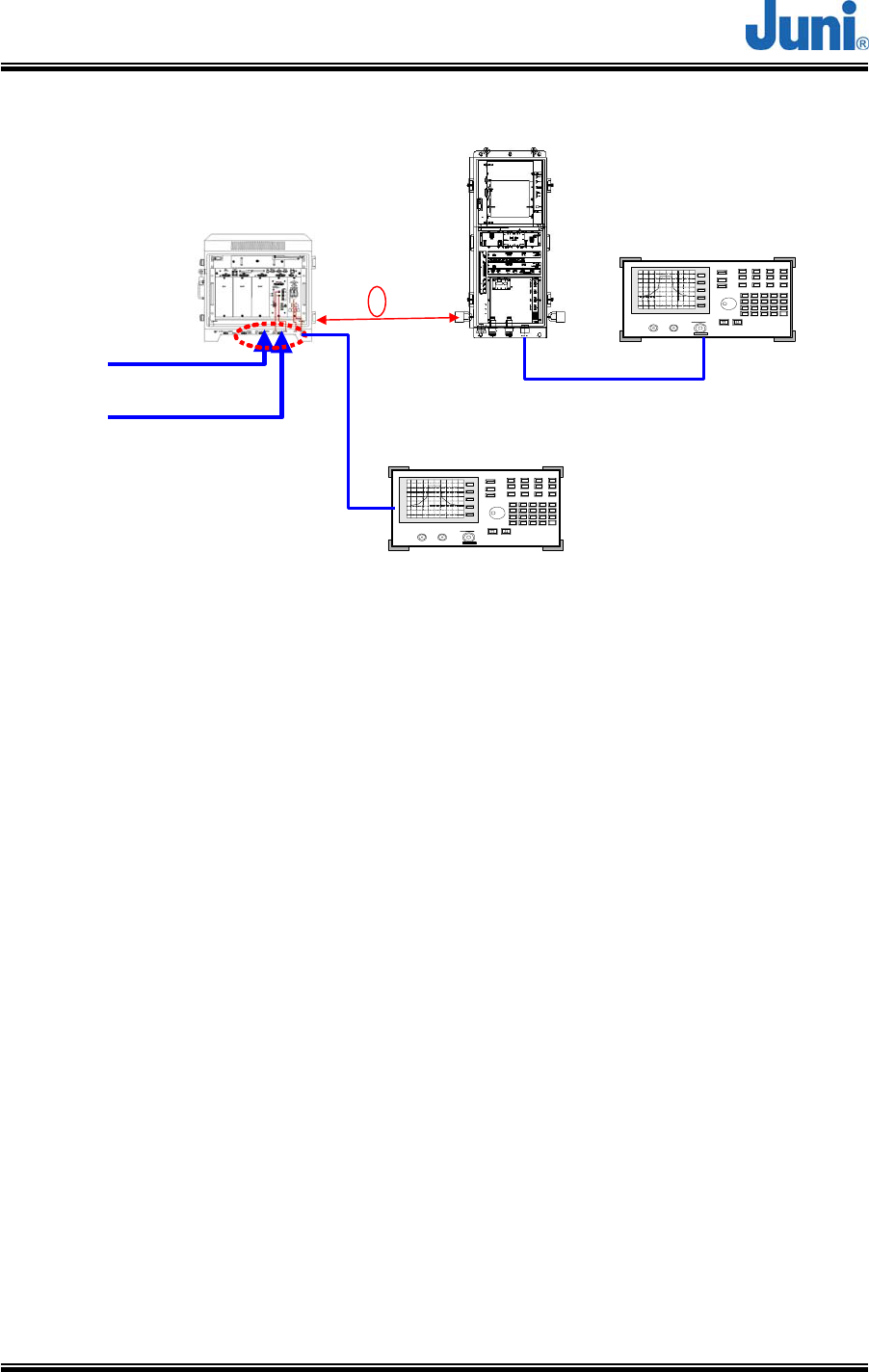
JUNI JF43-E1900/CFN03
CDMA FIBER FED REPEATER OPERATIONS MANUAL
Version 1.17 ⓒ J
uni America Inc. Page 38 of 88
[Figure 3.19] Connection to set up DL gain
3.5.14.3 Caution Items
● When adjusting the forward gain, start from the minimum gain setting.
● Max. Output Power should not exceed 20W (about +43dBm),
● When adjusting output levels while monitoring the CDMA test equipments, input the
appropriate offset level in the Spectrum Analyzer considering the Cable Loss. (offset
value = coupling value + measured cable loss)
DL/UL_0
DL1/UL1
from BTS
Donor
6dBo
Loss
Spectrum Analyzer
Remote
DL0/UL0
from BTS
Spectrum Analyzer

JUNI JF43-E1900/CFN03
CDMA FIBER FED REPEATER OPERATIONS MANUAL
Version 1.17 ⓒ J
uni America Inc. Page 39 of 88
3.6 Replacement of Faulty Units
Please follow the procedure to replace faulty or failed components and units. The unit
replacement procedure is common to both the DHU and RU.
3.6.1 Remote/Donor Unit Replacement
1. For RU replacement, turn off the HPA of the RU.
2. Turn off the power of the RU or DHU.
3. Disconnect all cables from the faulty unit.
Note: The antenna cables must be disconnected after the repeater power has been
turned ‘OFF’.
4. Dismount the faulty unit from its mounting method.
5. Remount the replacement unit to its position.
6. Connect all cables to the replaced unit.
7. Turn on the power of the replaced unit.
8. For RU replacement, check whether the HPA is off (Turn it off if it is on), and
configure the settings of the replaced unit. These settings should be identical to
the previous faulty unit settings while it was under service.
9. For RU replacement, turn on the HPA of the RU.
3.6.2 Optical Module Replacement
1. Turn off the MCU power first.
2. Turn off the DHU power supply.
3. Disconnect al RF connectors, data cables and optical fiber that are connected to
the Optic Transceiver.
4. Unscrew the multi-turn fastener located at the top and bottom of the module and
pull on the handle to free the optic receiver.
5. Completely remove the module from its slot and place the replacement module
back into the same position being careful not to bump the Optic Transceiver.
6. Tighten the multi-turn fastener and reconnect all cables and connectors.
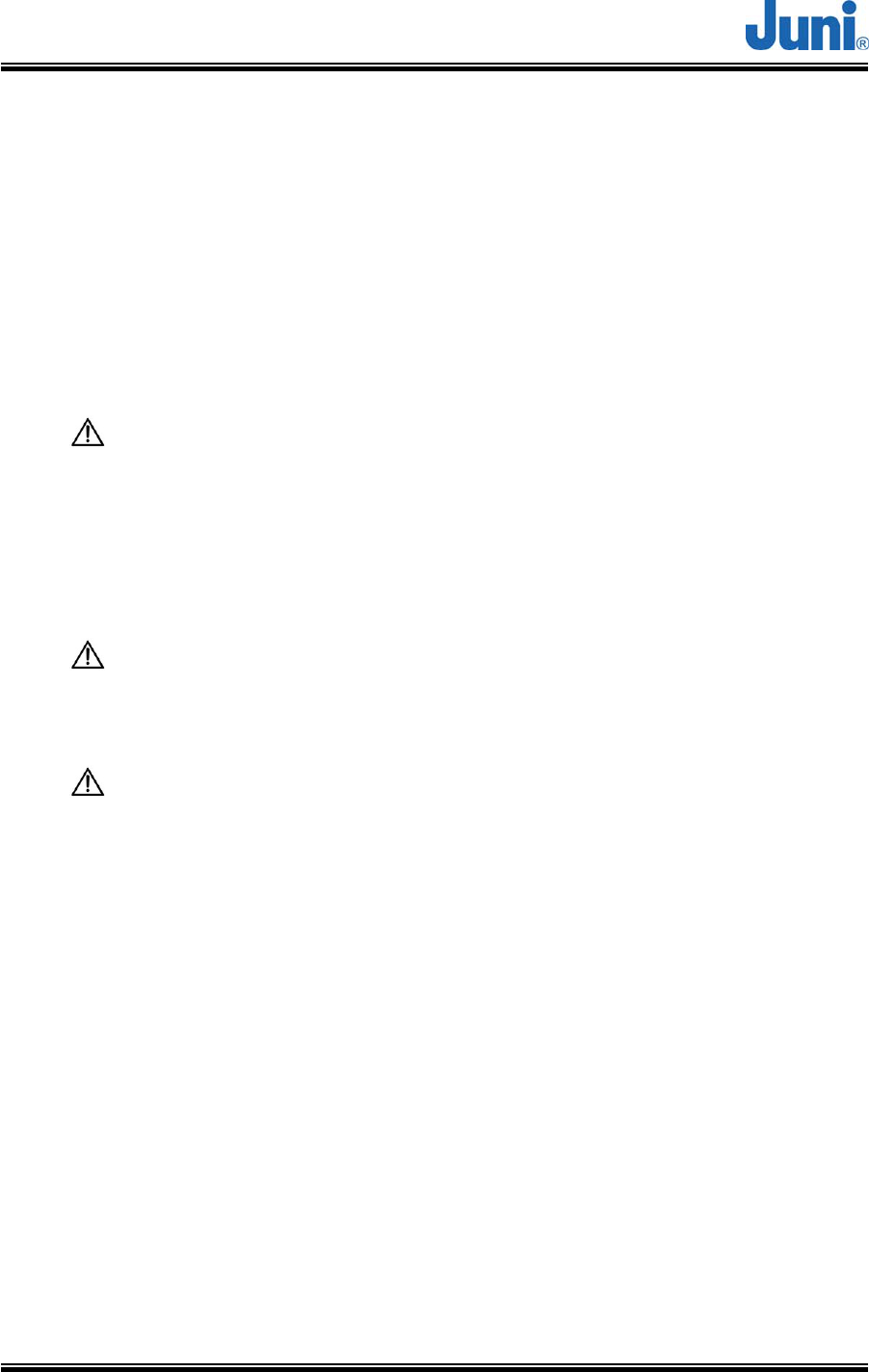
JUNI JF43-E1900/CFN03
CDMA FIBER FED REPEATER OPERATIONS MANUAL
Version 1.17 ⓒ J
uni America Inc. Page 40 of 88
3.7 Storage of the Repeater
• When storing the repeater, it is recommended to pack the repeater in its original
package supplied by Juni America.
• The repeater should not be stored in a high temperature or humid environment and
avoid direct sunlight.
3.8 Safety Precautions
To avoid the risk of accidental electric shock, do not touch the contact terminals
on the power supply unit or the control board during normal operation. If
replacement for a component is required, the power of the repeater should be
turned ‘OFF’ before taking any action.
To avoid the risk of accidental fire or electric shock, do not expose this product
to rain or any other wet condition.
Only a qualified technician should service this repeater. Opening or removing
covers may expose you to dangerous voltages, radiation and/or other risks.
Incorrect assembly may cause electric shock when the unit is subsequently
used.

JUNI JF43-E1900/CFN03
CDMA FIBER FED REPEATER OPERATIONS MANUAL
Version 1.17 ⓒ J
uni America Inc. Page 41 of 88
4. Operation
This section provides guidelines for operating the JF-43 system via GUI interfaces.
Information is provided on how to verify all units are operating properly and all
performance requirements are satisfied. This process assumes that the units have
been installed in accordance with the system design plan.
4.1 Introduction
The process of turning on the system and verifying operation involves powering up
various site names and adjusting the RF signal levels. The operator can control and
monitor the system parameters by using the LMT software provided.
4.2 LMT Operation (Local Maintenance Terminal)
4.2.1 Introduction
The JF43 repeater can be controlled via the LMT (Local Maintenance Terminal)
software installed on a computer. This enables the operator to monitor and control the
repeater by connecting a PC to the repeater via a linked or wireless communication
protocol.
4.2.2 Screen Description
When the Juni_Serial.exe file is started and the program does not detect a connection
with the repeater, the following screen is displayed.

JUNI JF43-E1900/CFN03
CDMA FIBER FED REPEATER OPERATIONS MANUAL
Version 1.17 ⓒ J
uni America Inc. Page 42 of 88
[Figure 4.1] LMT Start up Screen - 1
If a connection is made between the repeater and the software running computer, it
will display the screen shown below.
1. Pause communication with Repeater
2. Dis
p
la
y
s installed Re
p
eaters
3. Communication status with Repeater
4. Status
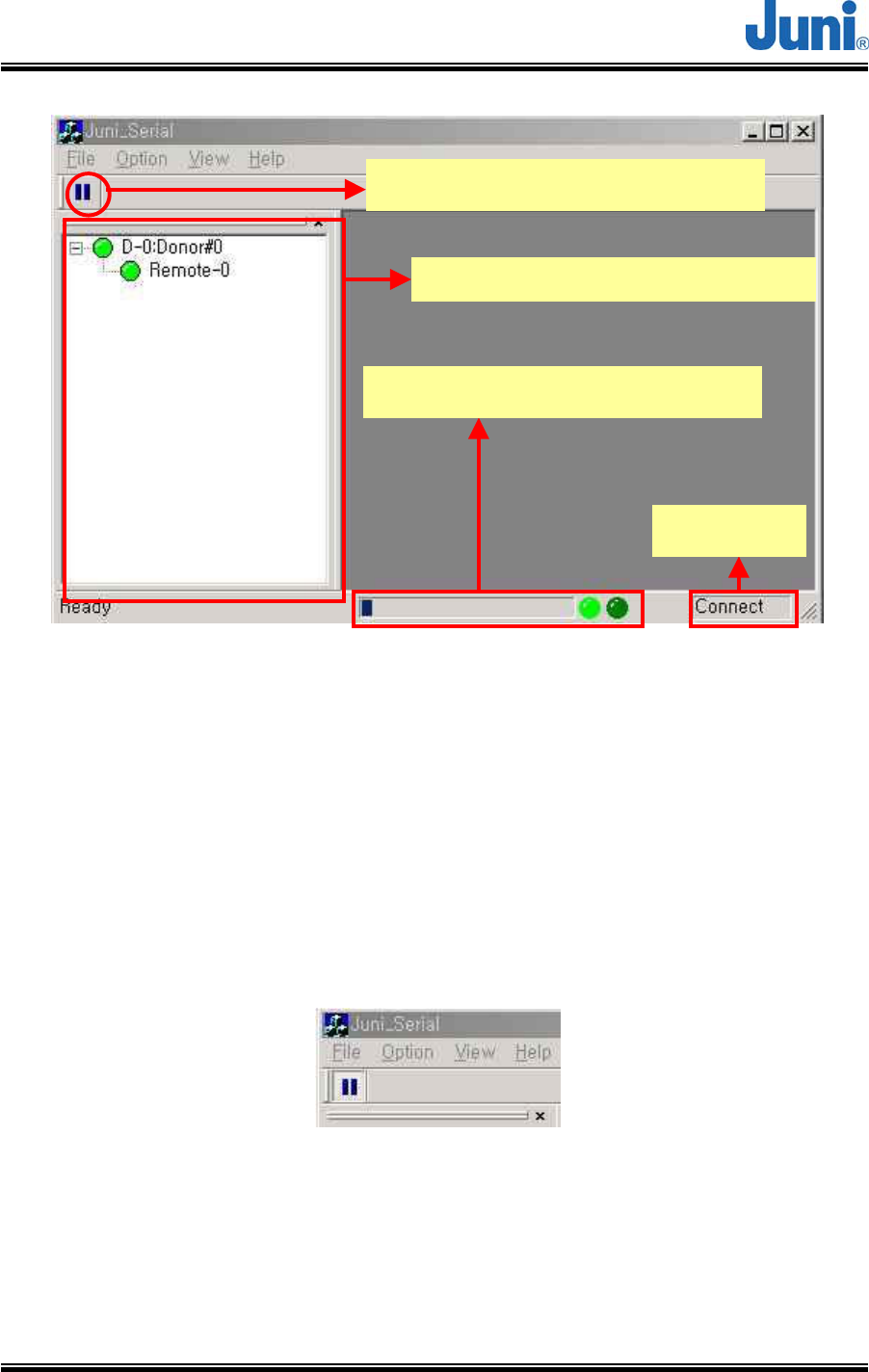
JUNI JF43-E1900/CFN03
CDMA FIBER FED REPEATER OPERATIONS MANUAL
Version 1.17 ⓒ J
uni America Inc. Page 43 of 88
[Figure 4.2] LMT Start up Screen - 2
1) Pause communication with Repeater: This button is used for momentarily
disabling and re-enabling communication with the Repeater. Communication with the
Repeater is automatically disabled during program startup and Repeater Firmware
downloads. When the communication is paused, the icon will be displayed as below,
and the LED’s on the bottom of the screen will pause its flashing.
[Figure 4.3] Pause Icon
2) Installed Repeaters Display: Displays the Repeaters installed as a hierarchical
tree. Information for the items in this tree may be viewed by either double clicking on
the content or right-clicking on the mouse and selecting “Status & Control” menu as
1. Pause communication with Repeater
2. Dis
p
la
y
s installed Re
p
eaters
3. Communication status with Repeater
4. Status
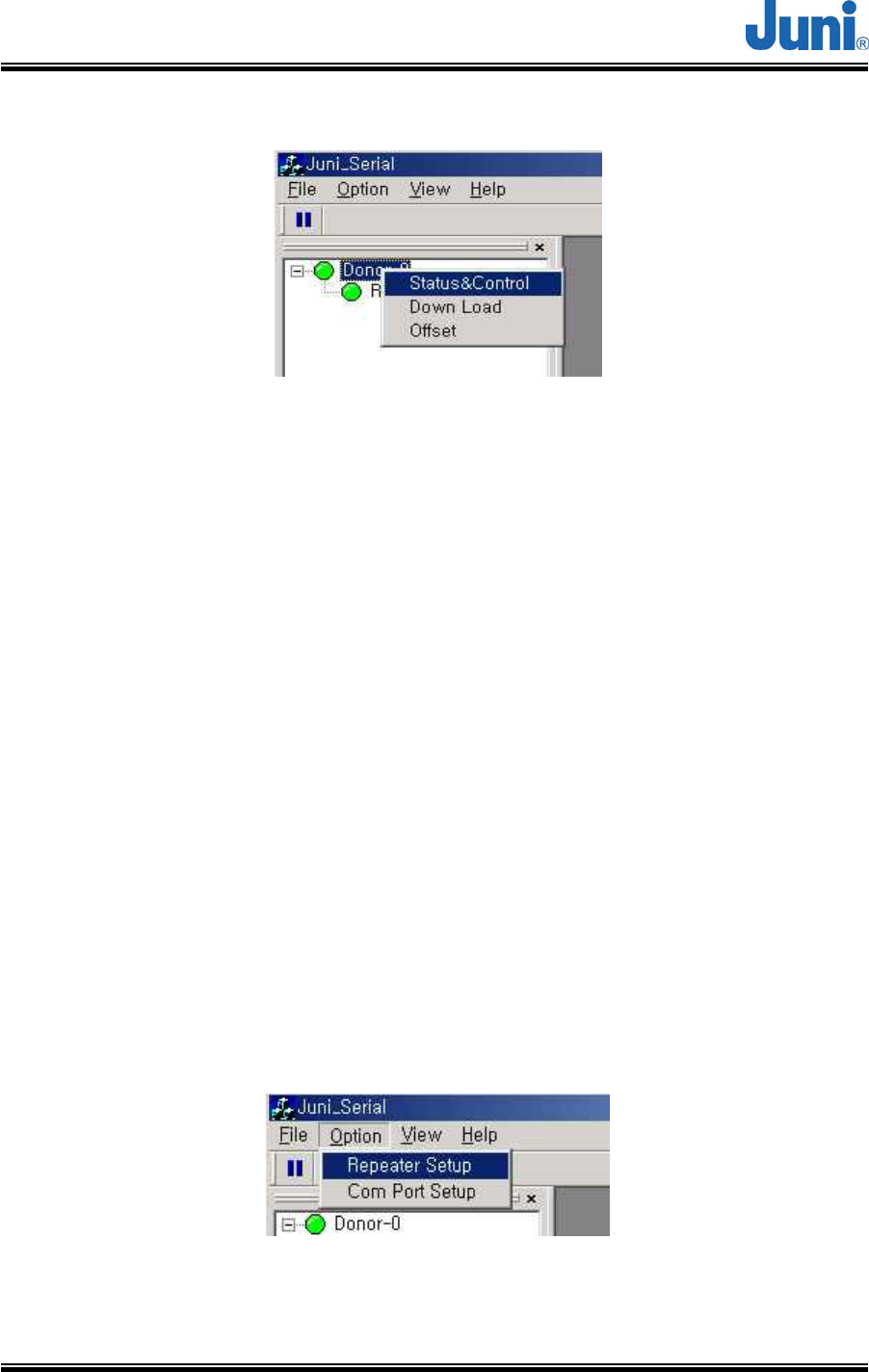
JUNI JF43-E1900/CFN03
CDMA FIBER FED REPEATER OPERATIONS MANUAL
Version 1.17 ⓒ J
uni America Inc. Page 44 of 88
illustrated below.
[Figure 4.4] Status & Control
3) Communication status with Repeater: The Progress Bar and LED's display the
status of communication with the Repeater at the bottom of the screen.
4) Status: Displays “Disconnect” when there is no communication and “Connect”
when there is communication between the repeater and the LMT program.
4.2.3 Communication Settings
When the repeater is connected to the computer via USB cable for the first time, it will
automatically detect the hardware and run the new hardware wizard. Install the
manufacturer supplied driver to enable communication between the repeater and the
computer.
4.2.4 Repeater Setup
To configure the repeater settings, click the “Option” menu and select the “Repeater
Setup” as shown in Figure 4.5. This will bring up the “Repeater Set up” window as
shown in Figure 4.6 below.
[Figure 4.5] Choosing Repeater Setup
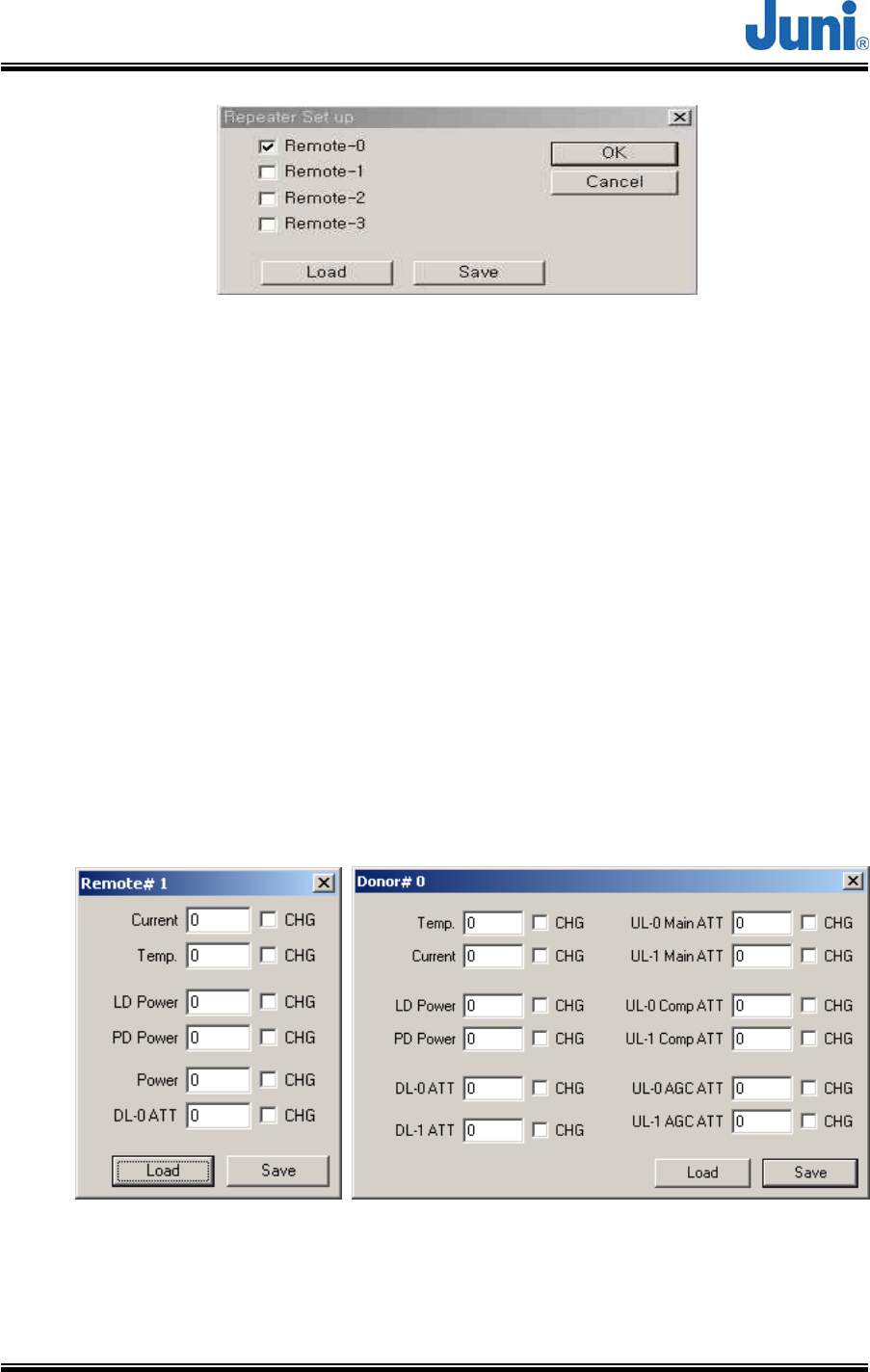
JUNI JF43-E1900/CFN03
CDMA FIBER FED REPEATER OPERATIONS MANUAL
Version 1.17 ⓒ J
uni America Inc. Page 45 of 88
[Figure 4.6] Repeater Setup Window
Click the “Load” button to display the current configuration. To make changes to the
current settings, tick the box beside each of the desired items and click “Save” and
then “OK”. For initials setting values and instructions, please refer to section 4.2.6.3.
4.2.5 Offset Calibration
Since the power level readings can differ to the actual RF power level by up to 1dB,
an offset feature exists within the LMT that allows you to calibrate the LMT to
synchronize the readings from the RF test equipment.
The default offset values for all repeaters are set to 0. To access the offset feature, do
as shown in figure 4.4 and select “Offset” to display the window below. The process is
the same for both Donor and Remote.
[Figure 4.7] Default Offset Feature Window for Remote and Donor
To set an offset for a particular parameter, first check the CHG box to enable the LMT
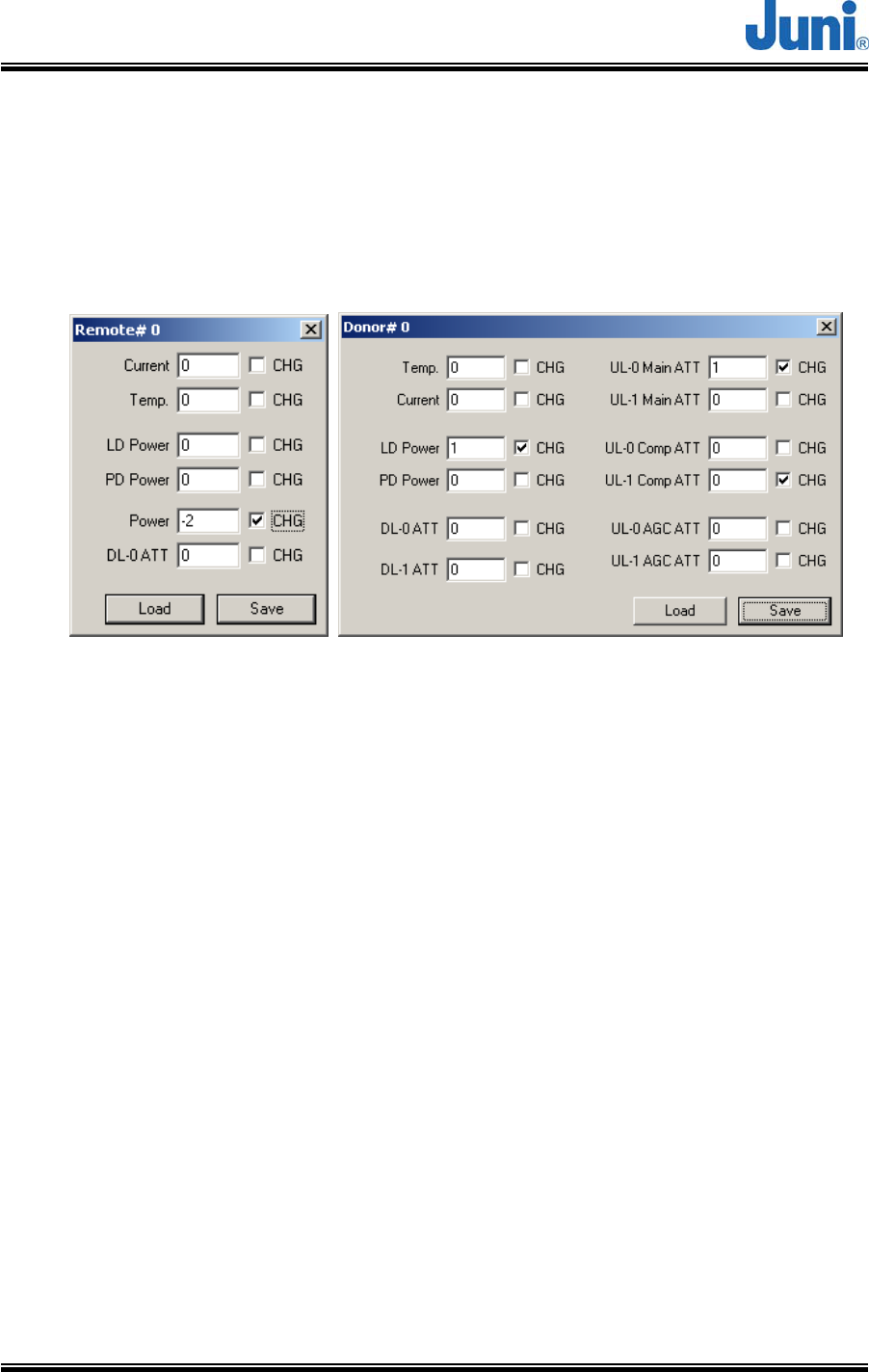
JUNI JF43-E1900/CFN03
CDMA FIBER FED REPEATER OPERATIONS MANUAL
Version 1.17 ⓒ J
uni America Inc. Page 46 of 88
to read and save the settings. Entering a value without check the box will have no
effect on the repeater. Once the values have been inputted, press ‘Save’ to save the
values and ‘Load’ to load the offset values to the unit. When complete, uncheck the
marked boxes and close the offset window.
[Figure 4.8] Offset Calibration
4.2.6 Repeater Status Monitoring and Control
To view the status of installed Repeaters, double click on the desired Repeater in
Figure 4.5 to bring up the Control Window. This can also be done by right-clicking on
the desired Repeater and selecting the “Status & Control” command as shown in
Figure 4.4.
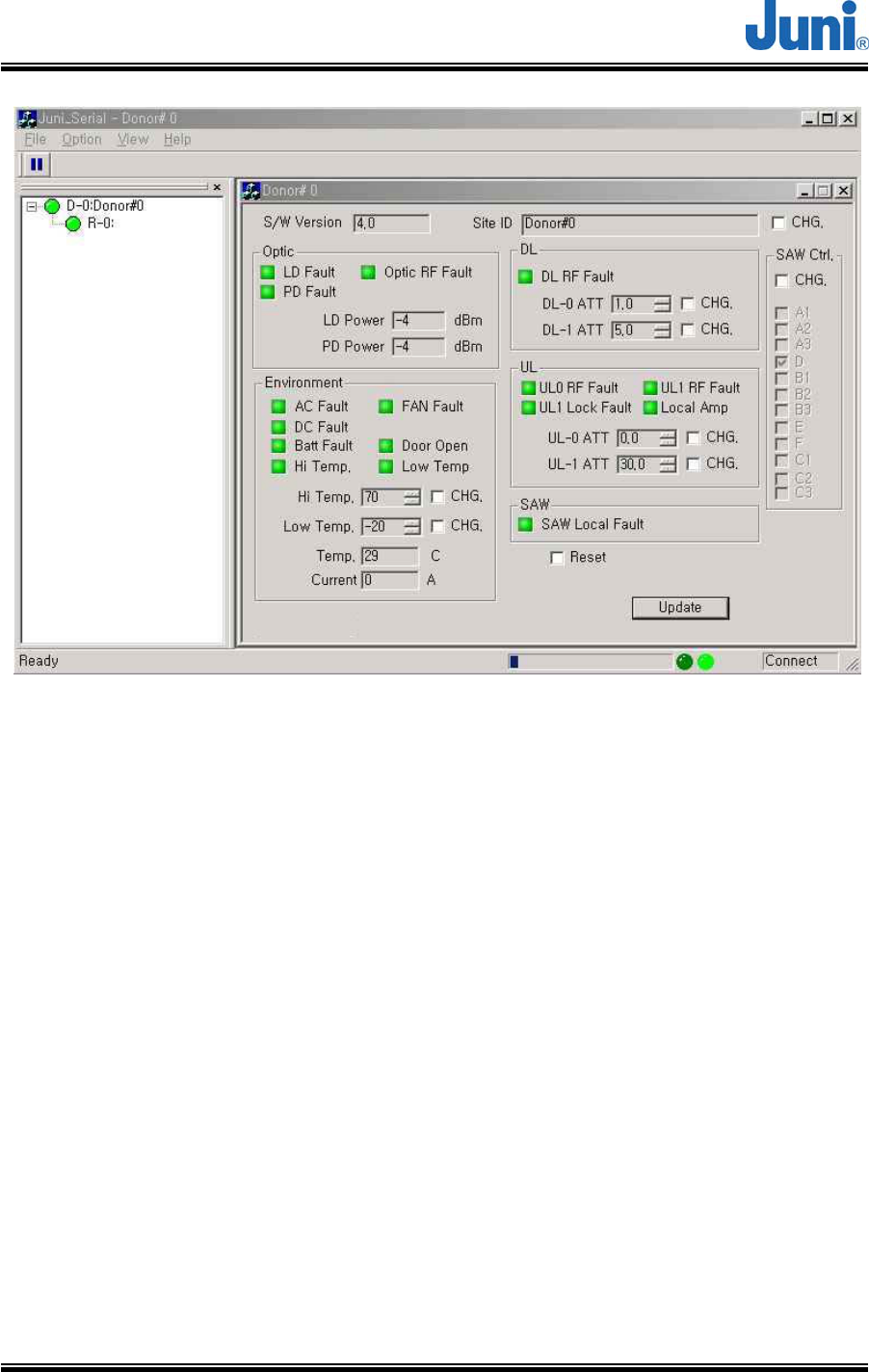
JUNI JF43-E1900/CFN03
CDMA FIBER FED REPEATER OPERATIONS MANUAL
Version 1.17 ⓒ J
uni America Inc. Page 47 of 88
[Figure 4.9] Donor Unit Status Window
4.2.6.1 Donor Unit Window
The system status may be monitored by the color indicated beside each of the alarm
contents. Red color denotes a fault/alarm status whereas the Green denotes normal
status.
1. S/W Version
Displays the current software version of the Juni_Serial.exe program.
2. Site ID:
Displays the location or the site name of where the repeater is installed. By checking
the CHG box, the site ID of the DHU can be renamed and saved.
3. Optic
① LD Fault: Displays the alarm state of the Laser Diode. Generates alarm when the

JUNI JF43-E1900/CFN03
CDMA FIBER FED REPEATER OPERATIONS MANUAL
Version 1.17 ⓒ J
uni America Inc. Page 48 of 88
DHU Laser Diode does not detect any optic output power.
② PD Fault: Displays the alarm state of the Laser Diode. Generates alarm when the
DHU Photo Diode does not detect any optic input power.
③ Optic RF Fault: Displays the alarm state of the Amplifier of the Optic module.
④ LD Power: Displays the Laser Diode optic output power.
⑤ PD Power: Displays the Photo Diode optic input power.
4. Environment
① AC Fault: Displays the alarm state of the main input power of the DHU.
② DC Fault: Displays the alarm state of the power supply of the DHU. Generates an
alarm when the DHU power supply detects a fault in its circuit.
③ Batt Fault: Displays the alarm state of the Battery of the DHU.
④ Hi Temp: Displays the alarm generated when the detected DHU temperature is
higher than the set ⑧ Hi Temp.
⑤ FAN Fault: Displays the alarm state of the Fan of the DHU.
⑥ Door Open: Displays the alarm state of the Door of the DHU.
⑦ Low Temp: Displays the alarm generated when the detected DHU temperature is
lower than the set ⑨ Low Temp.
⑧ Hi Temp: Sets/Displays the maximum temperature limit.
⑨ Low Temp: Sets/Displays the minimum temperature limit.
⑩ Temp: Displays the current temperature of the DHU.
⑪ Current: Displays the amount of current consumed by the repeater.
5. DL
① DL RF Fault: Displays the alarm state of the Downlink Amplifier.
② DL-0 ATT: Sets/Displays the Downlink-0 attenuation. Accurately matches the input
level of the DHU to the optic module dynamic range input.
③ DL-1 ATT: Sets/Displays the Downlink-1 attenuation. Accurately matches the input
level of the DHU to the optic module dynamic range input.

JUNI JF43-E1900/CFN03
CDMA FIBER FED REPEATER OPERATIONS MANUAL
Version 1.17 ⓒ J
uni America Inc. Page 49 of 88
6. UL
① UL0 RF Fault: Displays the alarm state of the Uplink0 Amp.
② UL1 RF Fault: Displays the alarm state of the Uplink1 Amp.
③ UL1 Lock Fault: Displays the alarm state of the Uplink1 Lock.
④ Local Amp: Displays the alarm state of the Local Amplifier.
⑤ UL-0 ATT: Sets/Displays the Uplink-0 attenuation. Attenuator that controls the
Uplink0 path gain.
⑥ UL-1 ATT: Sets/Displays the Uplink-1 attenuation. Attenuator that controls the
Uplink1 path gain.
7. SAW
① SAW Local Fault: Displays the alarm state of the Downlink SAW Local Lock.
8. Reset
① Uses the software to reset the system.
9. SAW Ctrl
① Displays the selected frequency band for the SAW Filter. Allows control and
selection of the 85 different frequency band combinations. Table 4.1 below displays
all the possible frequency combinations with Table 4.2 showing the frequency
ranges for each of the bands.
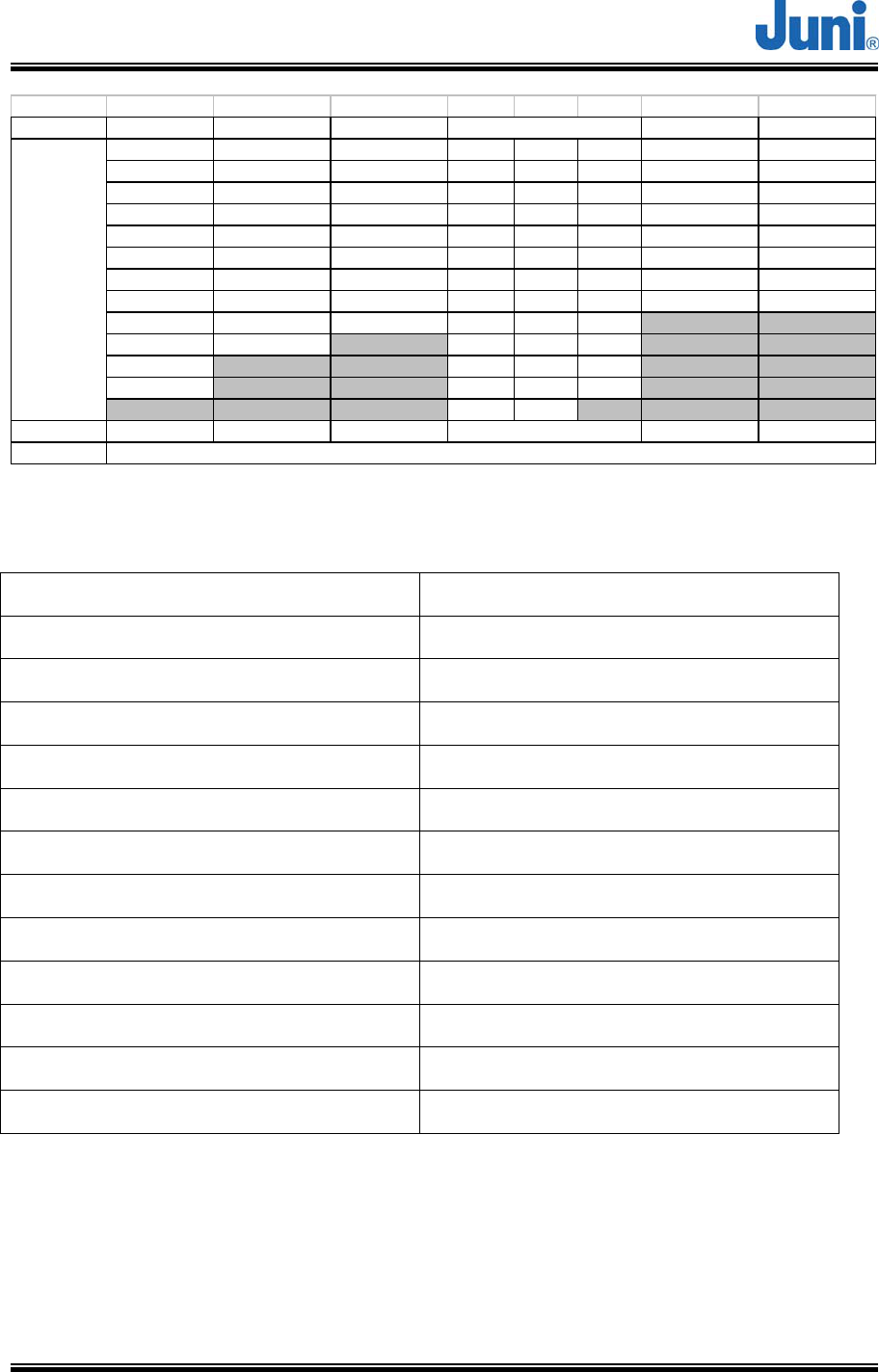
JUNI JF43-E1900/CFN03
CDMA FIBER FED REPEATER OPERATIONS MANUAL
Version 1.17 ⓒ J
uni America Inc. Page 50 of 88
[Table 4.1] 85 Possible Frequency Band Combinations
Band Frequency
A1 1850 to 1855 MHz
A2 1855 to 1860 MHz
A3 1860 to 1865 MHz
D 1865 to 1870 MHz
B1 1870 to 1875 MHz
B2 1875 to 1880 MHz
B3 1880 to 1885 MHz
E 1885 to 1890 MHz
F 1890 to 1895 MHz
C1 1895 to 1900 MHz
C2 1900 to 1905 MHz
C3 1905 to 1910 MHz
[Table 4.2] Frequency band ranges of Table 4
Note: Frequencies C1, C2, C3 are identical to FCC’s C3, C4, and C5.
4.2.6.2 Remote Window
normal 5MHz normal 15MHz normal 20MHz 5+15 15+5
A1 A A,D A1+A2 D+B2 B3+C1 A1+(A3,D,B1) A+B1
A2 A2,A3,D A2,A3,D,B1 A1+A3 D+B3 B3+C2 A2+(D,B1,B2) (A2,A3,D)+B2
A3 A3,D,B1 A3,D,B1,B2 A1+D D+E E+F A3+ B (A3,D,B1)+B3
D D,B1,B2 D,B A1+B1 B1+B2 E+C1 D+(B2,B3,E) (D,B1,B2)+E
B1 B B,E A2+A 3 B1+B3 E+C2 B1+(B3,E,F) B+F
B2 B2,B3,E B2,B3,E,F A2+D B1+E E+C3 B2+(E,F,C1) (B2,B3,E)+C1
B3 B3,E,F B3,E,F,C1 A2+B1 B1+F F+C1 B3+(F,C1,C2) (B3,E,F)+C2
E E,F,C1 E,F,C1,C2 A2+B2 B2+B3 F+C2 E+C (E,F,C1)+C3
F F,C1,C2 F,C A3+D B2+E F+C3
C1 C A 3+B1 B2+F C1+C2
C2 A 3+B2 B2+C1 C1+C3
C3 A3+B3 B3+E C2+C3
D+B1 B3+F
12 10 9 8 8
Total Count
5+5
38
85
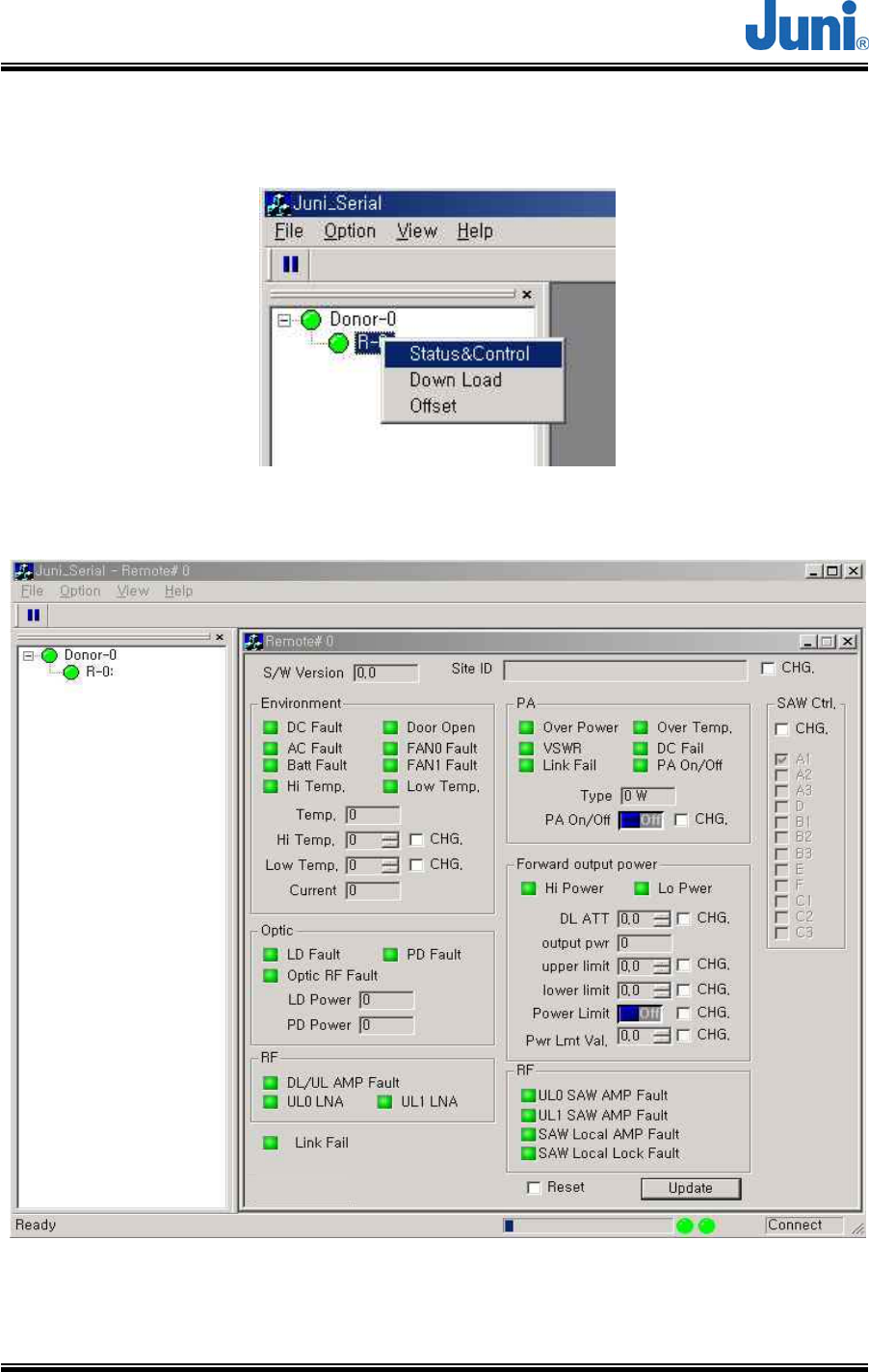
JUNI JF43-E1900/CFN03
CDMA FIBER FED REPEATER OPERATIONS MANUAL
Version 1.17 ⓒ J
uni America Inc. Page 51 of 88
To view the Remote-0 status screen displayed in Figure 4.9, right-click on Remote-0
and select “Status & Control” command as illustrated in the Figure 4.8 below.
[Figure 4.10] Remote_0 Select
[Figure 4.11] Remote_0 Status

JUNI JF43-E1900/CFN03
CDMA FIBER FED REPEATER OPERATIONS MANUAL
Version 1.17 ⓒ J
uni America Inc. Page 52 of 88
Similar to the Donor-0 Status window (Figure 4.7), the Remote-0 system status may
be monitored by the color indicated beside each of the alarm contents.
Note: only dissimilar items from the Donor-0 status window are outlined below.
1. PA
① Over Power: Displays the Over Power alarm state of the Power Amplifier
② VSWR: Displays the VSWR alarm state of Power Amplifier
③ Link Fail: Displays the alarm state of the Link between RSM and Power Amplifier
④ Over Temp: Displays the Over Temperature alarm state of the Power Amplifier
⑤ DC Fail: Generates alarm when the power supply of the Power Amplifier detects a
fault in its circuit
⑥ PA On/Off: Displays the ON/OFF state of the Power Amplifier
⑦ Type: Displays the capacity of the Power Amplifier
⑧ PA On/Off: Controls the ON/OFF function of the Power Amplifier
2. Forward output power
① Hi Power: Displays the High Power alarm status. Alarm generated when the
detected temperature of the RU exceeds the set ‘Upper Limit’
② Lo Power: Displays the Low Power alarm status. Alarm generated when the
detected temperature of the RU is below the set ‘Lower Limit’
③ DL ATT: Displays the Downlink (Forward) Attenuation. Attenuator that controls the
final downlink output
④ Output pwr: Displays the current output power
⑤ Upper limit: Displays the Upper limit output value
⑥ Lower limit: Displays the Lower limit output value
⑦ Power Limit: Controls the On/Off function of the Power Limit
⑧ Pwr Lmt Val.: When the Power Limit is turned “On”, it adjusts the DLATT (Downlink

JUNI JF43-E1900/CFN03
CDMA FIBER FED REPEATER OPERATIONS MANUAL
Version 1.17 ⓒ J
uni America Inc. Page 53 of 88
Attenuation) to maintain the power level to this set value
3. RF
① DL/UL AMP Fault: Displays the alarm state of DL (Downlink) /UL (Uplink) Amplifier
② UL0 LNA: Displays the alarm state of UL0 (Uplink0) Low Noise Amplifier
③ UL1 LNA: Displays the alarm state of UL1 (Uplink1) Lower Noise Amplifier
④ UL0 SAW AMP Fault: Displays the alarm state of UL0 (Uplink0) SAW Amplifier
⑤ UL1 SAW AMP Fault: Displays the alarm state of UL1 (Uplink1) SAW Amplifier
⑥ SAW Local AMP Fault: Displays the alarm state of Remote SAW Local Amplifier
⑦ SAW Local Lock Fault: Displays the alarm state of Remote SAW Local Lock
4. SAW Ctrl
① Displays the selected frequency band for the Remote SAW Filter
4.2.6.3 Repeater Settings Setup
From the Donor-0 Status (Figure 4.7) or the Remote-0 Status (Figure 4.9), click the
“CHG” check box next to the desired control items that you wish to change, then
modify the values and click the “Update” button to allow the changes to take affect.
To set up the system so that the RU RF output of 20 watts is not exceeded, enter a
value of 43dBm into the upper limit. Under certain circumstances where the output
power exceeds this value, the AGC function will provide attenuation so as not to
damage the unit. The lower power limit can be set as 17dBm.
Please note that the power level readings on the LMT versus the actual RF power
can differ by up to 1dB. For this reason the offset feature is included in the LMT.
The initial attenuator settings on the LMT should be as follows:
Donor DL0 and DL1 ATT: 13 dB Donor UL0 and UL1 ATT: 18 dB
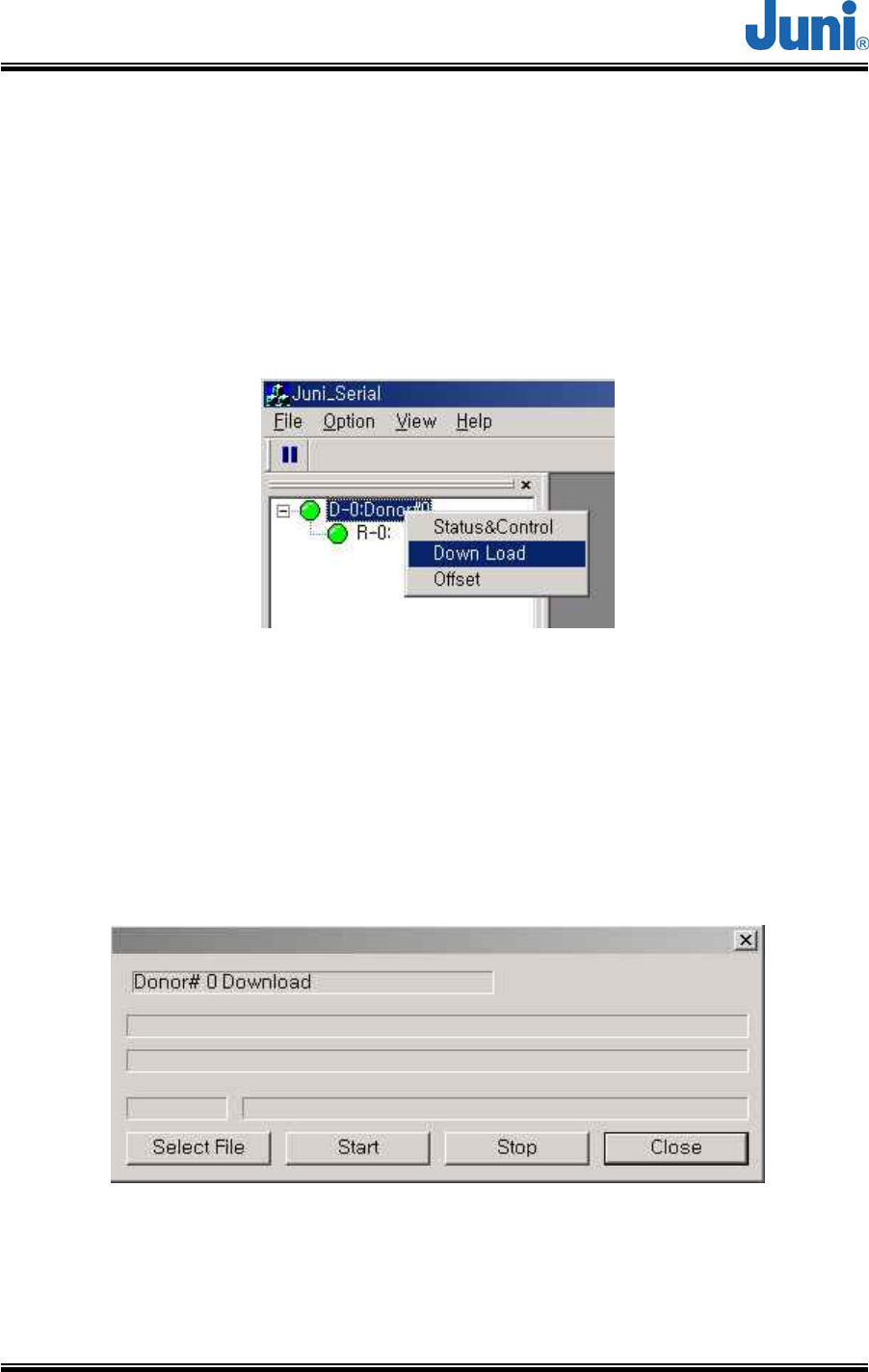
JUNI JF43-E1900/CFN03
CDMA FIBER FED REPEATER OPERATIONS MANUAL
Version 1.17 ⓒ J
uni America Inc. Page 54 of 88
Remote DL ATT: 10 dB
For external attenuator values and internal attenuator settings for DHU BTS power
values of +47dBm and +42dBm, please refer to the diagrams in Appendix B.
4.2.7 Repeater Download
[Figure 4.12] Select “Download”
In order to download a new firmware version to a repeater, right-click the desired
repeater and select “Down Load” from the drop down menu as illustrated in Figure
4.10 above. This will generate a new Download window as shown in Figure 4.11
below.
[Figure 4.13] Download Window
Click “Select File” button to display the Open File window as shown in Figure 4.12
below.
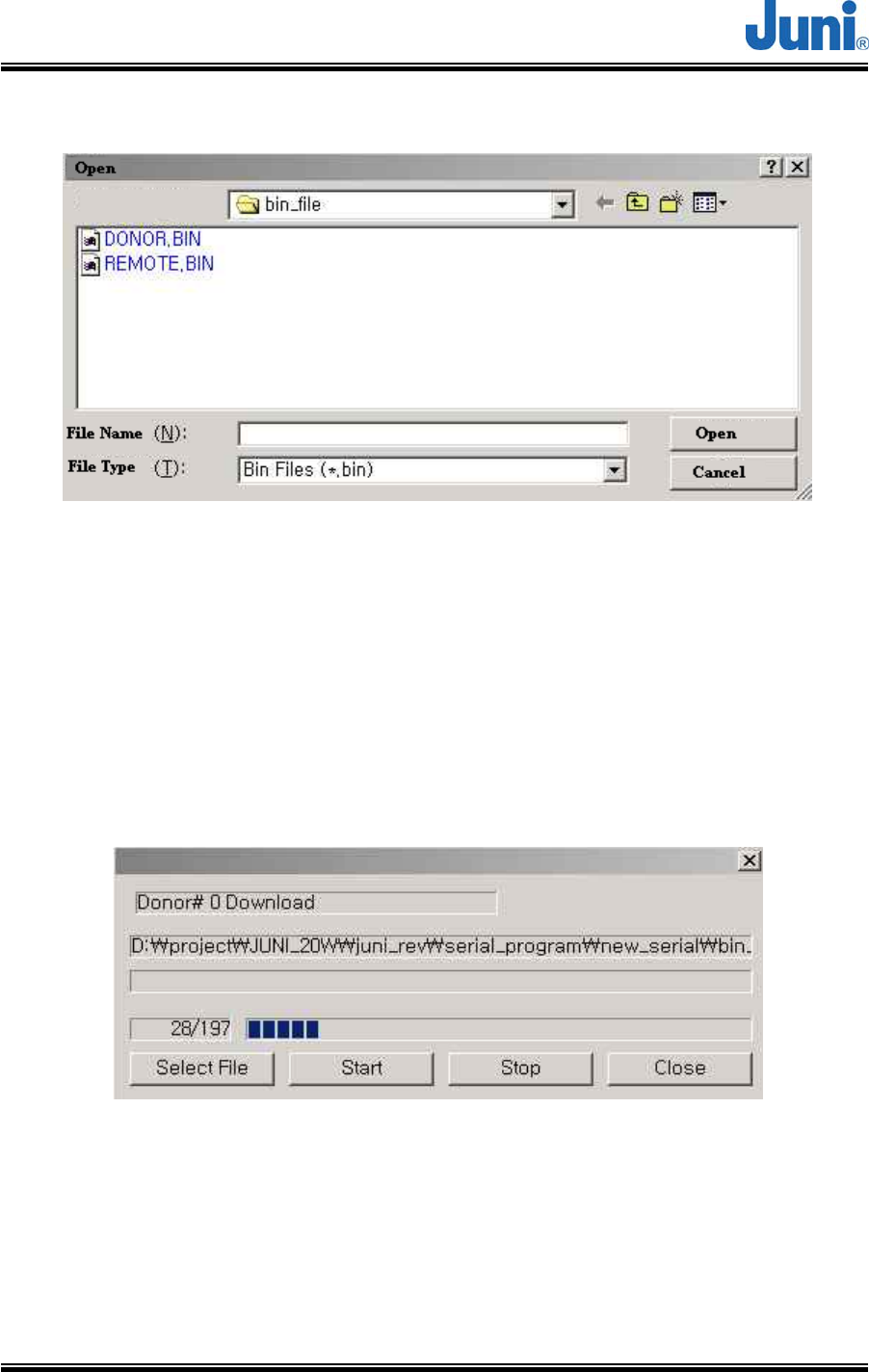
JUNI JF43-E1900/CFN03
CDMA FIBER FED REPEATER OPERATIONS MANUAL
Version 1.17 ⓒ J
uni America Inc. Page 55 of 88
[Figure 4.14] Open File Window
Locate the desired file to download and click the “Open” button. Then click the “Start”
button as illustrated in Figure 4.13 to initiate the download process. The monitoring
of the download progress may be viewed via the Download bar displayed on the
download window. If the “Stop” button is pressed during the download process, the
program returns to the original program installed prior to the download process.
[Figure 4.15] File downloading
Click the “OK” button at the end of the download as illustrated below in Figure 4.14,
to confirm the completion of the download process.
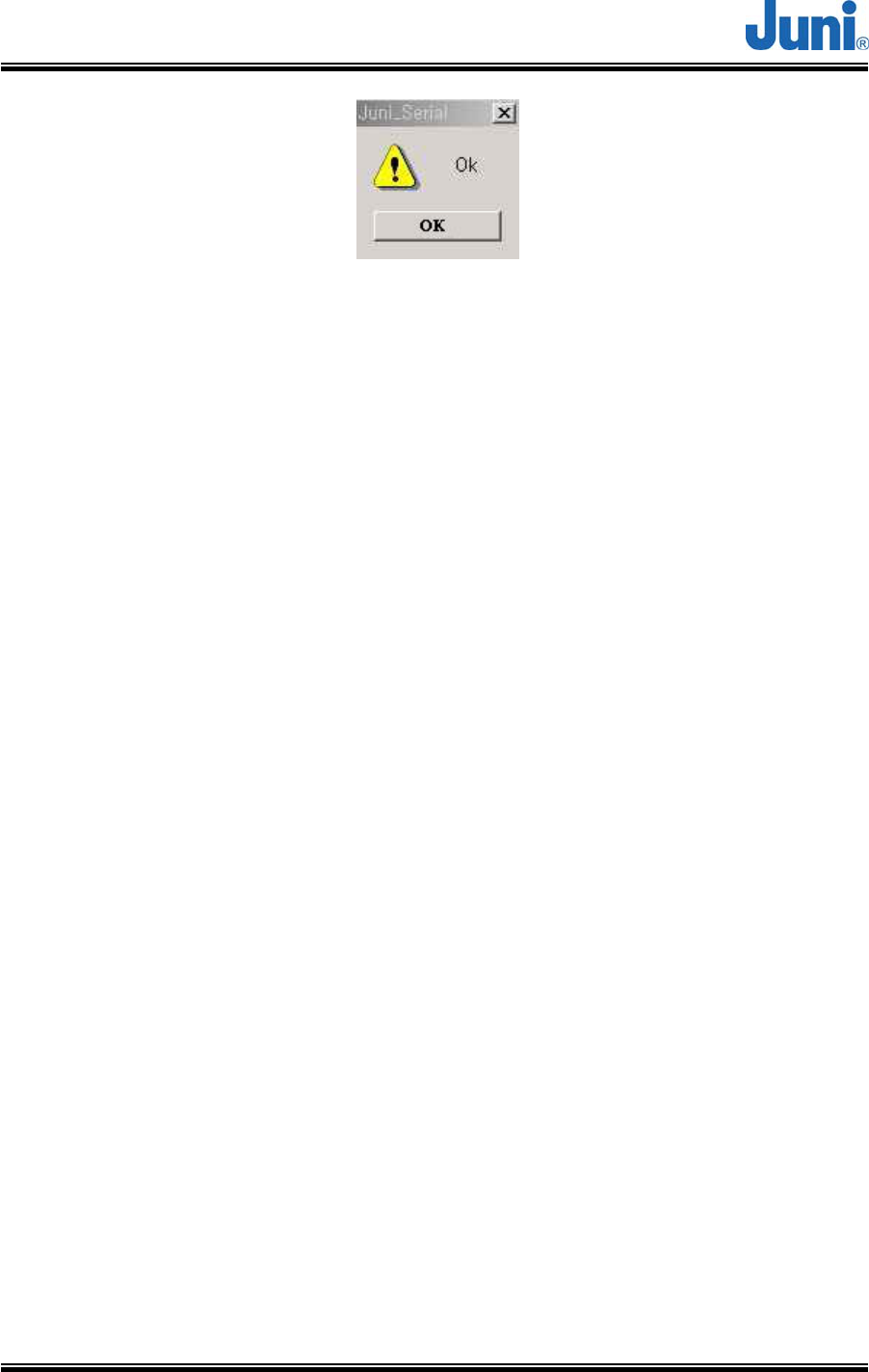
JUNI JF43-E1900/CFN03
CDMA FIBER FED REPEATER OPERATIONS MANUAL
Version 1.17 ⓒ J
uni America Inc. Page 56 of 88
[Figure 4.16] Download Complete Confirmation
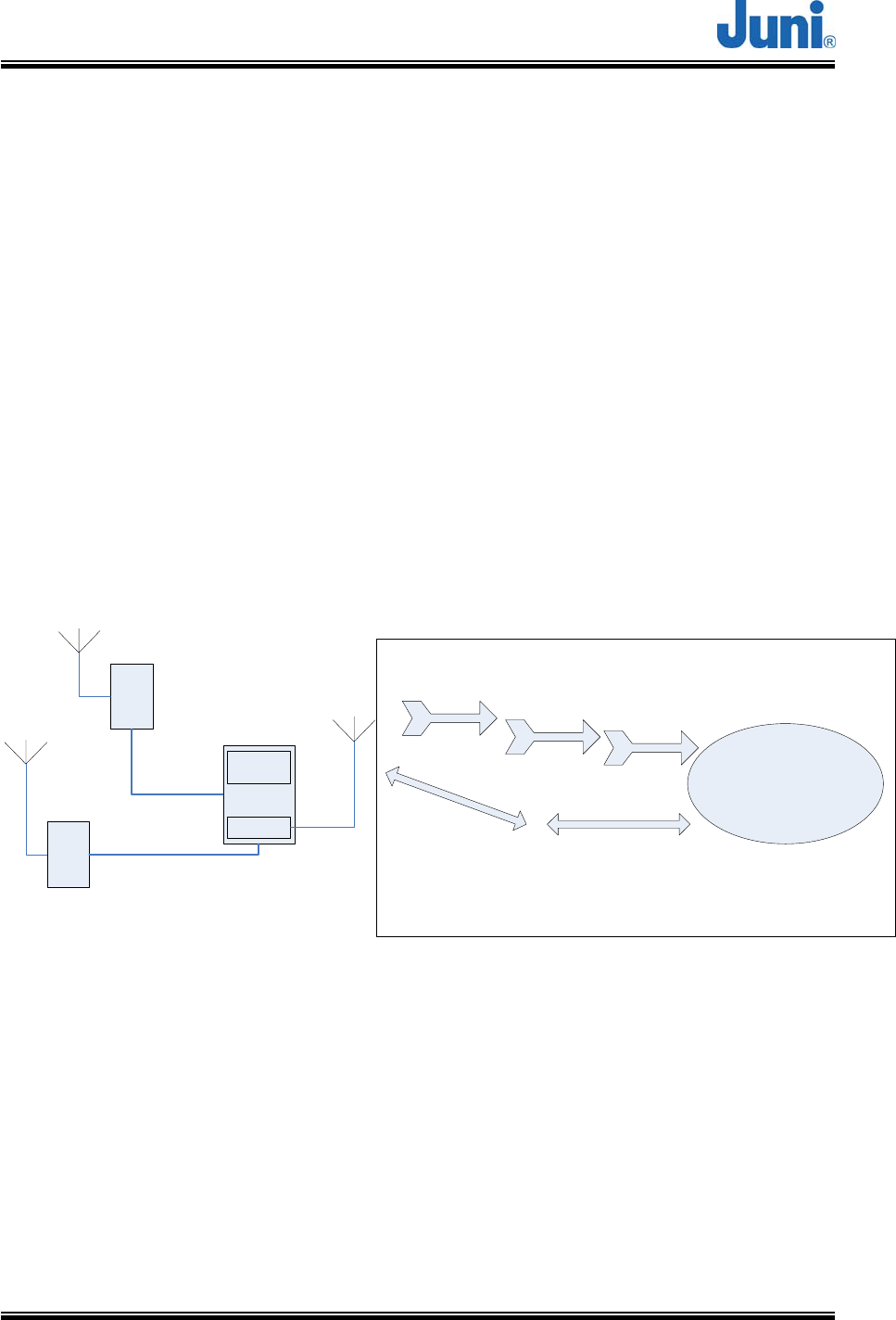
JUNI JF43-E1900/CFN03
CDMA FIBER FED REPEATER OPERATIONS MANUAL
Version 1.17 ⓒ J
uni America Inc. Page 57 of 88
4.3 SNMP Operation
4.3.1 Introduction
The DHU utilizes a wireless CDMA modem connected to the SNMP agent to transmit
SNMP traps and informs to a central Sprint EMS (Element Management Server) on
the Sprint private network. The traps, or commonly referred to as a heartbeat, are
sent at an interval of every 20 minutes and it a method of notifying the EMS that the
repeater is still connected to the network and is functioning correctly. Informs are
transmitted when an alarm at a RU occurs. The inform is sent to the EMS providing
information on the type of alarm that has occurred and which repeater it originates
from.
DU
RU
RU
MCU
Heartbeat
SNMP Heartbeats transmitted every
20 minutes
Wireless
modem
Remote Units are monitored
at the Donor Unit via the fiber
link. The SNMP agent located
in the MCU generates the
heartbeats for transmission
The wireless modem is
registered to Sprint’s
private network in order to
allow the Donor Unit to
transmit heartbeats and
alarms to the EMS
SNMP alarms transmitted
whenever alarms occur with an
acknowledgement sent by the
EMS
Alarms
Alarms
Sprint Private Network
Sprint EMS
Heartbeat Heartbeat
[Figure 4.17] SNMP Operation Overview
4.3.2 Connection Setup for PC to Donor Unit MCU (Master Control Unit)
Connect a RS232C cable from the PC directly to the SNMP debug port on the MCU.
Open HyperTerminal in Windows and create a new connection. Enter a session name
and press OK.
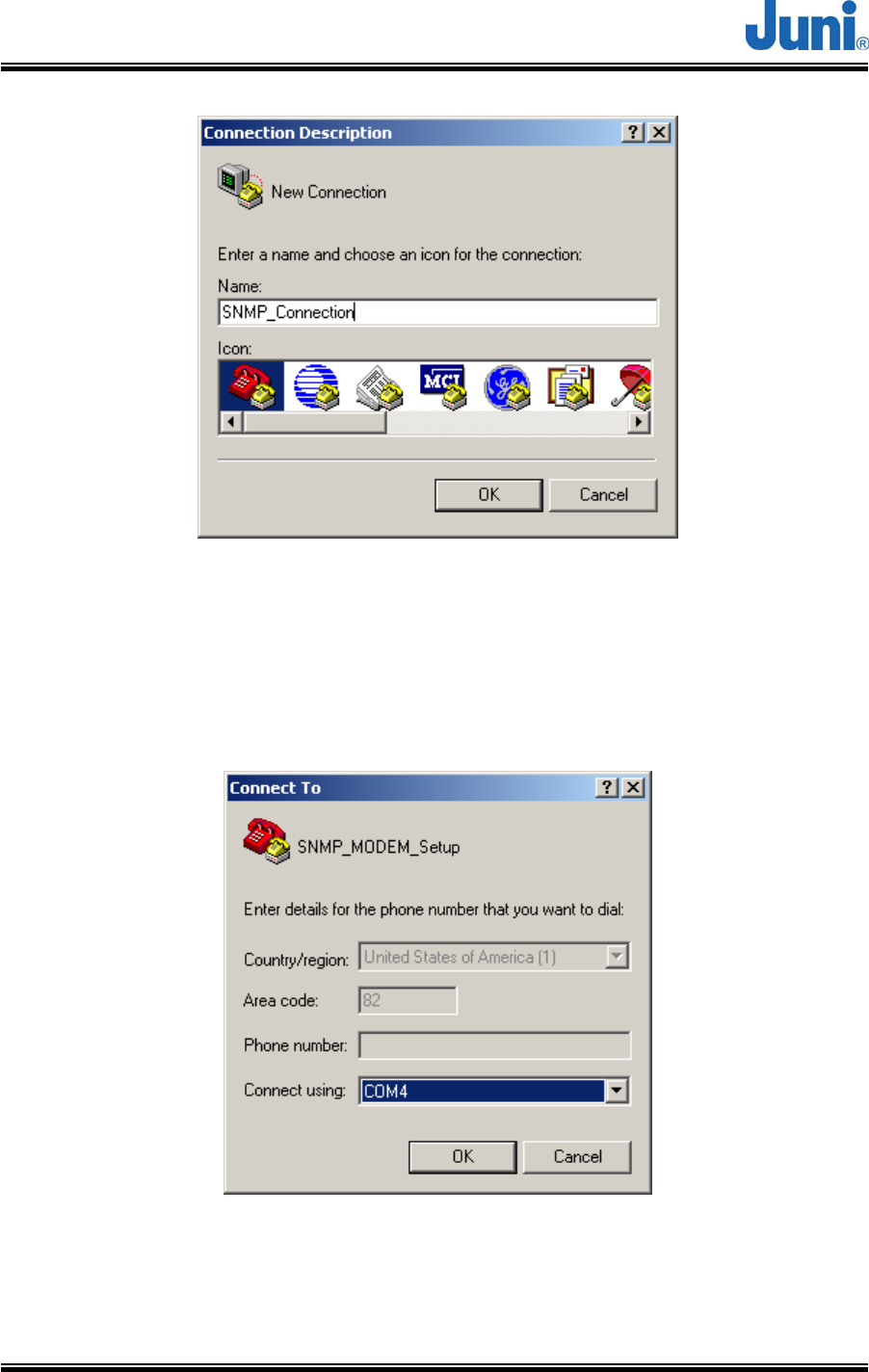
JUNI JF43-E1900/CFN03
CDMA FIBER FED REPEATER OPERATIONS MANUAL
Version 1.17 ⓒ J
uni America Inc. Page 58 of 88
[Figure 4.18] HyperTerminal New Connection
Choose the COM port to which the MCU is connected on the PC and press OK. In
this example the modem is connected to COM port 4.
[Figure 4.19] Connection Settings
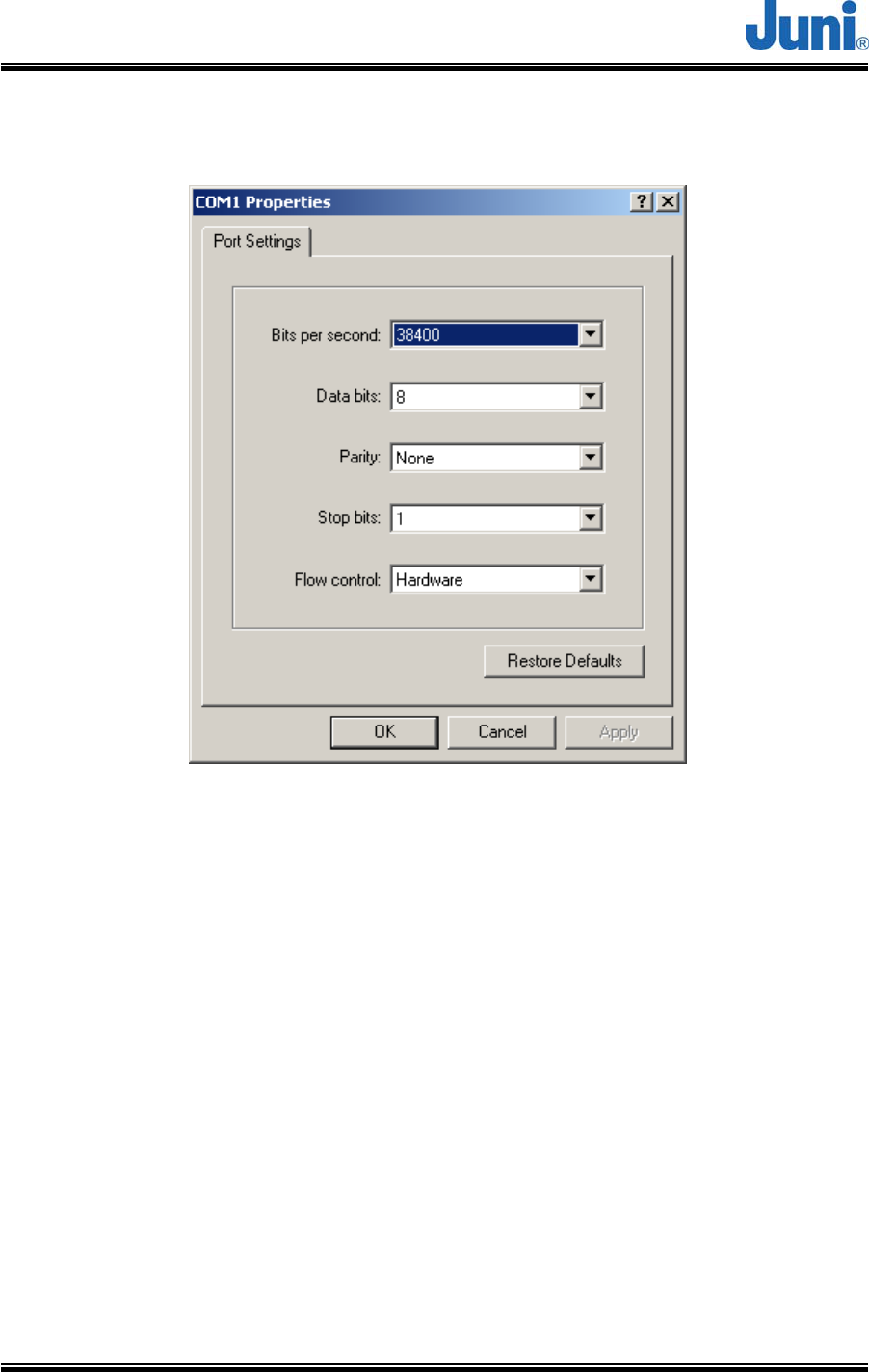
JUNI JF43-E1900/CFN03
CDMA FIBER FED REPEATER OPERATIONS MANUAL
Version 1.17 ⓒ J
uni America Inc. Page 59 of 88
Choose 38400 Bits Per Second and press OK to enable communication with the
MCU.
[Figure 4.20] Connection Settings
The session is created and HyperTerminal is now connected to the DHU MCU.
Click on File->Properties and on the window select the settings tab.
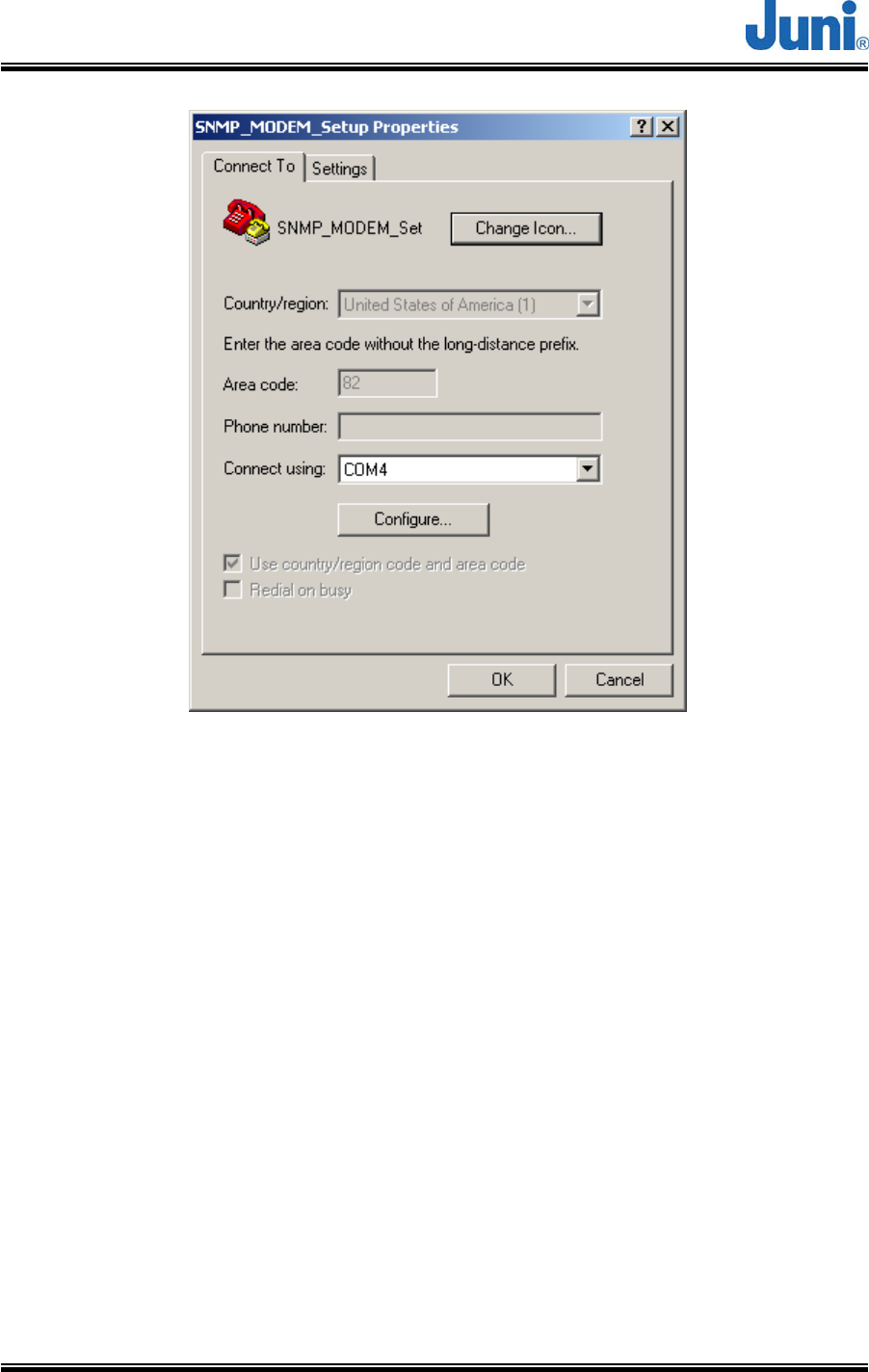
JUNI JF43-E1900/CFN03
CDMA FIBER FED REPEATER OPERATIONS MANUAL
Version 1.17 ⓒ J
uni America Inc. Page 60 of 88
[Figure 4.21] Connection Settings
With the settings tab selected, select ANSIW for the emulation and press OK.
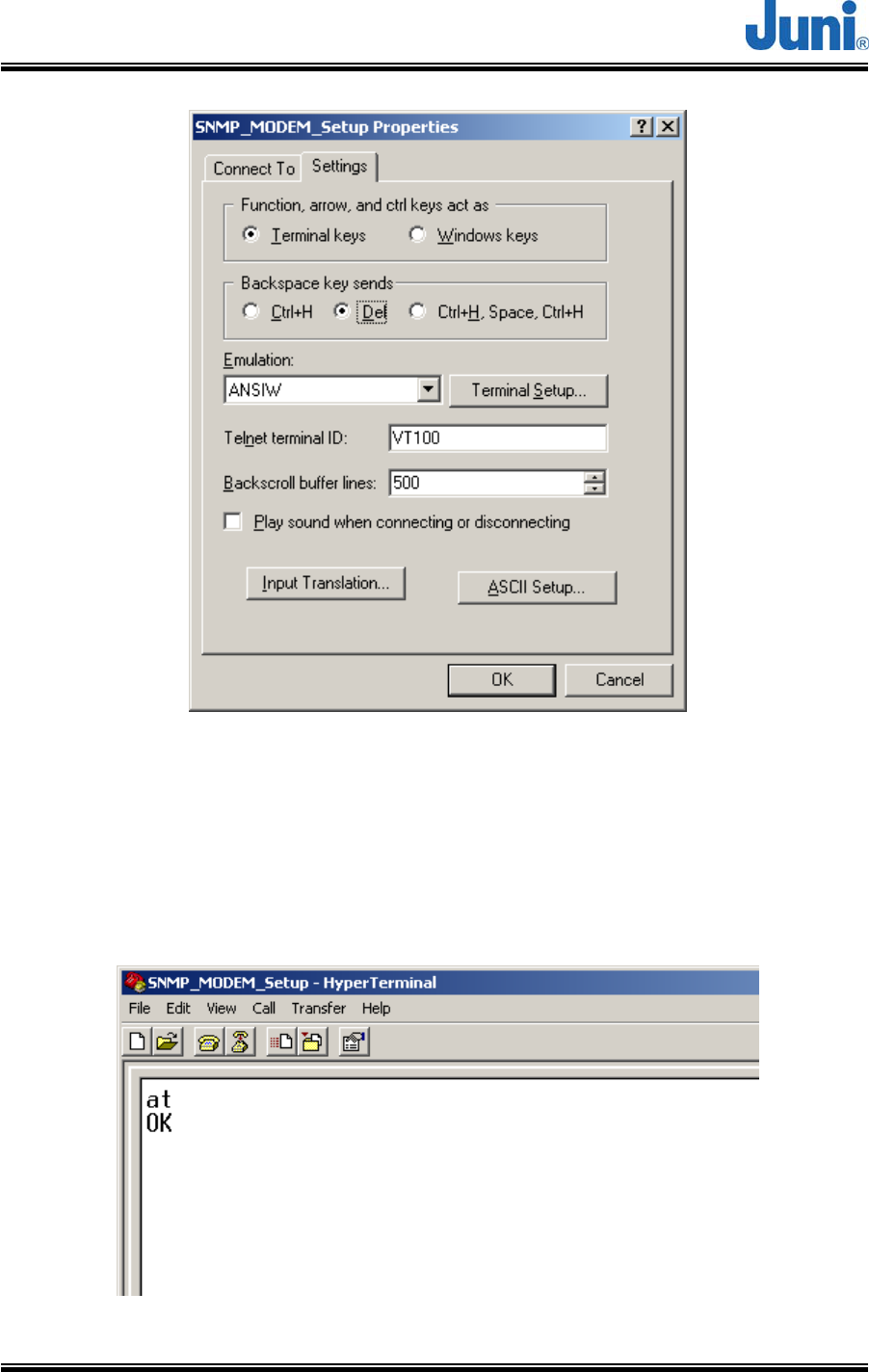
JUNI JF43-E1900/CFN03
CDMA FIBER FED REPEATER OPERATIONS MANUAL
Version 1.17 ⓒ J
uni America Inc. Page 61 of 88
[Figure 4.22] Connection Settings
The session will now allow characters to be typed into the screen in a human
readable format. Type “at” or “AT” into the window and an “OK” response should be
displayed. This means a direct connection to the MCU has been established and AT
commands can now be entered.
[Figure 4.23] Connection Established with Response from Modem
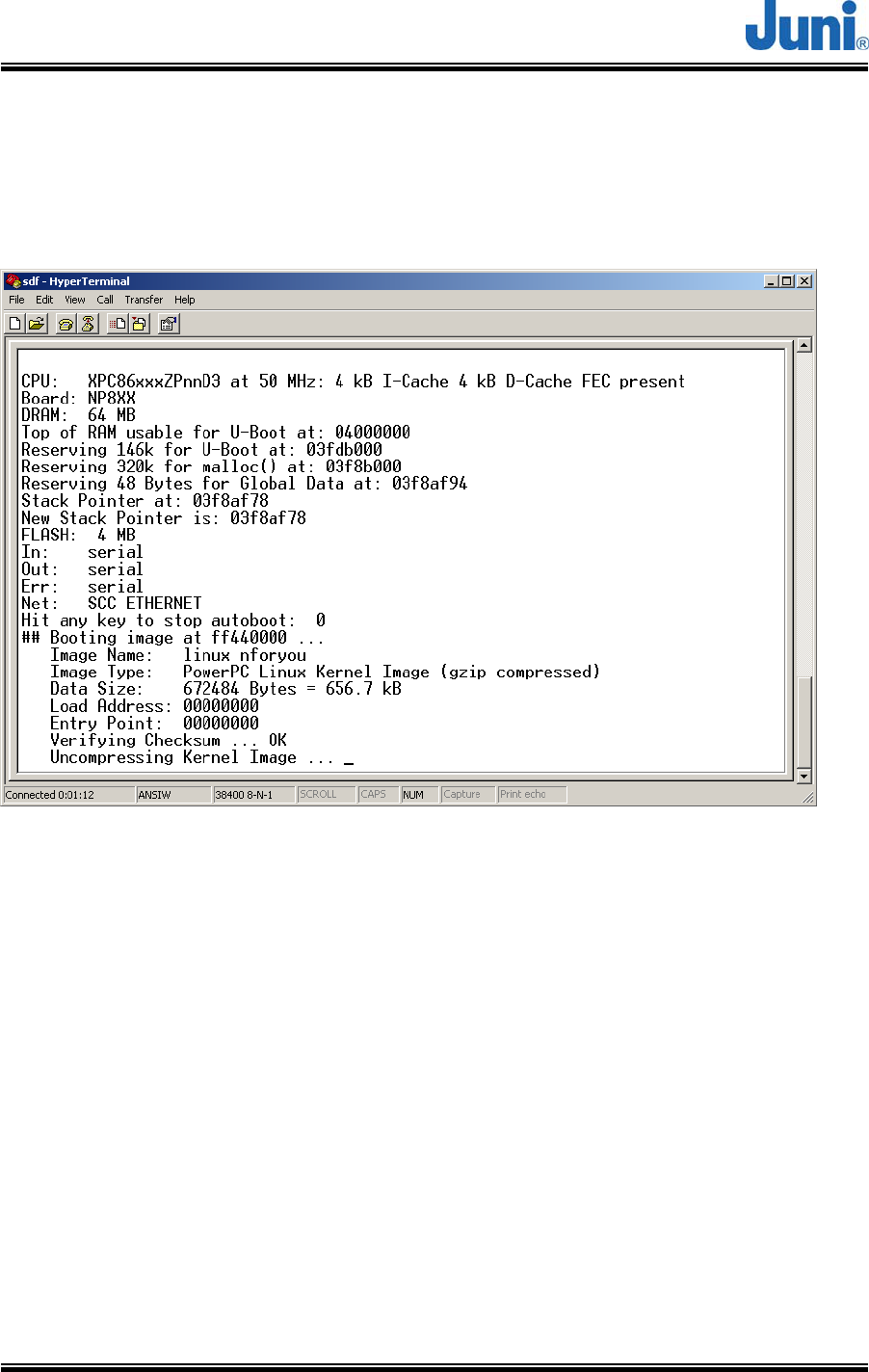
JUNI JF43-E1900/CFN03
CDMA FIBER FED REPEATER OPERATIONS MANUAL
Version 1.17 ⓒ J
uni America Inc. Page 62 of 88
The HyperTerminal should now be ready to accept user input from the keyboard.
Once the PC is connected to and can access the MCU, it will display a LINUX
command shell such as the figure below.
[Figure 4.24] MCU Start-up Screen Output
If the screen is blank, press the enter key and a tilde pound (to #) command will be
displayed. This means that the MCU is ready to accept input.
Please refer to the next section to view and alter settings on the MCU.
4.3.3 View and Change SNMP Destination IP
To view and change the SNMP destination IP, the PC should be connected to the
MCU via a RS232C cable. With the “to #” command displayed, type in “snmptool” to
display the following menu.
Note: Any changes made other than the ones listed below can prevent the
SNMP from functioning properly.
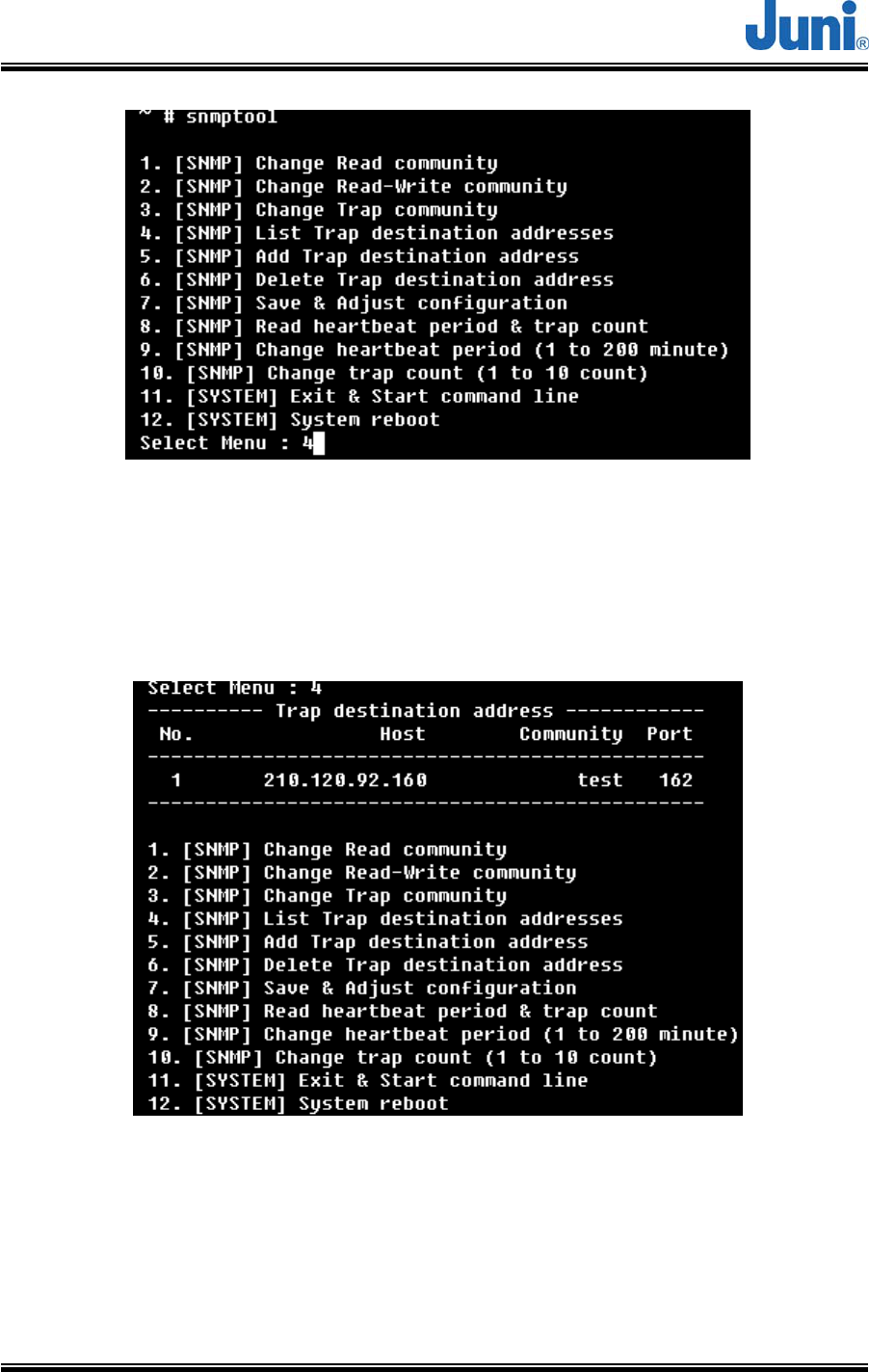
JUNI JF43-E1900/CFN03
CDMA FIBER FED REPEATER OPERATIONS MANUAL
Version 1.17 ⓒ J
uni America Inc. Page 63 of 88
[Figure 4.25] SNMP Menu
Press 4 and then enter. This will display all the IP addresses to which the traps and
informs will be sent.
[Figure 4.26] Display Trap Destination
To enter another or new trap destination address, press 5 at the menu and enter the
new IP, community and port separated by a space such as the figure below. To exit
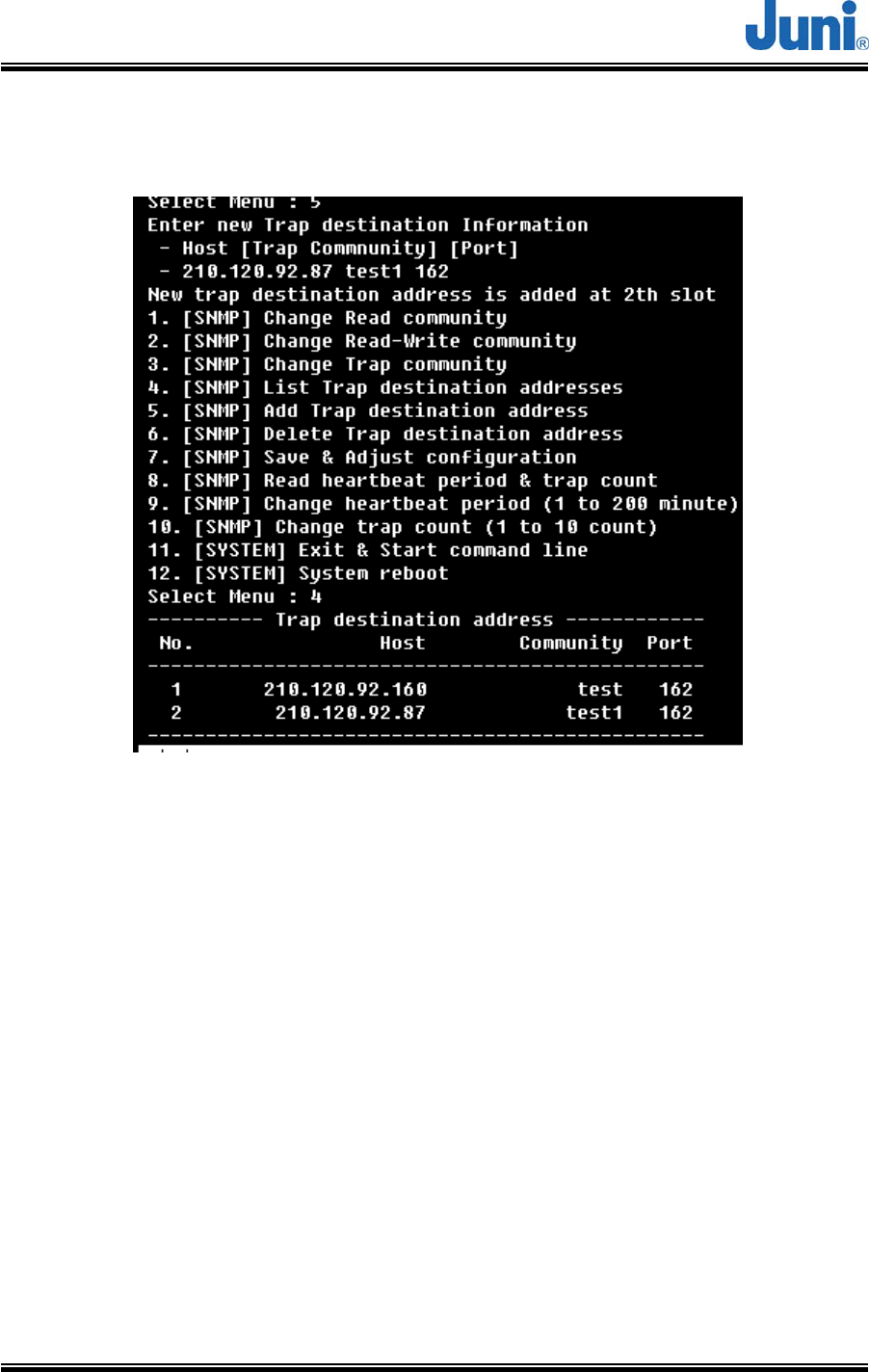
JUNI JF43-E1900/CFN03
CDMA FIBER FED REPEATER OPERATIONS MANUAL
Version 1.17 ⓒ J
uni America Inc. Page 64 of 88
without entering an IP, leave the line blank and enter.
[Figure 4.27] Add Trap Destination
To delete a destination IP, enter 4 to view all the list of IP’s and the slot number
associated with the IP address. Enter 6 to enter deletion mode and enter the desired
slot number.
Once all necessary changes have been made to the IP, press 7 to save and then 11
to return to the normal command prompt.
4.3.4 Downloading SNMP History Log
The FFR DHU supports remote downloading of logs via FTP provided the system has
been set up accordingly to the previous sections.
Downloading the logs can be done on any computer as long as an internet
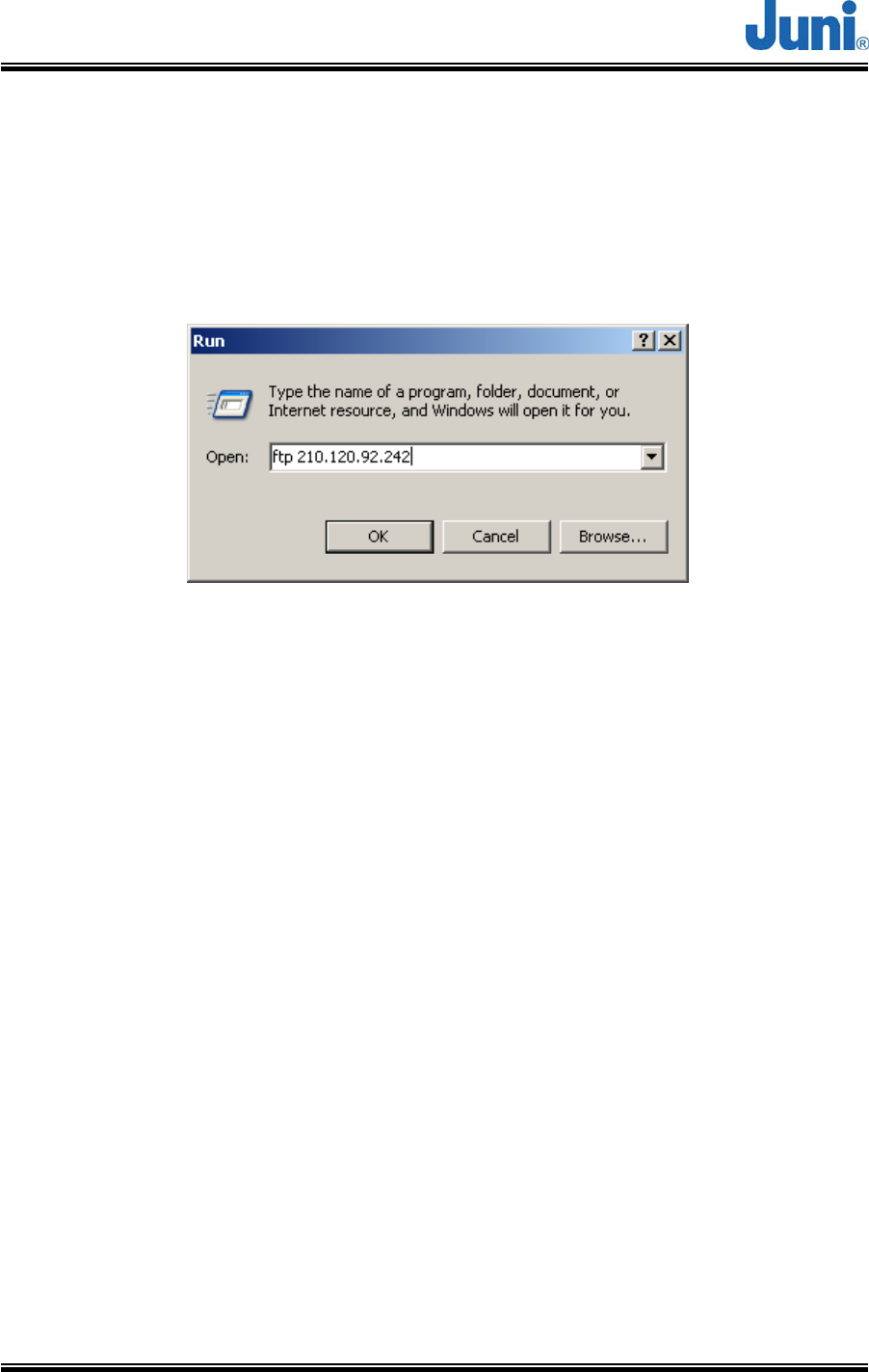
JUNI JF43-E1900/CFN03
CDMA FIBER FED REPEATER OPERATIONS MANUAL
Version 1.17 ⓒ J
uni America Inc. Page 65 of 88
connection is available.
Open “Run” in the windows start menu and type in “ftp <IP>”, where <IP> is the IP
address assigned to the DHU. An IP of 210.120.92.242 is used as an example in the
figure below.
[Figure 4.28] FTP access to Donor Unit
The username and password to log onto the FTP is:
Username: ftp
Password: <blank> (no password required)
To download the logs, enter the following commands in the exact given order.
> lcd c:\
> cd mp202
> get history_log
> get history_snmp_log
> quit
Figure 4.27 shows the response from the FTP server after each command.
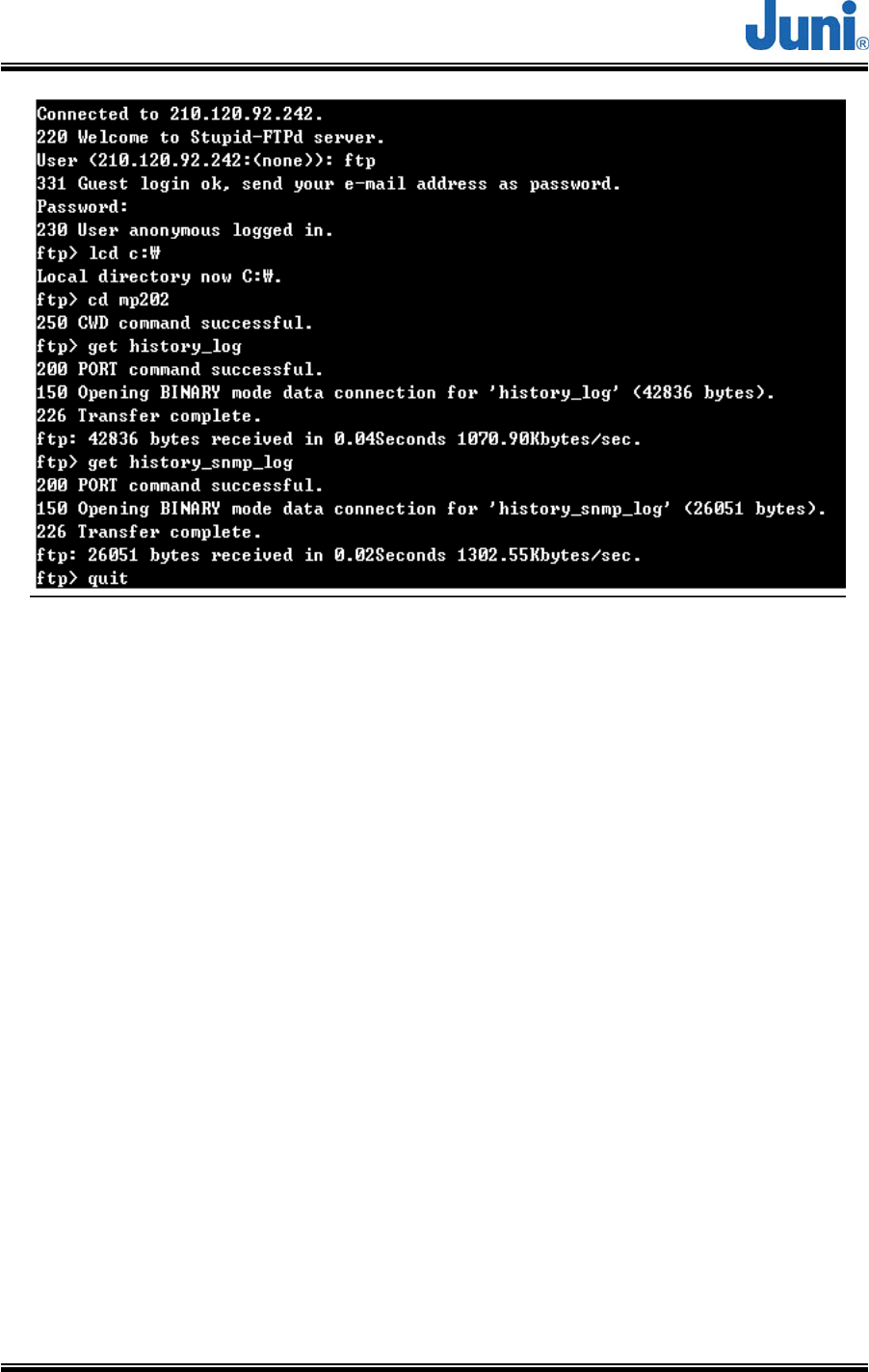
JUNI JF43-E1900/CFN03
CDMA FIBER FED REPEATER OPERATIONS MANUAL
Version 1.17 ⓒ J
uni America Inc. Page 66 of 88
[Figure 4.29] FTP Commands
4.3.5 Reading and Understanding the SNMP History Log
Once the log has been downloaded locally to a PC, the information below explains
what each line of the log means.
Sync Time: Sync time setting successful..
(Synchronization of SNMP agent and modem clock)
Snmp notification, Check Network successful, 07/18/05 17:05:52
(SNMP agent checks the Network Connection to determine connectivity)
Snmp notification, go to AT-NOK mode, 07/18/05 15:54:50
(Notification by SNMP agent that it is now entering Network Online Mode)
SEND[1:0] HeartBeat Trap, 07/18/05 16:14:56
(Transmission of first heartbeat (count=0) within one hour timeframe)
SEND[1:1] HeartBeat Trap, 07/18/05 16:34:58
(Transmission of second heartbeat (count=1) within one hour timeframe)
SEND[1:2] HeartBeat Trap, 07/18/05 16:55:01
(Transmission of third heartbeat (count=2) within one hour timeframe)

JUNI JF43-E1900/CFN03
CDMA FIBER FED REPEATER OPERATIONS MANUAL
Version 1.17 ⓒ J
uni America Inc. Page 67 of 88
Snmp notification, go to offline mode, 07/18/05 17:05:03
(Notification by SNMP agent that it is now entering Offline Mode)
Snmp notification, go to AT-OK mode, 07/18/05 17:05:40
(Notification by SNMP agent that it is now entering AT Command Mode)
AT+CSQ?
(Command is used to ascertain the received signal strength <rssi> and the channel
frame rate error <fer>. 255 Represents an unknown signal quality)
+CSQ: 73, 5, 255
(+CSQ: <rssi>,<fer>)
AT+WIND?
(General mechanism to send unsolicited non-standardized indications to the
application)
+WIND: 8
(Indicates that the product is ready to process all AT commands)
Sync Time : Reset Modem H/W
(The modem has retried ten times unsuccessfully to synchronize the SNMP and
modem clock. The modem undergoes a hardware reset to retry synchronizing.)

JUNI JF43-E1900/CFN03
CDMA FIBER FED REPEATER OPERATIONS MANUAL
Version 1.17 ⓒ J
uni America Inc. Page 68 of 88
5. System Maintenance
This section explains the JF43 FFR system fault detection and alarm reporting
system, and provides a method for determining troubleshooting faults.
Maintenance also includes diagnosing and correcting service problems as they occur.
When an alarm is reported, it will be necessary to follow a systematic troubleshooting
procedure to determine the problem. Once the problem has been isolated, the
appropriate corrective measures must be taken to restore service. The only internal
components that can be replaced are the cooling fans which are mounted in the DHU
and RU. All other failed internal components will require Juni engineers to replace and
test the units.
5.1 Periodic Maintenance
The JF43 FFR requires minimal regular maintenance to insure continuous and
optimal operation and performance. However, it is advised that the DHU and RU are
checked often. Components that require regular replacement, cleaning, or testing
include the DHU and RU fans and backup battery. The NEMA 4X enclosure ensures
that the JF43 FFR can withstand all environmental influences. The following two
procedures can also be followed when a fan fails and needs to be replaced.
5.1.1 Donor Unit Fan Maintenance
1. The fan is located above the MCU and is labeled ‘Fan Control Unit’.
2. Unplug the 24V power cable feeding the Fan Control Unit.
3. Unscrew the two multi-turn fasteners on each side of the compartment.
4. Pull out the Fan Control Unit completely from its position.
5. One fan is used to cool the DHU which will require regular maintenance by

JUNI JF43-E1900/CFN03
CDMA FIBER FED REPEATER OPERATIONS MANUAL
Version 1.17 ⓒ J
uni America Inc. Page 69 of 88
cleaning and/or dusting.
6. Once maintenance is complete, return the Fan Control Unit back into its space
and tighten the multi-turn fasteners.
7. Plug the power cable back into the Fan Control Unit.
5.1.2 Remote Unit Fan Maintenance
1. The fan compartment is located at the top of the RU.
2. Turn off the fan at the fan controller.
3. To perform maintenance on the fan for the RU, turn the eye bolts at the top of the
RU a quarter turn to unlock the fan compartment and then slide it out of the RU.
The fan compartment has a draw stud which latches onto a predefined hole to
prevent the fan compartment from falling out.
4. Pull out the fan compartment firmly to release the stud from its hole. Do not pull
on it too hard as a 24V power cable is directly connected to the fan compartment.
5. There are two fans in the compartment which is required to be cleaned and
checked regularly to ensure proper operation of the fan and allow the fan to
perform its duty in cooling the RU.
6. At the completion of the maintenance, return the fan compartment by sliding it
back into its designated placement.
5.2 Fault Detection and Alarm Reporting
The JF43 FFR on board embedded software detects various unit and system faults
which generate either a Major or Minor alarm. A major alarm indicates that the
repeater has failed in a way that directly affects RF transport performance. When a
major alarm occurs, all RF functions are affected and will cause the system to be out
of service. A minor alarm means that the system performance is not affected, or in
some cases, that the performance may no longer be optical. When a minor alarm
occurs, RF functions continue and the system remains in service.

JUNI JF43-E1900/CFN03
CDMA FIBER FED REPEATER OPERATIONS MANUAL
Version 1.17 ⓒ J
uni America Inc. Page 70 of 88
The following means are used to report major and minor alarms.
• DHU, RU LED’s
• LMT software Graphical User Interface (GUI)
The DHU and RU front panel LED indicators show status and alarm information by
displaying various colors; green, red and off.
The LMT software GUI provides both a summary and detailed list of alarm
information that includes unit and module level faults, circuit faults, and measured
value faults such as voltages, RF power and temperature.
INDICATOR COLOR DONOR UNIT DESCRIPTION
AC FAULT
Green □
Red □
Indicates the status of the main input power
The DC power source is on
The DC power source is off
DC FAULT
Green □
Red □
Indicates the status of the DHU DC power
supply
The power supply is normal
The power supply has failed due to faulty circuit or
connection
FAN FAULT
Green □
Red □
Indicates the status of the FAN on the DHU
The fan is normal
The fan has failed
BATT. FAULT
Green □
Red □
Indicates the status of the backup battery
The battery is functioning normally
The battery has failed or is not providing power
ENVIRONMENT
DOOR OPEN
Green □
Red □
Indicates the status of the door on the DHU
The door is closed
The door is open

JUNI JF43-E1900/CFN03
CDMA FIBER FED REPEATER OPERATIONS MANUAL
Version 1.17 ⓒ J
uni America Inc. Page 71 of 88
HI TEMP
Green □
Red □
Indicates if the DHU is over temperature
The temperature is within the normal range
The temperature is above the normal operating
temperature
LOW TEMP
Green □
Red □
Indicates if the DHU is under temperature
The temperature is within the normal range
The temperature is below the normal operating
temperature
LD FAULT
Green □
Red □
Indicates whether the Laser Diode is detecting
any optic output power
The optic output power is normal
The optic output power is abnormal
PD FAULT
Green □
Red □
Indicates whether the Photo Diode is detecting
any optic input power
The optic input power is normal
The optic input power is abnormal
OPTIC
OPTIC RF
FAULT
Green □
Red □
Indicates the state of the amplifier of the optic
module
The amplifier is functioning normally
The amplifier has failed or the RF power output
has shutdown
DL
DL RF FAULT
Green □
Red □
Indicates the state of the downlink amplifier
The amplifier is functioning normally
The amplifier has failed or the RF power output
has shutdown
LOCAL AMP
UL0 RF
FAULT
Green □
Red □
Indicates the state of the Uplink0 amplifier
The amplifier is functioning normally
The amplifier has failed or the RF power output
has shutdown

JUNI JF43-E1900/CFN03
CDMA FIBER FED REPEATER OPERATIONS MANUAL
Version 1.17 ⓒ J
uni America Inc. Page 72 of 88
UL1 RF
FAULT
Green □
Red □
Indicates the state of the Uplink1 amplifier
The amplifier is functioning normally
The amplifier has failed or the RF power output
has shutdown
UL1 LOCK
FAULT
Green □
Red □
Indicates the state of the Rx Local Oscillator
(in the optic module)
The UL1 local oscillator is normal
The Rx local oscillator has lost phase lock and
may have a frequency error
LOCAL AMP
Green □
Red □
Indicates the state of the local amplifier
The amplifier is functioning normally
The amplifier has failed or the RF power output
has shutdown
SAW
SAW LOCAL
FAULT
Green □
Red □
Indicates the state of the downlink SAW local
oscillator
The local oscillator is normal
The local oscillator (in the SAW Tx module) has
lost phase lock and may have a frequency error
[Table 5.1] Donor Unit Alarm Items
INDICATOR COLOR REMOTE UNIT DESCRIPTION
AC
FAULT
Green □
Red □
Indicates the status of the main input power
The DC power source is on
The DC power source is off
ENVIRONEMNT
DC
FAULT
Green □
Red □
Indicates the status of the RU DC power supply
The power supply is normal
The power supply has failed due to faulty circuit or
connection

JUNI JF43-E1900/CFN03
CDMA FIBER FED REPEATER OPERATIONS MANUAL
Version 1.17 ⓒ J
uni America Inc. Page 73 of 88
FAN0
FAULT
Green □
Red □
Indicates the status of FAN 0 on the RU
The fan is normal
The fan has failed
FAN1
FAULT
Green □
Red □
Indicates the status of FAN 1 on the RU
The fan is normal
The fan has failed
BATT.
FAULT
Green □
Red □
Indicates the status of the backup battery
The battery is functioning normally
The battery has failed or is not providing power
DOOR
OPEN
Green □
Red □
Indicates the status of the door on the RU
The door is closed
The door is open
HI TEMP
Green □
Red □
Indicates if the RU is over temperature
The temperature is within the normal range
The temperature is above the normal operating
temperature
LOW
TEMP
Green □
Red □
Indicates if the RU is under temperature
The temperature is within the normal range
The temperature is below the normal operating
temperature
LD
FAULT
Green □
Red □
Indicates whether the Laser Diode is detecting
any optic output power
The optic output power is normal
The optic output power is abnormal
OPTIC
PD
FAULT
Green □
Red □
Indicates whether the Photo Diode is detecting
any optic input power
The optic input power is normal
The optic input power is abnormal

JUNI JF43-E1900/CFN03
CDMA FIBER FED REPEATER OPERATIONS MANUAL
Version 1.17 ⓒ J
uni America Inc. Page 74 of 88
OPTIC
RF
FAULT
Green □
Red □
Indicates the state of the amplifier of the optic
module
The amplifier is functioning normally
The amplifier has failed or the RF power output has
shutdown
OVER
POWER
Green □
Red □
Indicates whether the PA is above the optimal
power level
The power level is below the normal operating level
The power level is above the normal operating level
OVER
TEMP.
Green □
Red □
Indicates if the DHU is over temperature
The RU is operating at correct temperature
The RU is above the normal operating temperature
VSWR
Green □
Red □
Indicates if the power amplifier VSWR is above or
below the threshold
The VSWR is below the threshold
The VSWR is above the threshold
DC FAIL
Green □
Red □
Indicates the status of the RU DC power supply
The RU power supply is operating normally
The power supply has failed due to fault in circuitry or
connection
POWER AMPLIFIER (PA)
LINK
FAIL
Green □
Red □
Indicates the link status between the RSM and PA
The link is operating normally
The link between the RSM and PA is broken. Check
modules and link connections
FWD OUTPUT
POWER
HI
POWER
Green □
Red □
Indicates if the PA is above the normal operating
power level
The power level is within the normal range
The power level is above the normal threshold

JUNI JF43-E1900/CFN03
CDMA FIBER FED REPEATER OPERATIONS MANUAL
Version 1.17 ⓒ J
uni America Inc. Page 75 of 88
LO
POWER
Green □
Red □
Indicates if the PA is below the normal operating
power level
The power level is within the normal range
The power level is below the normal threshold
DL/UL
AMP
FAULT
Green □
Red □
Indicates if the uplink or downlink is normal or
has failed
The UL/DL amp is normal
The UL/DL amp has died or shutdown
UL0/1
LNA
Green □
Red □
Indicates the status of the UL0 Low Noise
Amplifier
The UL0/1 LNA is normal
The UL0/1 LNA is not functioning correctly. Check the
module gain
UL0/1
SAW
AMP
FAULT
Green □
Red □
Indicates the status of the UL0/1 SAW amplifier
The UL0/1 SAW amp is functioning correctly
The UL0/1 SAW amp is not functioning correctly.
Check the module gain
SAW
LOCAL
AMP
FAULT
Green □
Red □
Indicates the status of the local drive amplifier
The local amplifier is normal
The local amplifier is faulty. Check the frequency of
the output signal.
RF
SAW
LOCAL
LOCK
FAULT
Green □
Red □
Indicates the status of the local oscillator
The local oscillator is normal
The local oscillator (in the SAW module) has lost
phase lock and may have a frequency error
[Table 5.2] Remote Unit Alarm Items

JUNI JF43-E1900/CFN03
CDMA FIBER FED REPEATER OPERATIONS MANUAL
Version 1.17 ⓒ J
uni America Inc. Page 76 of 88
5.3 Trouble Shooting for the Donor Unit
Module Alarm Possible
Reason Action Required Action (If problem
persists)
LD LD Fault - Change LD Send back to Juni for
Repair
PD Bad optic input
level
- Inspect optic input level
and check the optic line
- Clean optic connector
- Change the PD module
Send back to Juni for
Repair
Optic
Optic RF
fault
Optic module
AMP Fault Change the Module Send back to Juni for
Repair
UL0 RF
fault
UL0 path AMP
Fault
- Check the module gain
- Change the Module
Send back to Juni for
Repair
UL
UL1 RF
fault
UL1 path AMP
Fault
- Check the module gain
- Change the module
Send back to Juni for
Repair
Local
AMP
UL1 local
signal path
AMP Fault
- Check the Local signal
output level
- Change the module
Send back to Juni for
Repair
UL1 rock
fault
UL1 local
signal Fault
- Check the frequency of
output signal
- Change the module
Send back to Juni for
Repair
SAW
SAW
local fault
Local drive
AMP fault
- Check local oscillator
signal in the SAW module
AC fault AC Voltage
Fault
- Check AC voltage
- Change PSU
Send back to Juni for
Repair
DC fault DC Voltage
Fault
- Check DC voltage
- Check Battery voltage
- Change PSU
Send back to Juni for
Repair
BATT
fault
When there is
no battery
- Check Battery cable
- Change PSU
Send back to Juni for
Repair
Fan fault Fan Fault - Check Fan
- Change Fan
Send back to Juni for
Repair
Door
open Door open
- Check Door
- Check the cable of door
switch
- Change MUC
Send back to Juni for
Repair
Hi temp
When temp is
higher than
upper limit
- Check temperature and
limit
- Inspect the reason of
temp increase(ex. Fan or
over power)
Environment
Low temp
When temp is
lower than
lower limit
- Check temperature and
limit
- Inspect the reason of
temp decrease
[Table 5.3] Donor Unit Trouble Shooting Guide

JUNI JF43-E1900/CFN03
CDMA FIBER FED REPEATER OPERATIONS MANUAL
Version 1.17 ⓒ J
uni America Inc. Page 77 of 88
5.4 Trouble Shooting for the Remote Unit
Module Alarm Possible Reason Action Required Action (If problem
persists)
LD LD Fault Change LD Send back to Juni for
Repair
PD Bad optic input
level
- Inspect optic input
level and check the
optic line
- Clean optic connector
- Change the PD
module
Send back to Juni for
Repair
Optic
Optic RF
fault
Optic module
AMP Fault - Change the Module Send back to Juni for
Repair
DL/UL
AMP
fault
DL/UL Drive
AMP Fault
- Check the module gain
- Change the Module
Send back to Juni for
Repair
RF
UL0/1
LNA fault LNA AMP Fault - Check the module gain
- Change the module
Send back to Juni for
Repair
UL0/1
SAW
AMP
fault
UL0/1 SAW AMP
Fault
- Check the module gain
- Change the module
Send back to Juni for
Repair
SAW
local lock
fault
SAW local signal
Fault
- Check the frequency
of output signal
- Change the module
Send back to Juni for
Repair
SAW
SAW
local fault
Local drive AMP
Fault
- Check local signal
level
- SAW local signal
AC fault AC Voltage Fault - Check AC voltage
- Change PSU
Send back to Juni for
Repair
DC fault DC Voltage Fault
- Check DC voltage
- Check Battery voltage
- Change PSU
Send back to Juni for
Repair
BATT
fault
When there is no
battery
- Check Battery cable
- Change PSU
Send back to Juni for
Repair
Fan fault Fan Fault - Check Fan
- Change Fan
Send back to Juni for
Repair
Door
open Door open
- Check Door
- Check the cable of
door switch
- Change MCU
Send back to Juni for
Repair
Environment
Hi temp
When temp is
higher than
upper limit
- Check temperature
and limit
- Inspect the reason of
temp increase(ex. Fan
or over power)

JUNI JF43-E1900/CFN03
CDMA FIBER FED REPEATER OPERATIONS MANUAL
Version 1.17 ⓒ J
uni America Inc. Page 78 of 88
Low
temp
When temp is
lower than lower
limit
- Check temperature
and limit
- Inspect the reason of
temp decrease
Over
Power
Alarm:
>46dBm±0.5dB
Shutdown:
>47dBm±0.5dB
- Check input level
- Check output level
Over Temp
Alarm: 80to85°C
Shutdown:
>85°C
Auto recovery:
<75°C
- Check temp
- Check Fan
- Check LPA output
power level
VSWR
Alarm: <10dB
(return loss)
Shutdown: <6dB
(@output power
30to47dBm)
- Check cables after
LPA
- Check duplex filter
- Check antenna
- Change LPA
Send back to Juni for
repair if problem
continues
DC
Fai
l
≤ 19.5V DC or
≥ 30.5V DC - Check DC power
Link
Fail
No
communication
with RSM
- Check Data Cable
- Check connector
PA
PA on/off @LPA power off - Change LPA Send back to Juni for
Repair
Hi Power
When output
power is higher
than upper limit
- Check output power
level
- Check setting limit
Forward
Output
Power
Lo Power
When output
power is lower
than lower limit
- Check output power
level
- Check setting limit
[Table 5.4] Remote Unit Trouble Shooting Guide

JUNI JF43-E1900/CFN03
CDMA FIBER FED REPEATER OPERATIONS MANUAL
Version 1.17 ⓒ J
uni America Inc. Page 79 of 88
7. System Maintenance
Technical service support can be received by utilizing the following means during
business hours PST:
Technical Assistance: 1-425-702-0848
Technical Support email: support@juniamerica.com
Letters can sent to request information and can be directed to the following address:
Attn: Juni JF-43 Technical Group
9825 Willows Rd NE #100,
Redmond, WA, 98052, USA
Prior to making a call or request, please have the following pieces of information
ready to speed up the help process:
• Repeater serial number
• The repeater Site ID
Contents herein are current as of the date of publication. Juni reserves the right to change the contents without prior notice.
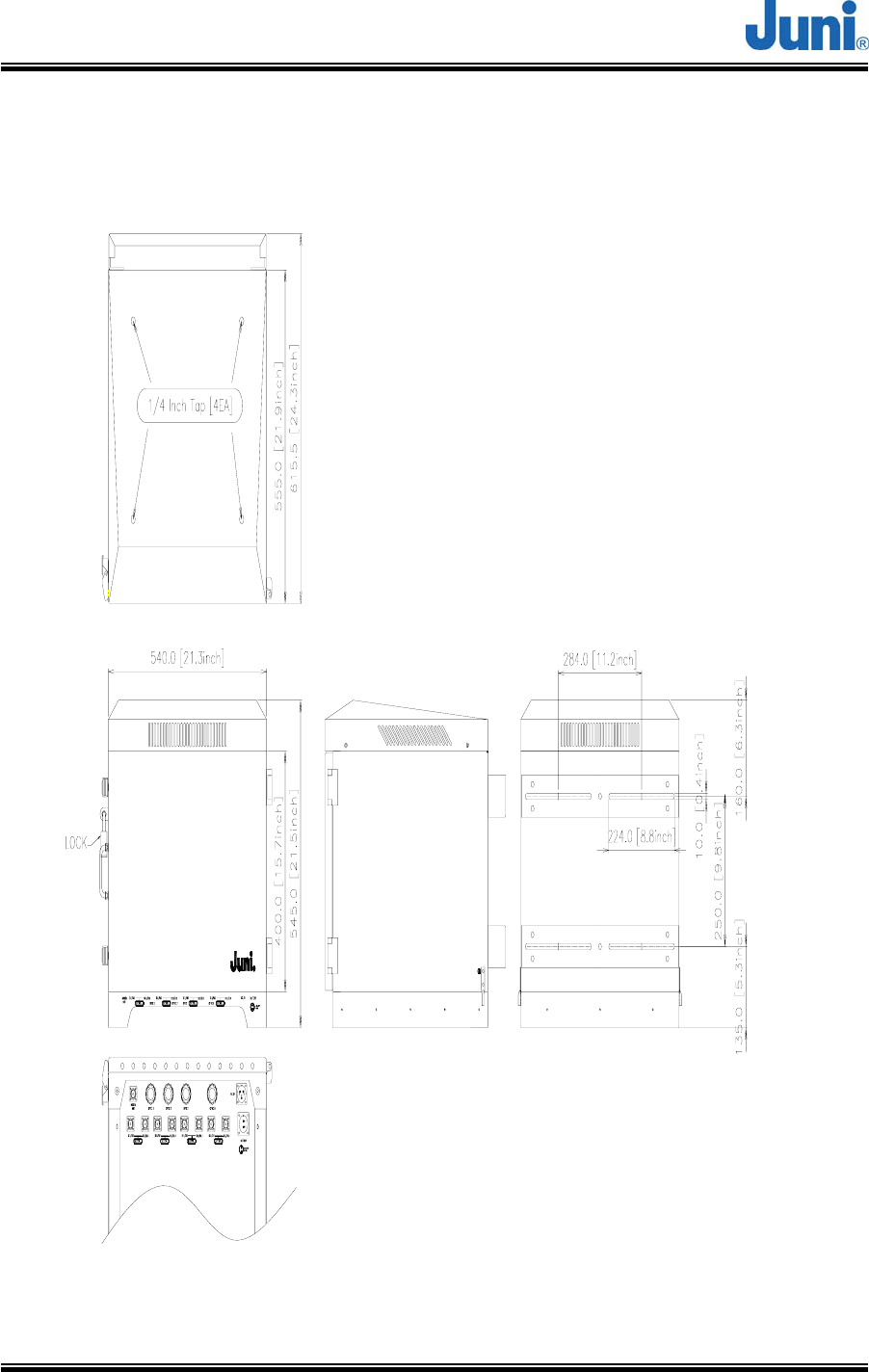
JUNI JF43-E1900/CFN03
CDMA FIBER FED REPEATER OPERATIONS MANUAL
Version 1.17 ⓒ J
uni America Inc. Page 80 of 88
Appendix A. JF-43 Mechanics
1. Donor Unit
[Figure A1.1] Donor Unit
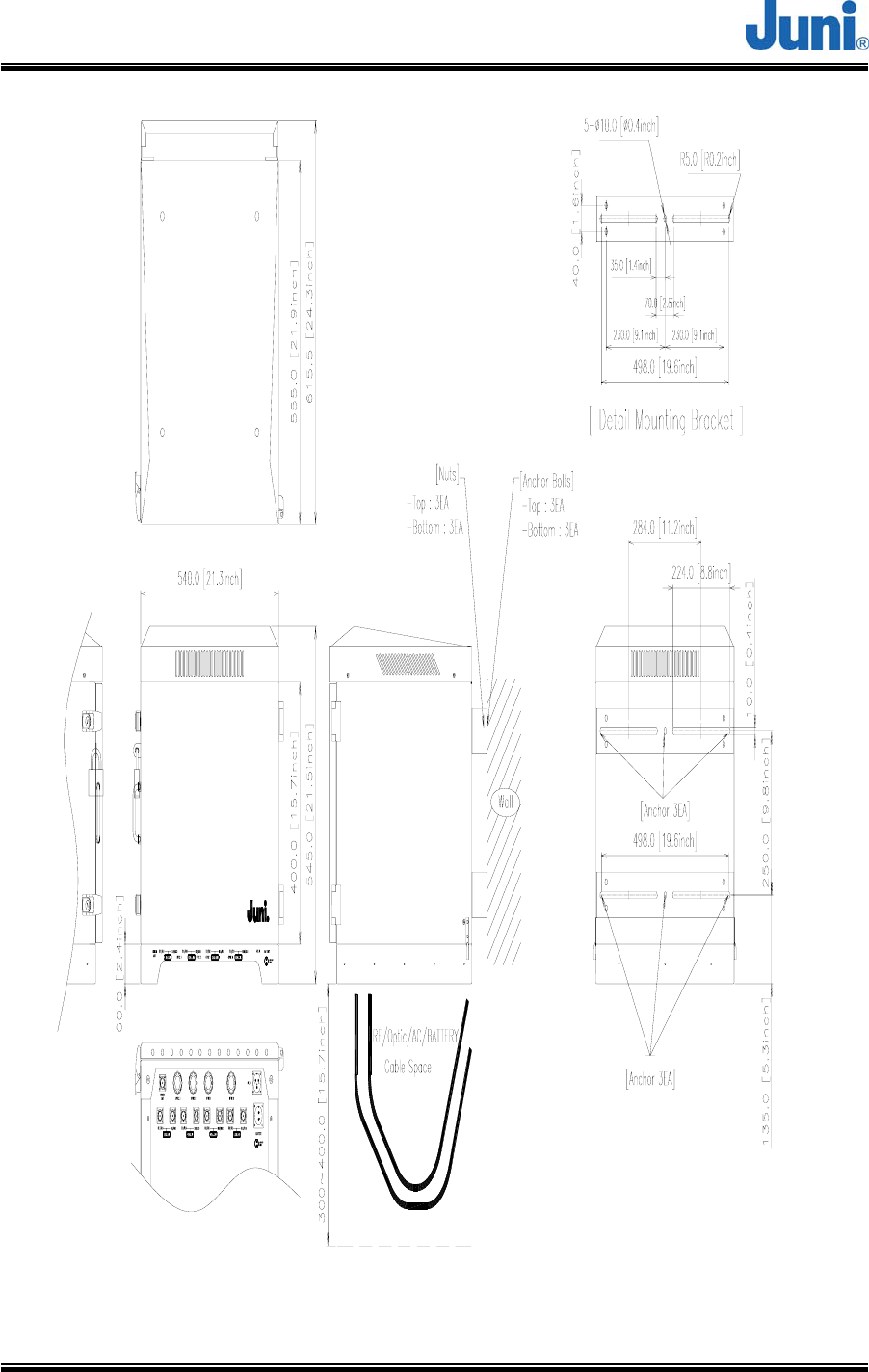
JUNI JF43-E1900/CFN03
CDMA FIBER FED REPEATER OPERATIONS MANUAL
Version 1.17 ⓒ J
uni America Inc. Page 81 of 88
[Figure A1.2] Donor Unit Wall Mounting
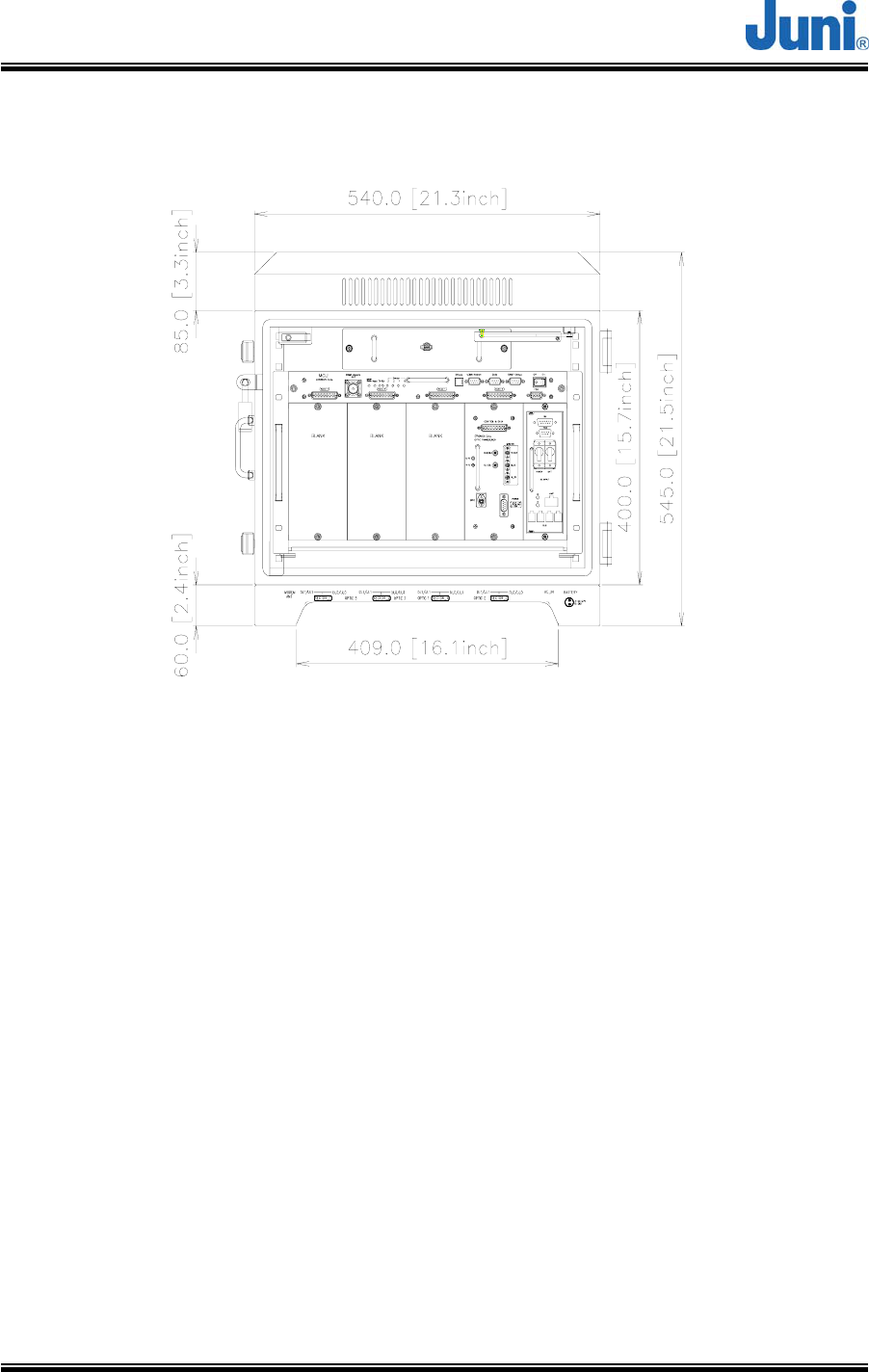
JUNI JF43-E1900/CFN03
CDMA FIBER FED REPEATER OPERATIONS MANUAL
Version 1.17 ⓒ J
uni America Inc. Page 82 of 88
[Figure A1.3] Donor Unit Front View
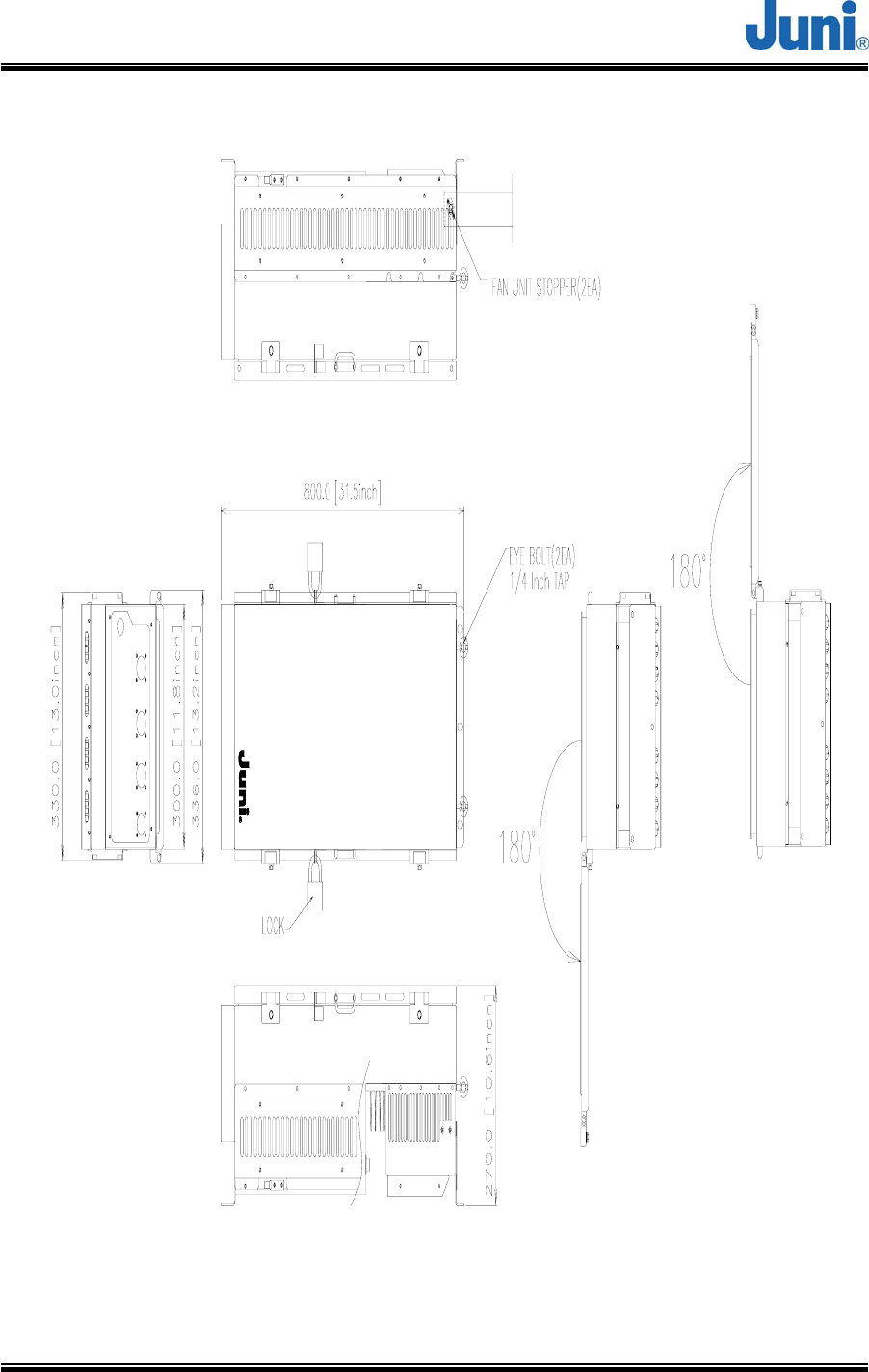
JUNI JF43-E1900/CFN03
CDMA FIBER FED REPEATER OPERATIONS MANUAL
Version 1.17 ⓒ J
uni America Inc. Page 83 of 88
2. Remote Unit
[Figure A2.1] Remote Dimensions
OPTIC
BATTERY
UL_1 AC_IN
DL/UL_0
AC_INUL_1BATTERYOPTIC DL/UL_0 AC_OUT
Remote Unit
(20W)
FAN UNIT
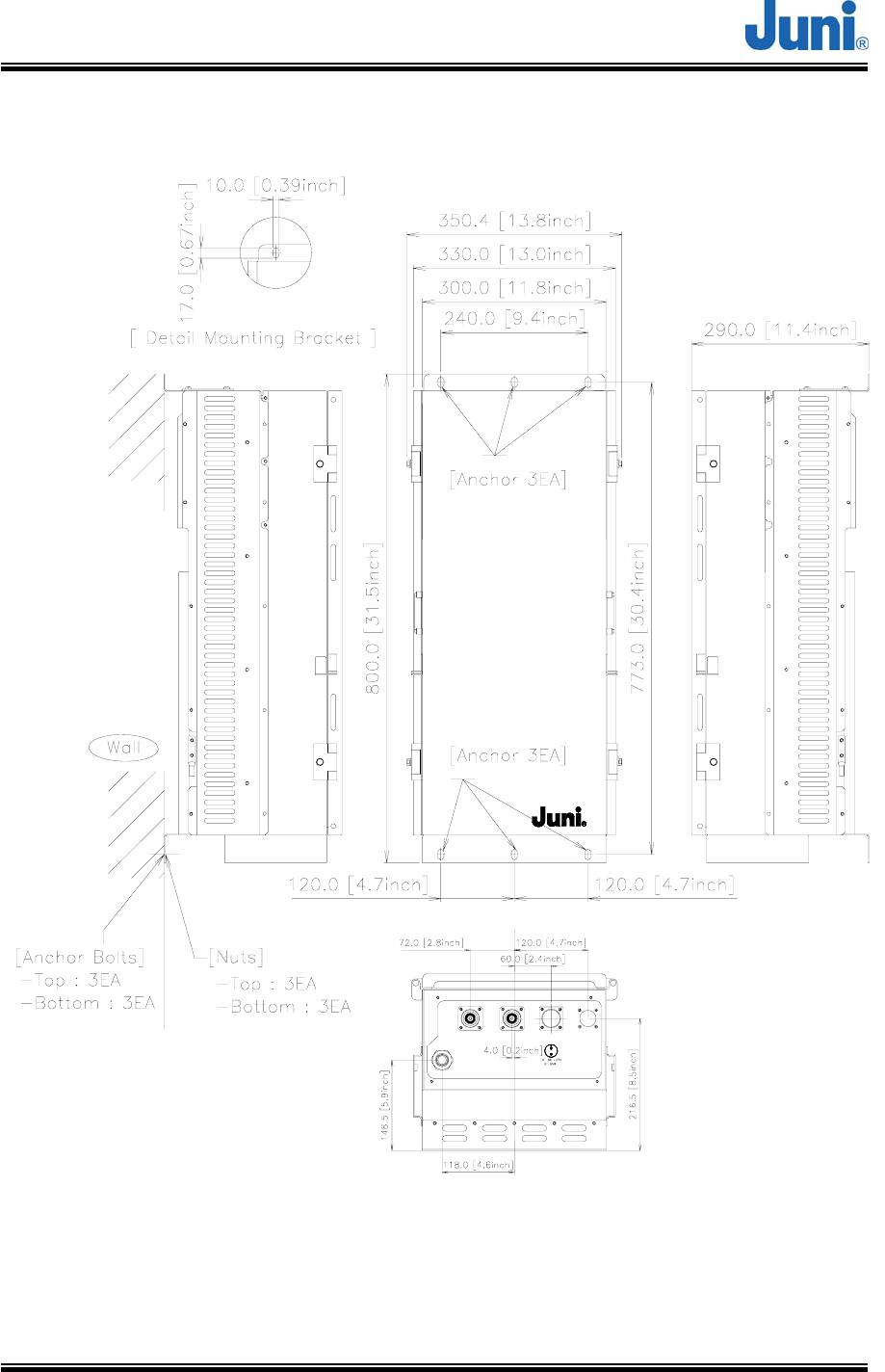
JUNI JF43-E1900/CFN03
CDMA FIBER FED REPEATER OPERATIONS MANUAL
Version 1.17 ⓒ J
uni America Inc. Page 84 of 88
DL/UL_0
OPTIC
UL_1 AC_IN
BATTERY
BATTERYOPTIC UL_1 DL/UL_0 AC_OUTAC_IN
[Figure A2.2] Remote Unit Wall Mounting
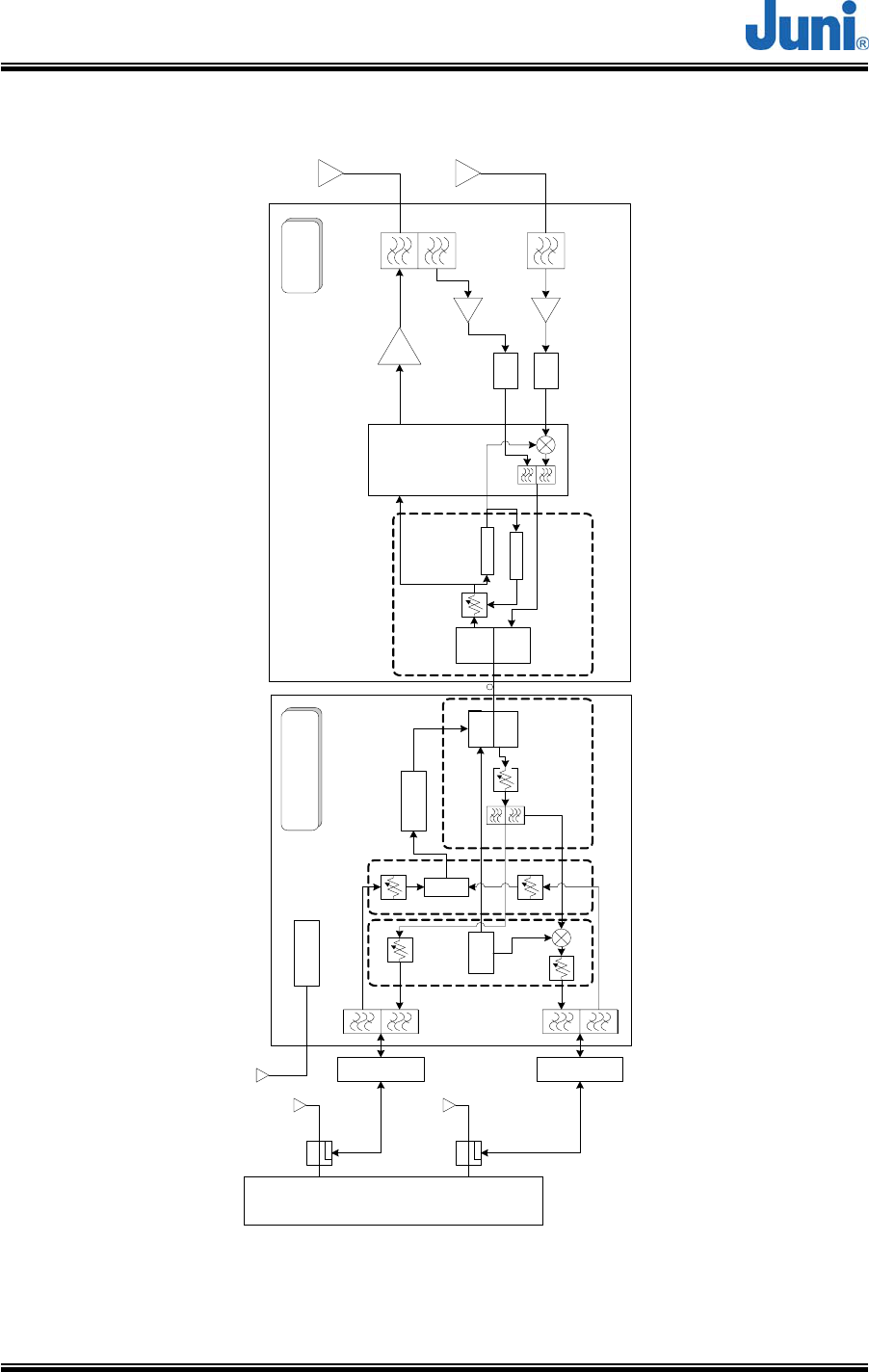
JUNI JF43-E1900/CFN03
CDMA FIBER FED REPEATER OPERATIONS MANUAL
Version 1.17 ⓒ J
uni America Inc. Page 85 of 88
Appendix B. Block Diagram
TX0/RX0
TX1/RX1
BTS
BTS Ant.
-30 or -20dB
BTS Ant.
D/C
D/C
Cable Loss
-1 ~ - 5dB
TX1
Duplexer
Optic
O/E
(LD)
E/O
(PD)
Remote
PA
LNA
LNA BPF
BPF
Optic AGC
-30 or -20dB
Duplexer
RX1
TX1
O/E
(LD)
E/O
(PD)
AGC(LD,PD)
SAW
Donor Optic Cavi ty
SAW
SAW
Modem
Modem Ant.
Local
p-Det
T/RX Drive
RX
Att.
Att.
Local
Com.
TX
RX1
Optic
Combiner
(-10dB)
Combiner
(-10dB)
[Figure B1.1] System Block Diagram
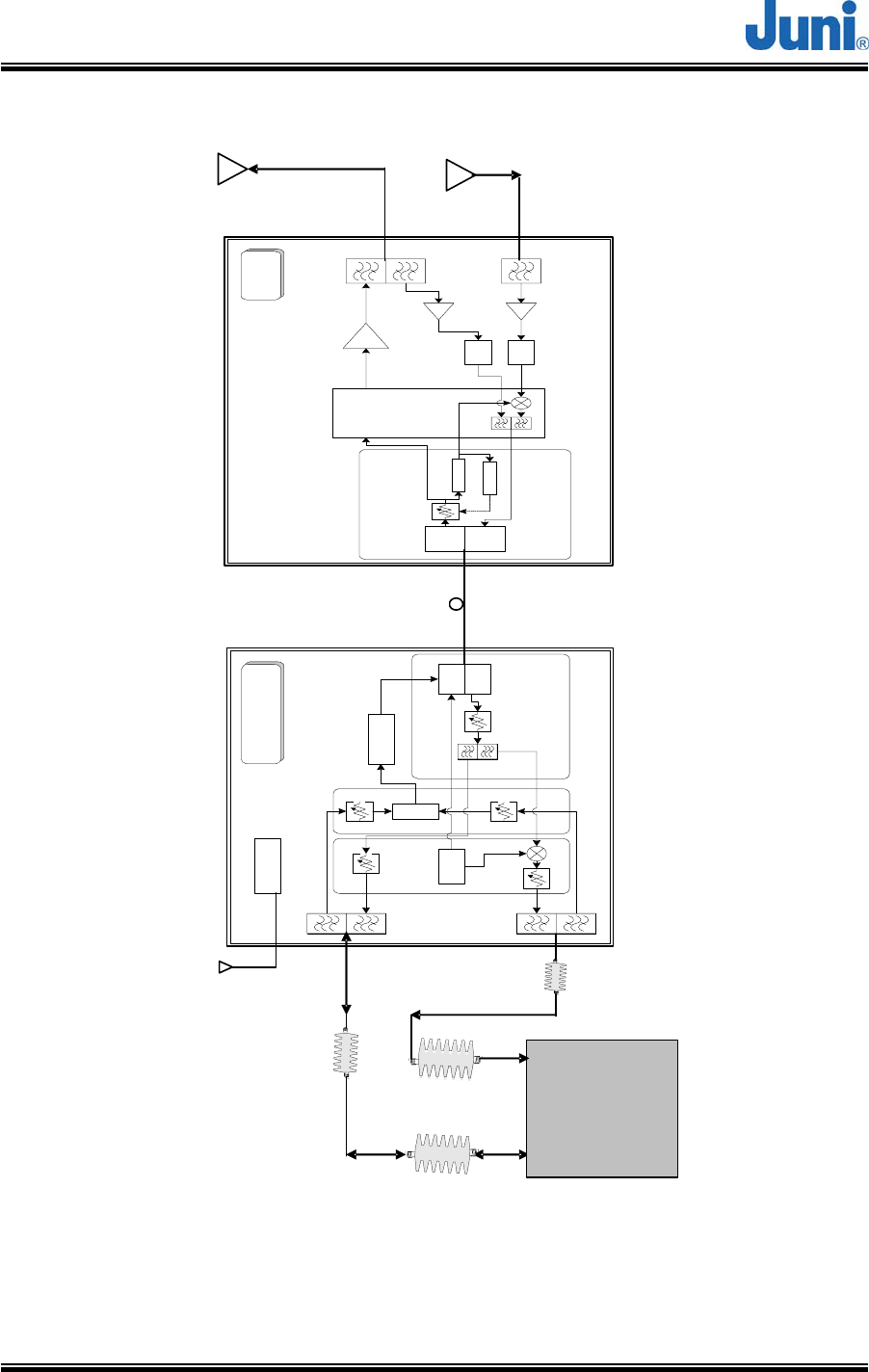
JUNI JF43-E1900/CFN03
CDMA FIBER FED REPEATER OPERATIONS MANUAL
Version 1.17 ⓒ J
uni America Inc. Page 86 of 88
Remote
PA
LNA
LNA BPF
BPF
Optic AGC
SAW
SAW
Local
p-Det
T/Rx Drive i
Optic
RU Output
+43dBm
Tx/Rx0 Antenna
RU Input
-95dBm
LP A Gain
45dB
LNA Gain
30dB
Rx1 Antenna
BTS
Tx0/Rx0
+47dBm
TX1
Duplexer
Optic
Duplexer
1
TX1
O/E
(LD)
AG C (LD,PD )
SAW
Donor Optic Cavity
Modem
RX
Att.
Att
Local
Com.
TX
RX1
Modem Ant
DU input
+10dBm
BTS
Rx1 BTS
Input
-90dBm
DU Output
-53dBm
Cable loss =
DU-BTS-1dB
Line ATT 1dB
High
Power
ATT
30dB
Cable loss =
BTS-DU-1dB
Line ATT 6dB
(
[Figure B1.2] Donor Unit BTS Output Power Value of +47dBm
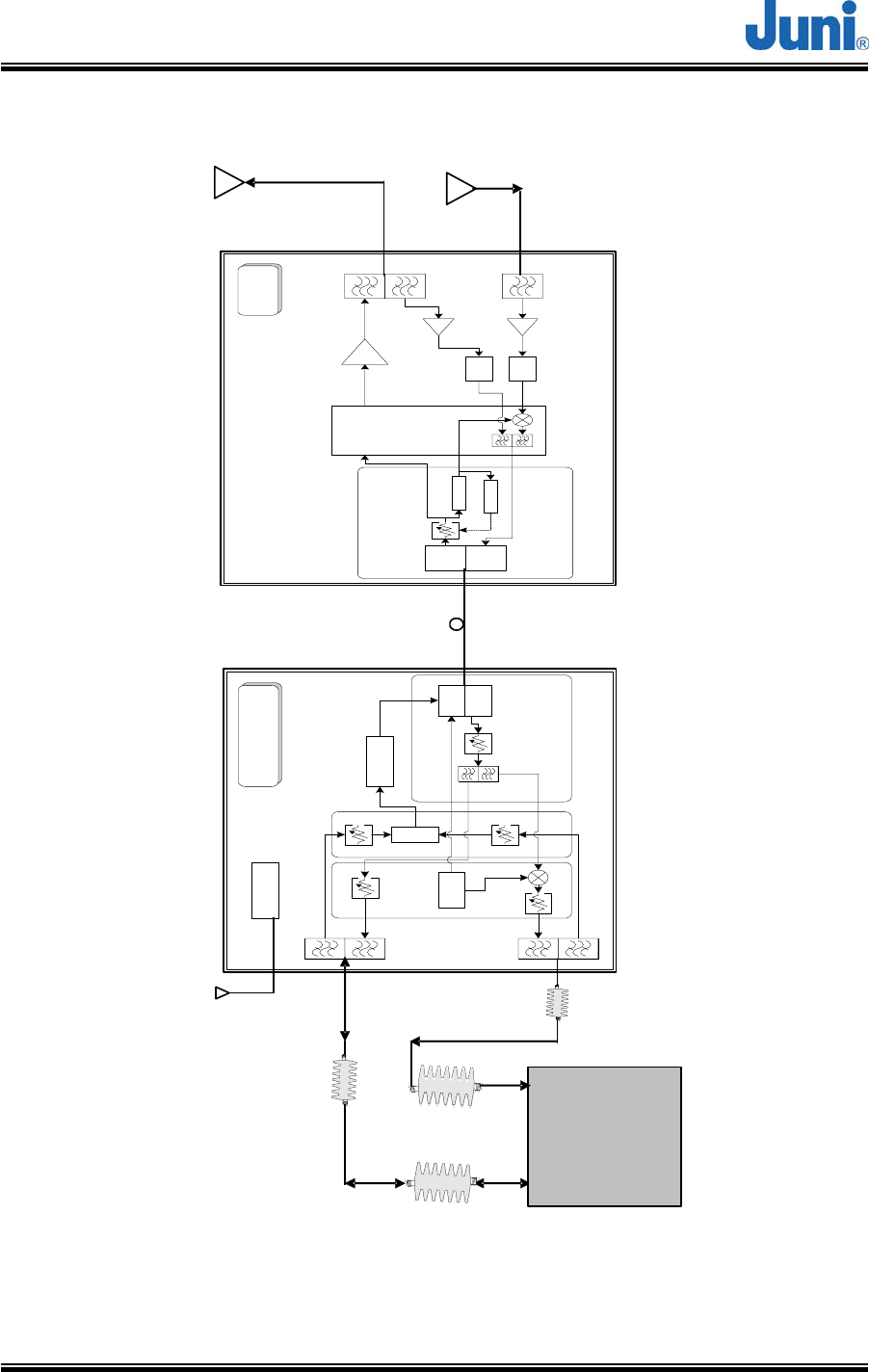
JUNI JF43-E1900/CFN03
CDMA FIBER FED REPEATER OPERATIONS MANUAL
Version 1.17 ⓒ J
uni America Inc. Page 87 of 88
Remote
PA
LNA
LNA BPF
BPF
Optic AGC
SAW
SAW
Local
p-Det
T/Rx Drive i
Optic
RU Output
+43dBm
Tx/Rx0 Antenna
RU Input
-95dBm
LP A Ga in
45dB
LNA Gain
30dB
Rx1 Antenna
BTS
Tx0/Rx0
+42dBm
TX1
Duplexer
Optic
Duplexer
1
TX1
O/E
(LD)
AG C (LD,PD )
SAW
Donor Optic Cavity
Modem
RX
Att.
Att
Local
Com.
TX
RX1
Modem Ant
DU input
+5dBm
BTS
Rx1 BTS
Input
-90dBm
DU Output
-53dBm
Cable loss =
DU-BTS-1dB
Line ATT 1dB
High
Power
ATT
30dB
Cable loss =
BTS-DU-1dB
Line ATT 1dB
(
[Figure B1.3] Donor Unit BTS Output Power Value of +42dBm

JUNI JF43-E1900/CFN03
CDMA FIBER FED REPEATER OPERATIONS MANUAL
Version 1.17 ⓒ J
uni America Inc. Page 88 of 88
Appendix C. LVAC Cables and Connectors
Installation Guide (Corning Gilbert)
The installation guide by Corning Gilbert details the process of how to prepare the cable, cut
the stinger of the male connector and the assembly of all the cables and connectors. This
final cable assembly will power the RU for LVAC applications.